Australian
and international
exploratory
performance and
media arts
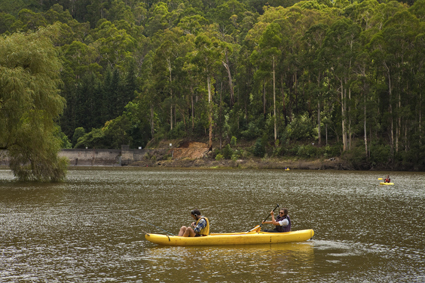
Eric La Casa’s Spirale 4, Bogong Air
photo John Billan
Eric La Casa’s Spirale 4, Bogong Air
FOLLOWING AN OVERNIGHT DELUGE, THE KIEWA RIVER WAS A SWOLLEN BODY OF TURBULENT WHITE WATER. WE STOOD A SCANT METRE ABOVE THE TORRENT ON AN OLD LOG BRIDGE WITH SAX-PLAYING JIM DENLEY, WHOSE WHOLE BODY WAS STRAINING WITH THE EFFORT OF BLOWING AMID THE WATER’S WHITE NOISE. THE WATER HAD GRAVITY ON ITS SIDE, PLUNGING DOWN THE CHANNELS OF THE MOUNTAINS, WHILST DENLEY HAD HUBRIS ON HIS; OR SEEMINGLY SO, UNTIL HIS PARTING COMMENT: “THAT WAS JUST SO WE KNOW HOW PATHETIC WE REALLY ARE.”
This performance was part of the weekend long Bogong AIR Festival of site-specific sound art at Mt Bogong Village in the Alpine region of Victoria, staged by composer Philip Samartzis and his partner Madelynne Cornish, in conjunction with Melbourne’s West Space gallery. Artists included Slavek Kwi, Natasha Anderson, Jim Denley, Rosalind Hall, Alice Hui-Sheng Chang and Dianne Peacock, who all undertook a five-day residency in the lead-up to the festival “in order to develop responses to the acoustic and spatial dynamics of Bogong Alpine Village.”
Mt Bogong is Victoria’s highest peak and has long been a site of significance. The village is situated on the side of a valley and has a sense of the uncanny about it, produced by the unusual mix of natural and artificial elements. The village was built in the 1930s to support the installation of a hydro-electric system while Lake Guy, at the foot of the village, is part of a concealed network of pipes, tunnels, catchments and generators that handle water flows around the system. The buildings of the village were constructed at the same time, and are now largely empty outside of tourist usage: perhaps this produces something of the ‘ghost town’ feel.
Site-specific audio has recently been featured at the Rolling Stock event in Junee, NSW (RT101) and has also attracted a high public profile with Suzanne Philipsz’s Lost Reflection winning the UK’s Turner Prize. The outdoor performances of Bogong AIR set sound within nature, the tension of this combination heightened by the intense weather conditions, as indicated by Denley’s performance. On the day, the artist invited the audience to his solo piece with a caution that it entailed a 20-minute walk through rain and wind on a slippery path; after a moment’s pause, almost everyone set out to follow him. Indeed, getting wet did not prove fatal and the effort involved gave the experience a stronger character.
In her artist’s talk, recorder player Natasha Anderson remarked on the linking of music and a forest setting—apparently the recorder was a key instrument of the Hitler Youth and playing it in forests part of an ideological idealisation of nature. Anderson’s solo performance at the dam wall seemed unusually disjointed and awkward, but became more interesting in the context of these cultural references.
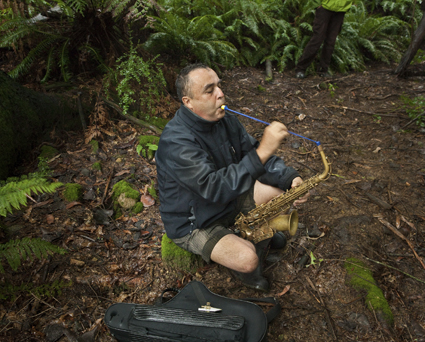
JIm Denley, Bogong Air
photo John Billan
Jim Denley, Bogong Air
Denley and Anderson, Hall and Hui-Sheng performed in pairs inside the vaults of the dam wall creating a satisfying and delicate work that explored the acoustics of the space. In a nearby forest clearing, Denley, Hui-Shang and Hall’s trio performance was curiously enhanced by the drizzle—the strong presence of the elements perhaps evoking something pagan. Architect Dianne Peacock created a video work based on the dam wall architecture, re-projecting it within the space. Interestingly, the creative process of filming functioned as a starting point for Peacock’s imagination, as she re-imagined the monumental dam structure as a concrete skyscraper to be played upon. Eric Le Casa’s composition for canoe, was a gorgeous festival highlight, placing two listeners at a time with iPods in the floating boat. The electro-acoustic composition comprised natural and artificial sounds related to water, responding to the unusual mix of those elements at the site. La Casa’s half-hour composition, if perhaps overly exhaustive in exploring its theme, ranged dynamically across passages of powerful materiality and delicacy, surprising shifts of perspective and intensity.
Visiting from Ireland to present work at the 10 Days on the Island Festival in Tasmania was Slavek Kwi, working under the name Artificial Memory Trace. In his talk, he linked the relatively anarchic space of experimental composition to his upbringing under the strict rules of communist Czechoslovakia; the distinctness of his experience evidenced by the passing comment that he never really got into trouble with the regime, and that the police only confiscated or destroyed his record collection a couple of times! Kwi’s audio brought a musical approach to field recording, utilising repetitive rhythmic material and sounds collected at the site blended with strobe lights and sculptural elements to make a surprisingly theatrical and energizing performance. The artist’s belief in the importance of perception and its role in art gave his work a strongly material quality that was playful and intense.
Curator Philip Samartzis presented Crush Grind, a work using sound and video recordings from a 2010 Antarctic residency. The audio component, previously heard at Heide Museum of Modern Art, features the exceptionally high quality recordings for which Samartzis is known worked together in a fashion that privileges content over process. This time around, Samartzis has included a video componentwherein almost static views of the Australian Base interior (minus people) are featured, with the intent of capturing the visual reality and mundanity of the station, while the high-resolution audio speaks of the scale and intensity of the southern continent. The work offers an intriguing insight into life on base and, ignoring the video, an evocatively crisp and spatially dynamic soundscape.
I hope Bogong AIR happens again and, if it does, you should try to be there. Site-specific sound is a fascinating area of practice that builds on sound’s unique acoustic phenomenology and aesthetics: it was presented here with integrity.
–
West Space: Bogong AIR Festival, festival of site-specific sound art, artists Slavek Kwi, Natasha Anderson, Jim Denley, Rosalind Hall, Alice Hui-Sheng Chang, Eric La Casa, Dianne Peacock, Philip Samartzis, Bogong Village, Victoria, Feb 19, 20; www.westspace.org.au/projects/bogong-air-festival.html
RealTime issue #102 April-May 2011 pg. 40
© Bruce Mowson; for permission to reproduce apply to realtime@realtimearts.net
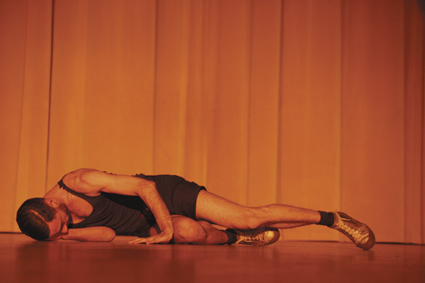
Matthew Day, Thousands
photo Gareth Hart
Matthew Day, Thousands
TO SAY MATTHEW DAY “EXPLODED” ONTO THE AUSTRALIAN DANCE SCENE ALMOST FEELS LIKE AN UNDERSTATEMENT. IT’S ONLY ABOUT 10 MONTHS AGO THAT HE PREMIERED HIS FIRST FULL-LENGTH SOLO, THOUSANDS, AT MELBOURNE’S NEXT WAVE FESTIVAL. IN THE MEANTIME, THE WORK HAS HAD TWO REMOUNTS—AT LAST YEAR’S SYDNEY FRINGE AND AT THE 2011 DANCE MASSIVE. DAY ALSO PREMIERED A NEW WORK, CANNIBAL, AS PART OF THIS YEAR’S SYDNEY GAY & LESBIAN MARDI GRAS. INCLUSION IN SHORT WORK PROGRAMS SUCH AS CAMPBELLTOWN ARTS CENTRE’S DANCE HISTORY AND LUCY GUERIN INC’S PIECES FOR SMALL SPACES HAVE FURTHER CONTRIBUTED TO A SUSTAINED VISIBILITY.
At the recent National Dance Forum in Melbourne, Day spoke on a panel titled “The Next Generation.” As is often the case, though, with artists whose first works create something of a splash, the perception that they have come out of nowhere, materialised from thin air, is deceptive.
“I made my first dance pieces when I was like six,” says Day, now 31. “I made pieces for my sister and my friends all the time. We’d perform them in front of our families. But everybody does that, no? Nothing unusual, really.” Well, maybe not. Slightly more unusual, perhaps, is the fact that Day took up ballroom dancing when he was 15. And not only that: two years later, he and his dance partner, a daughter of world champions, came third in the Australian Championships (youth division) and were crowned Pan Pacific Youth Champions. His career as ballroom dancer, however, finished as quickly as it began when his dance partner decided to change partners. What then?
Day didn’t discover contemporary dance until he was 20, when he first attended the Sydney Dance Company open classes. Once hooked, he decided to pursue dance as a regularactivity and enrolled in the dance course at the University of Western Sydney (UWS) in 2003. After two years he called it quits and continued his studies at the Victorian College of the Arts (VCA) only to leave after the first year and relocate to Amsterdam in 2006. After a bit of a false start, narrowly missing out in the auditions for the prestigious School for New Dance Development (SNDO), Day ended up staying in Amsterdam for three years. In retrospect he considers that time an extremely important formative period.
“I was living in squats, always organising, always trying to make things happen. Pretty much everything was done on a DIY principle.” Together with his close friend, Australian dancer Noha Ramadan, Day put on queer performance events at which they also performed. One of them, Blue Monday, ran for three months, each Monday, and always featured a 10-minute duet by Day and Ramadan, usually performed to a couple of well-known pop songs and often made up only shortly before they went on. The aim of the exercise was to explore “instant choreography.” The premise was that “things didn’t have to be good.” It was more about “unblocking creative powers,” Day says. “Learning serious things while having fun.”
It was in Amsterdam that Day started up a rigorous physical regime consisting of yoga, swimming, running, cycling and strength work. He also spent endless hours in rehearsal studios by himself, developing a solo practice and incessantly reading cultural theory and philosophy with the works of Gilles Deleuze a declared favourite. Day says that what he took away from his Amsterdam years was the need to be resourceful, continuously making do with what was there and not asking for anything else. This lesson, he claims, stood him in good stead when he returned to Australia in 2009 to establish himself as an independent dance maker.
Shortly after his return, Day applied to the Next Wave Festival for inclusion in their 2010 program. His application was successful and in the following year he presented his solo Thousands. That’s when things started to take off for him. Thousands was largely received positively by critics, peers and audiences, drawing praise for its conceptual and physical rigour. Even though he had occasionally performed solo in the past, Day clearly considers Thousands his solo debut. “I would say Thousands is my first album,” he laughs. “I might have made a few singles along the way.” And how does he feel about the increased interest in his work? “It’s exciting. I’m aware that it’s partly because I’m new on the scene. But the interest in my work definitely makes me more interested in what I do and keeps me committed.”
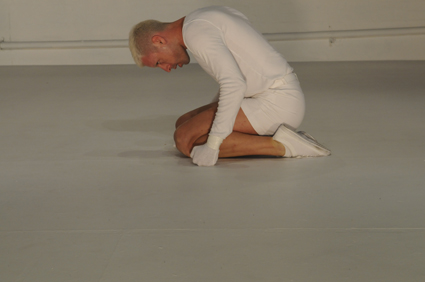
Matthew Day, Cannibal
photo Gareth Hart
Matthew Day, Cannibal
After presenting Cannibal, his second full-length work, in Sydney earlier this year, Day is scheduled to start work on a new piece in October, which, together with its predecessors, will form a three-part series. Day sees Trilogy as an opportunity “to look at the same questions from different perspectives. What all these works will have in common is my interest in exploring the body as a site of infinite potential and constant transformation, creating intensely physical states of continual becoming.” The construction of Trilogy, Day says, is based on the idea that each piece evolves from questions produced by the previous one. Where Thousands, for example, explored microscopic movement, having Day’s body moving extremely slowly for an extended period of time, Cannibal presented the body in continual pulsing repetition, traversing the space. Day expects the third piece in the series, as yet untitled, to be somewhat more energetic, maybe euphoric even. “It’s some kind of release I’m after.”
Day thinks of his works as “operative rather than representational.” He explains: “It’s as if some kind of operation is taking place. The focus is on what is happening, not what does it mean? My choreography is not interesting as such, it works through its accumulative effect and how it unfolds over time.”
Judging by Thousands and Cannibal, both staged with great attention to detail in terms of their ‘look,’ it seems Day prefers a minimalist aesthetic. “Yes. I have always liked the analogy of shooting a gun with a silencer. The effect is just as powerful but it makes less noise. I like understatement. I like subtlety. At the same time I am interested in intensity and extremity.”
What is striking when listening to Day speak about his work is how articulate and assured he is. He exudes the quiet confidence of someone who knows he has done the hard yards and that the attention bestowed on him is the result of what he has invested to achieve it. It is easy to imagine that Matthew Day is in dance for the long haul. He is practically bursting with ideas: “Eventually, I would like to make duets and group works. I’d also be interested in creating a durational performance installation and possibly even curating a gallery event that brings together works by performance makers and visual artists.”
For the time being, however, Matthew Day is going to stick with the solo form: “There is an increased responsibility when working with others. I feel I need more space and time to myself so I can become clearer and find out more about my choreographic concerns. And also,” he smiles and for a moment it looks as if he is a little surprised by what he is about to reveal, “I have the feeling, I can’t put my finger on it yet, that further down the track there is a solo which I’m not yet ready to make.”
See also Pauline Manley’s review of Cannibal, and Keith Gallasch’s review of Thousands.
RealTime issue #102 April-May 2011 pg. 30
© Martin del Amo; for permission to reproduce apply to realtime@realtimearts.net
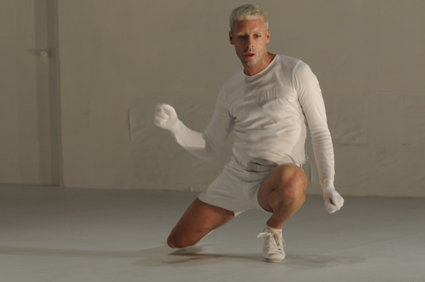
Matthew Day, Cannibal
photo Heidrun Löhr
Matthew Day, Cannibal
IT’S A SHAME THERE IS NOT MORE DANCE LIKE THIS: DIRECTLY IMPACTING, ABSTRACT, VISCERAL AND EVISCERATING, ATMOSPHERIC, FLESHY. CANNIBAL IS SO MATTHEW DAY; IT COULD NOT BE ANYONE ELSE’S. BUT IT IS NOT IMPENETRABLE OR SOLIPSISTIC. ON THE CONTRARY, ITS REVELATION OF THE PERFORMER IS A MOTIONAL ACT OF HUMILITY THAT SEEKS TO DISCOVER, NOT DISPLAY DANCE. THIS IS A DANCER I CAN KNOW WELL FOR A LITTLE WHILE AS HE RIDES THE WAVE OF TRANSCENDENT INTENSITY THAT IS CANNIBAL.
The work is Day’s second solo in a trilogy which “explores the body as a site of infinite potential and constant transformation” (program note). He is interested in “extreme physical states” and while the first solo Thousands (RT100) investigated the possibility and detail of stillness, this development explores unceasing and relentless motion.
In a white, white space lit brightly whiter, the dancer also clad in white begins to twitch. Presenting his back, his peachy, twitching buttocks enact a molten and bubbling genesis. It starts so small it is an almost-stillness. Other muscle groups join in with the gluteals, irritating each other, creating a variegated body, but also synchronising a symphony of small movements that fire other movements.
In the asylum whiteness, sound rumbles from behind and underneath, thickly shaking the space, vibrating this place with almost un-nameable, almost disturbing atmospherics: ominous, distant, mighty. My flesh is agitated into an empathetic twitch. Relentless sonic drives become horsey cloppings, rumbles ooze into circular metallic rubs that sit on top of softly thunderous sweeps, making me edgy, slightly nervous.
The powerhouse buttocks have sent the head into a deeper and more frenzied bob that makes it disappear behind its own body to leave the back monstrously rounded: a mountain with arms. The twitches have become sinking jabs and the dancer is joined by three shadows dancing grey on the white wall. They are whispers of the real dancer revealing that this monstrous back has a front, as Day resolutely ignores us, showing us his shell.
The twitch has matured. What was buried deep now becomes asymmetrical: larger, longer, smoother, casting its energies outward. A sequential patterning is revealing itself. It is this softly held crafting, this delicate understanding of emergent design, this love of scored improvisation that will save Cannibal from any hint of self indulgence. Segments originate, develop, alter and morph into sequences that develop their own personality. But all remain connected as if with a pulsing thread, each moment is part of the whole, each moment born of the one that came before, each moment only made possible by the work’s self-generating history. While Cannibal accumulates itself moment by moment, it does not build predictably to crescendo. It waves, weaves and wavers. Sometimes it almost saunters into disappearance.
There is a piquancy in knowing that this performance will never be replicated but Cannibal preserves itself into a meta-history by a knowing of what must be scored, what must be set, to balance and temper the openness. The crystalline patternings of the lights, of the set, of the sound, of the spatial pathway and of the idea allow this performance to fly from solid ground.
Day sweats. This is the moisture of an intensity that never stops, that winds this body through its pathway across and around the asylum. There is never stillness, always the twitch is present as a pulse, a generator, a memory, a trace, a fire, a dance, a rhythm, occasionally a joke. Sweat starts as a shiny bead, it turns into a sheen, a patina of effort, then Day drips and as he heads toward us, his eyes the only truly still part of his being, his face is red with exertion against all the white whiteness and his blood pumped lips are crimson and slack.
I can see a man in effort. I can see dance as an elemental thing, a force of the world, revealing itself.
Matthew Day is not concerned with using the body to represent narrative, yet, as with the best of post modernism, momentary tales and stories nonetheless emerge and fade—not clung to as ultimate significance, but as breathing apertures of fleeting and individuated poetics. The play of repetition and variations turns Day into a simian hanging thing, a dance floor diva, a dying runner convulsing with exhaustion, a delirious floor fucker, a stoned ballerina in fourth and, for a moment, he becomes loose legged jive guy as Elvis begins to spasm and dissolve.
Body to body, Cannibal was a silencing event, smashing word and image, making heat on a balmy Sydney night.
Sydney Gay & Lesbian Mardi Gras, Cannibal, choreographer & performer Matthew Day, sound James Brown, dramaturg Martin Del Amo, lighting: Travis Hodgson, PACT, Sydney, Feb 17-26
RealTime issue #102 April-May 2011 pg. 31
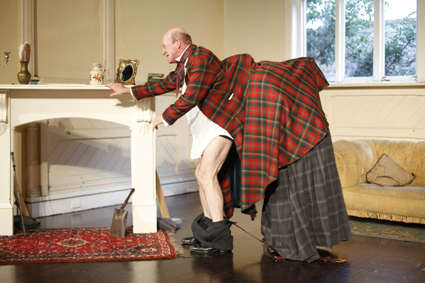
Richard Bligh, Anne Browning, Song of the Bleeding Throat, The Eleventh Hour
photo Ponch Hawkes
Richard Bligh, Anne Browning, Song of the Bleeding Throat, The Eleventh Hour
IN HER 1977 ESSAY “MODERN THEATER DOES NOT TAKE (A) PLACE,” JULIA KRISTEVA SOUNDS THE DEATH KNELL FOR THEATRE AS A PLACE OF COMMUNALLY CONSTRUED MEANING, AS IT MAY HAVE BEEN FOR THE GREEKS AT LEAST. “MODERN THEATER NO LONGER EXISTS OUTSIDE OF THE TEXT,” SHE WRITES, AND WHILE SUCH A STATEMENT MAY SOUND ODD GIVEN THE FERTILE FIELD OF NON-TEXT-BASED THEATRE THAT HAS FLOWERED IN SUBSEQUENT DECADES, KRISTEVA’S POINT IS THAT THE PROBLEM OF LANGUAGE—OR ITS ABSENCE—HAS TAKEN THE PLACE OF THE SHARED SACRED AS THEATRE ONCE EMBODIED IT.
It’s impossible to think about the most recent productions by Angus Cerini and The Eleventh Hour without considering their relationships to language. Both are intensely written, almost manic embraces of the wild possibilities of words; both, too, subject the idea of theatrical language—the grammar and vocabulary of performance itself—to a rigorous pummelling. Yet while each offers a provocative feat of linguistic acrobatics, their end results are of quite a different order.
the eleventh hour: song of the bleeding throat
The Eleventh Hour has long displayed an admirable ability to excavate the depths of canonical texts; rather than dressing up old works in frilly new garb, the company’s best work drills deep into the possibilities suggested by the plays themselves and returns to us these unearthed discoveries in intriguing, engaging assemblages. Song of the Bleeding Throat is a first for the group: an original play written by regular company member David Tredinnick and produced with the same incisive attention to detail which has marked Eleventh Hour’s previous adaptations.
Tredinnick’s script is a tissue of quotations, to steal Barthes’ phrase; a dense interweaving of historical sources and fictional dialogue staffed by an array of real and imagined figures giving voice to these borrowed lines. Its first half centres on the domestic world of Thomas Carlyle, here a buffoonish caricature whose foils include an anxious, narcotic-ridden wife and a deadpan dog with natural urges that threaten his master’s preferred life of the mind. The often troubling philosophical rants of this key proto-modern man—tracing thought-paths of colonialism and individualism—are thrown into relief by his painful constipation and the constant trips to the toilet; this vein of scatological humour runs throughout the work.
The second half of the work presents us with Abraham Lincoln on his deathbed, visited by his assassin John Wilkes Booth and poet Walt Whitman. Again, these historical figures are turned inside out, becoming mouthpieces for racist comedy, ironic self-promotion or a trembling instability of character. It’s reminiscent of a fine tradition of American post-war fiction that tears the guts out of similar iconic personages and repackages the corpses as excrement-stuffed scarecrows—an irreverence that here makes for provocative and entertaining viewing.
It doesn’t always work, though. The sheer dexterity of the wordplay makes great demands of its audience, and at times ideas are lost in the barrage of language. Director Brian Lipson frequently plays up the carnivalesque pyrotechnics of the production’s physical and visual aspects while obscuring the intellectual threads that wend their way through the script; ultimately we find ourselves scratching at the wall of words to glimpse what, if anything, might lie beyond. The rewards aren’t obvious, but that stymied search for something of value might just be the point. It’s certainly a memorable struggle.
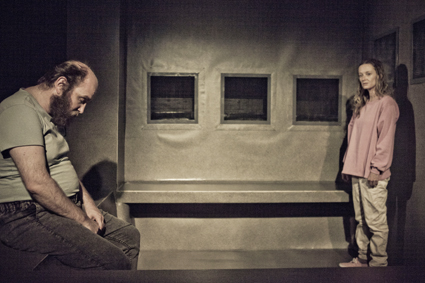
Ben Grant, Peta Brady, Save For Crying
photo Vikk Shayen
Ben Grant, Peta Brady, Save For Crying
angus cerini: save for crying
As linguistically gymnastic but far less confounding, it took me some days to recover from Angus Cerini’s Save For Crying, easily one of the most impactful productions I’ve witnessed at La Mama. Just as unexpected was a realisation that this astonishing, sui generis work is still recognisably a play: there’s a strong narrative arc, distinctive characters, a unity of place and constancy of thematic concerns. At the same time, not a single element of this work seems an unconsidered legacy of any theatrical tradition; those elements which may resemble classic theatre-making are anything but conventional, instead appearing as if invented for the first time.
Luv and Alfie (Peta Brady, Ben Grant) are a straggle-haired and blank-eyed pair living in some squalid nook; daily they venture out to try to raise a few dollars for a meal and are regularly terrorised by the vicious Ratspunk (LeRoy Parsons) who relieves them of their money while abusing and degrading them. All the while they speak a curious pidgin, a language of abbreviated or reconfigured phrases with its own musical cadences.
So far, so Pinter. Alfie and Luv’s precise situation is never made obvious. There are strong hints of disability, but also suggestions of institutionalisation, mental illness, homelessness and addiction. Ratspunk’s nature is equally problematic—petty thug or shared projection? State sanctioned overlord or evil angel? He’s a fascinating character. He wears a shiny headdress of black feathers which is both menacing and ridiculous; as a figure of violent power, he is also ironically someone just as oppressed as his victims. To complicate matters he is played by an Indigenous actor. But Ratspunk uses his blackness as a weapon—his marginalisation is recognised, which puts him in a more potent position than those who can’t define their own disadvantage.
Cerini takes us far beyond the confines of Pinter, however; just as comparisons with Beckett or Ionescu prove limiting here. The intricate, carefully constructed language of the piece works not to alienate its audience or make strange this world but something rather opposite. Its rhythms and odd logic bring us into this world rather than situating us as cold observers. While the diction leaves us unable to locate the exact circumstances of Luv and Alfie’s predicament, it’s in this that we become more like them. There’s a little humour in the piece, but for the most part it’s a deeply humanist love story centred on the heart-rending connection between two people. They’re not outsiders. There is no outside.
Lighting, set and costume are all exquisitely accomplished here, creating a perfectly formed world from the inside out. So too does Cerini’s direction possess its own well-executed grammar. Violence is represented through sound rather than direct action; sexual violence through stylised postures. Both are even more terrible for what isn’t shown.
Where Song of the Bleeding Throat tears pieces from a history of discourse and pastes them together to produce a burlesque of the act of speaking itself, Save For Crying comes closer to building language from almost nothing. One is deeply, darkly critical, while the other is constructive and, in its way, animated by a fierce hopefulness. Eleventh Hour’s work seems to me closer to the profane—a reminder that the language of great thinkers and men of state is not that of the mundane world we live in. Perhaps more interesting to me is Cerini’s reproduction of the sacred theatre, in which through the act of watching—individually and communally—we share in the meanings of what we see before us.
The Eleventh Hour, Song of the Bleeding Throat, writer David Tredinnick, director Brian Lipson, performers Richard Bligh, Anne Browning, James Saunders, Neil Pigot, design Brian Lipson, Alexis George, costumes Alexis George, dramaturg William Henderson, lighting Niklas Pajanti, Nicola Andrews; Eleventh Hour Theatre, Jan 27-Feb 12; Save For Crying, writer, director Angus Cerini, performers Peta Brady, Ben Grant, LeRoy Parsons, lighting Rachel Burke, set & costumes Marg Horwell, composer Kelly Ryall; La Mama Theatre, Melbourne, Feb 18-Mar 6
RealTime issue #102 April-May 2011 pg. 33
© John Bailey; for permission to reproduce apply to realtime@realtimearts.net
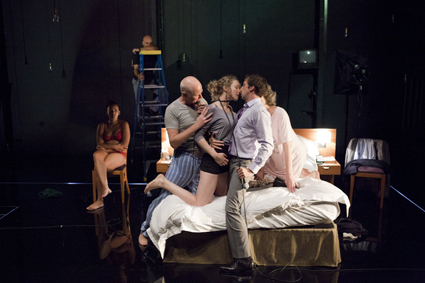
BeforeAfter
ACROSS 51 SHORT SCENES GERMAN PLAYWRIGHT ROLAND SCHIMMELPFENNIG CONJURES A COSMOS FROM AN EXPLODING LIGHT GLOBE—LIKE THAT FAMOUS BUTTERFLY IT TRIGGERS CYCLONIC, EVEN QUASI-SPIRITUAL REPERCUSSIONS LIGHT YEARS AWAY, BUT IN THE ROOM NEXT DOOR TOO, IN THE SAME HOTEL, WHERE RELATIONSHIPS FALL IN AND OUT OF SYNC AND SOLO LIVES HANG ON FOR DEAR LIFE. BEFOREAFTER PLAYS OUT LIKE HUMANISED CHAOS THEORY. WHEREAS ITS NEAR KIN, BOTHO STRAUSS’ BIG AND LITTLE SCENES (COMING TO THE STC THIS YEAR), LARGELY TRACKS THE LIFE OF ONE WOMAN, LOTTE, BEFOREAFTER IS MORE DIFFUSE, MORE CHAOTIC—A SERIOUS CHALLENGE FOR DIRECTOR, DESIGNERS AND PERFORMERS.
The moment of panic experienced when the globe shatters is made analogous with the disgust at seeing oneself naked in a mirror or the shock of realising you’re on the edge of infidelity or, more quietly, with having to face one’s aloneness late in life and trying to put it into perspective. These and other trains of thought are densely woven in BeforeAfter if loosened by the play’s episodic construction—you have to pay attention. But director Cristabel Sved and her design team have a very good go at keeping themes focussed and creating coherence if on occasion letting it unravel with a superfluity of effects. Some work well—actors invade intimate bedroom scenes, wielding cameras and casting close-ups onto the walls, but later the images are huge and ill-defined, their purpose uncertain. The projection of the classic animated cartoon Hoppity Goes to Town (Fleischer Studios, 1941)—about nature invaded by humans—juxtaposes a sense of innocent purpose with the near bizarre complexities of human life (one woman loses weight and height and another’s speech involuntarily speeds up and slows down). Elsewhere the stage is convincingly transformed into a glowing galaxy dancing with suspended and hand-held lights.
The biggest challenge was one only partly met—the tight ensemble playing that a work like BeforeAfter demands. Physically and spatially, actors and director do well enough, realising with agility some 40 characters, but they fail to find a shared voice and common rhythms. The largely brisk, naturalistic delivery gravitated against the play’s strangeness and its peculiar poetry if somewhat compensated for by the production’s various clever design aspects. Doubtless a short rehearsal period for such a large work would not have helped. Nonetheless, the ambitions of playwright Roland Schimmelpfennig and director Cristabel Sved made for an adventurous theatrical experience, and one quite out of the ordinary.
STC Next Stage: BeforeAfter, writer Roland Schimmelpfennig, director Cristabel Sved, performers Annie Byron, Justin Stewart Cotta, Zinozi Okenyo, Johanna Puglisi, Richard Pyros, Graham Rhodes, Sophie Ross, Tahki Saul, designer Justin Nardelle, lighting & audio-visual design Verity Hampson, composer, sound designer Max Lyandvert, choreographer Johanna Puglisi; Wharf 2, Sydney Theatre Co, Feb 4-19
RealTime issue #102 April-May 2011 pg. 34
© Keith Gallasch; for permission to reproduce apply to realtime@realtimearts.net
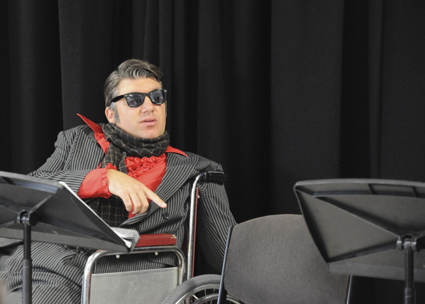
Mikelangelo in rehearsal for Curtains
photo Michael Parry
Mikelangelo in rehearsal for Curtains
THE VICTORIAN ARTS CENTRE’S CARNEGIE 18 PROGRAM PROVIDES FUNDS AND EXPERTISE TO DEVELOP EMBRYONIC WORKS FROM MELBOURNE’S VIBRANT MUSICAL THEATRE SCENE. TAKING ITS NAME FROM THE STAGE OF FOETAL DEVELOPMENT WHEN THE INNER EAR IS FORMED, THE PROGRAM SEEKS NOT ONLY TO PROVIDE A PLATFORM FOR THE DEVELOPMENT OF NEW MUSIC THEATRE, BUT TO QUESTION THE BOUNDARIES OF THE GENRE. IN UTERO, SO TO SPEAK, THE FOUR CARNEGIE 18 WORKS OF 2010—EVERY ANGEL IS TERRIBLE, RAWK, CONTACT! AND CURTAINS—ARE REMARKABLE IN THEIR VENEERS OF COMPLETION AND THE CHALLENGES EACH WORK PRESENTS FOR FUTURE DEVELOPMENT.
contact!
Composer Angus Grant found the ideal subject matter for his operetta Contact! in suburban netball—dramatic, quintessentially Australian and just a little daggy. The cast, consisting of a seven-girl netball team, their coach Bev and her son Bevan, induce a few Eureka moments as the traditional opera elements of chorus, recitative and aria are used to add expressive and humorous emphasis to netball colloquialisms and high school vernacular. The girls incredulously drone “what is she on” at the newly arrived Goth and prodigious goal shooter Daisy, and sing out the game’s ubiquitous “if you need” during simulated netball matches. Wendy, the coach’s daughter, expresses her girl-crush on Daisy in an aria reminiscent of one of Puccini’s early 20th century hits. Even the orchestra is in on the game, suitably attired in netball bibs.
Beyond a humorous subject for tried and tested musical methods, Grant foregrounds the seemingly endless rules of the sport, including the prohibition of contact. It might be said that, beyond the game’s status as a ‘Commonwealth’ sport, its abundance of rules and restriction of contact is what makes it most ‘Australian.’ As such, I would like to see the budding romance between Daisy and Wendy developed further, in stark opposition to Bev and her fixation on football players and teen pregnancy. With further character and plot development to back up Grant’s musical wit, both performers and audiences will be kept ‘on their toes.’
every angel is terrible
In stark contrast to Contact!’s serious music and light-hearted plot, Every Angel is Terrible uses saccharine show tunes to show up the contradiction between society’s sparkling exterior and the persistence of its greatest taboo, filicide. The writers and composers Maude Davey, Sarah Ward, Bec Matthews and Ania Reynolds tell their contemporary fable through Weillian cabaret tunes, Larson-esque choruses and Krieger-like diva moments. The composers are in good company with Weill, whose 1927 “scenic cantata” Mahagonny held up an unflattering mirror to “a public which goes to the theatre naïvely and for fun.” However, unlike Weill’s ‘naïve’ audience, contemporary theatre-goers have a century of challenging theatre behind them and so are largely immured to Every Angel is Terrible’s shock tactics. No great unmasking was apparent when the performers tricked the audience into imagining themselves killing a child and asked rhetorically, “but we wouldn’t do that, would we?” Considering the writers claimed to have no personal experience with filicide, their desire to unmask the killer lurking inside each of us betrays less their ability to see through the façade of our supposedly filicide-oblivious society than just another symptom of our media-driven obsession with it.
The writers’ claim to “listen to the children” comes through appropriately in their retelling of Hansel and Gretel, in which a social worker arrives at the witch’s house where Hansel is being fattened and ignores Gretel’s pleas for help. However, when Gretel bursts forth with her Dreamgirls-like “Everything I say is true” the writers attempt a sincere representation of grief that slips back into the sugar-coated hypocrisy they try to unmask. Overall, the audience seemed divided between those who thought the issue should be addressed and those who thought it should not be addressed in this way, which is not exactly a division. Can this versatile group of composers, aided by the sublime projection art by Cazerine Barry, find a way of telling these stories without resorting to hollow shock tactics and melodramatic musical clichés that only reinforce the voyeuristic gestures of the mass-media? While ‘listening to the children’ is not an option, engaging others whose lives have been directly affected by filicide might be.
rawk
Moving right away from traditional musical and operatic styles, Peter Burgess’ RAWK pioneers the soft metal musical. It tells the story of Tim who takes the message of his anti-capitalist rock-star hero, RAWK, seriously. He quits his job, hits the streets, deals drugs and eventually returns to his former life while RAWK himself exposes his manipulative marketing strategies through a series of acoustic guitar confessionals. The band, consisting of Burgess, Matthew Lewin, Markus Buckley and Arron Light produce a polished soft metal sound reminiscent of those anti-establishment paragons of the 90s, Rage Against The Machine and Tool. Pulling the musical back into the 80s, the melodic strains of Pearl Jam can also be heard in Tim’s more heartfelt moments. While the music is well composed and executed, the lyrics require finessing to give the characters depth. If, as Burgess expressed in question time, he would like to present this fable to school students, then he may need to draw on more 21st century musical influences lest he appeal solely to the two spotty rockers in each year level.
curtains
Hilarious, clever and gripping, David Chisholm’s Curtains–part three of a set of five extended works that “examine lost, dead or decaying musical forms”—is a take on the Broadway musical. Performers Yana Alana, Tina del Twist, Mikelangelo and Meow Meow mill about the stage, occasionally telling the story of, and performing in, a revival concert of the musical Revival in a “Marxist critique of Hollywood and Broadway culture.” No striking point is made about Broadway through the show’s not-completely-non-linear plot. Yes, we know that performers get chewed up and spat out by the entertainment industry. On the other hand, Chisholm’s musical dialectic of synthesised barrel organ representing the culture industry and the Silo string quartet representing the actors’ “humanity” is thought provoking because so insidiously affecting. Deftly bending this unusual ensemble around the Broadway musical style, Chisholm leads the audience to sympathise with Wes Snelling, crooning as Tina del Twist playing Dorothy Day playing a character in Revival. That is, until Yana Alana interjects with “Do you want some ham to go with that cheese?” causing layers of artifice to unravel and re-ravel once more. Constantly renegotiating the audience’s relation to the characters playing characters through layers of storytelling, Curtains traps the audience in a break-neck barrel organ comedy. With improvisation and pre-established characters playing a vital role, it will be interesting to see what is churned out when different sets of performers are fed into Chisholm’s barrel organ entertainment machine.
Taken together, the four works of the 2010 Carnegie 18 series challenge the audience to broaden their notion of music theatre, operetta and cabaret. More importantly, the combination of musical talent and thematic interest in each work provides scope for further development and performance.
Full Tilt: Carnegie 18, New Music Theatre Series, Contact!, composer Angus Grant, libretto Angus Grant, Kate Schmitt; Every Angel is Terrible, composers Maude Davey, Sarah Ward, Bec Matthews, Ania Reynolds, book Maude Davey, Sarah Ward; RAWK, music & book Peter Burgess; Curtains, music & book David Chisholm; Fairfax Studio, Arts Centre, Melbourne, Jan 19-25
RealTime issue #102 April-May 2011 pg. 36
© Matthew Lorenzon; for permission to reproduce apply to realtime@realtimearts.net
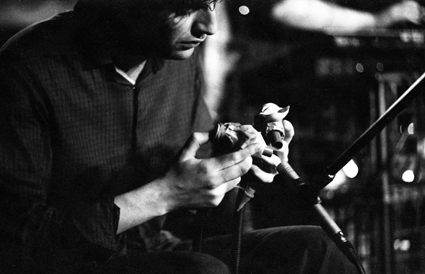
Joel Stern and Sky Needle
film stills Joe Glaysher
Joel Stern and Sky Needle
THE NOW NOW FESTIVAL OF SPONTANEOUS MUSIC IS ALWAYS AN ADVENTURE AND OFTEN MOVES IN UNCHARTED MUSICAL TERRITORY OR, IN THE WORDS OF GUEST MC, SEAN BAXTER, IS “10 YEARS LONG [AND] ALWAYS BRUTAL.” THIS YEAR THE FESTIVAL RETURNED TO THE INNER WEST OF SYDNEY AFTER THREE YEARS IN THE BLUE MOUNTAINS, THE FORMAT CHANGING FROM ONE INTENSE WEEKEND TO SEVEN EVENING CONCERTS OVER EIGHT DAYS (FIVE AT THE RED RATTLER CLUB AND TWO OFF-SITE). THE ENDURANCE REQUIRED FOR THESE PLUS THE MARRICKVILLE AMBIENCE BROUGHT A DIFFERENT EDGE TO THE EVENT AND MARKED THE COMPLETION OF A TWO-TO-THREE YEAR TRANSITION INTO THE SAFE HANDS OF A NEW ORGANISING TEAM.
The festival got off to an excellent start with two very different but fine quartets. First up was Embedded, a new combo with Rishin Singh (trombone), Monica Brooks (accordion), Sam Pettigrew (bass) and Jim Denley (sax/flutes/various extensions) creating an intense concentration of acoustic sound from among the audience. From here the instruments combined to build a remarkable sound mass—frequency ranges coalescing into a group characteristic that provided solid backdrops for the various rebounding staccato effects produced by each player. A vibrating, dense jungle inhabited by Denley’s rubber extensions and Pettigrew’s (strangely loud) application of polystyrene to a resonant bass body combined with high squeaks from Brooks’ accordion and breathy attacks from the trombone to create a mesmeric world of sound.
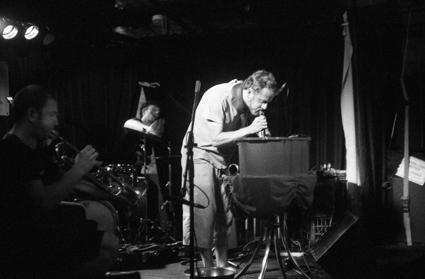
Simon Ferrenci, Reuben Derrick
film stills Joe Glaysher
Simon Ferrenci, Reuben Derrick
Reuben Derrick (NZ), Simon Ferenci, Milica Stefanovic and Evan Dorrian settled into sympathetic communication very quickly with Dorrian and Stefanovich setting a funereal tone with single bass/bass drum strikes before Dorrian’s stickless, free-hand agitations pushed the piece along into more layered textures. At one point the cut-rhythm bass tugged at a funk feel only to be subverted by aquatic textures emerging from the clarinet as Derrick processed it through an amplified bin full of water. The trumpet’s distant calls evolved into a syncopated tussle between the wind instruments only to be replaced by the mournful beauty of a lone clarinet across the rhythm section, all ultimately replaced by Ferenci’s trademark metal-on-metal scraping.
This first night finished with Brisbane’s Sky Needle (Joel Stern, Alex Cuffe, Ross Manning and Sarah Byrne) pressing noise into the service of the song cycle. They misappropriated the form with splendid anarchy and without regard for tradition. All objects played by this group are their own inventions. One instrument was a cross between a bass guitar and a mobile angle grinder and another resembled an African thumb piano/dulcimer combination. Stern’s feet pumped for dear life to produce percussive wind sounds at the end of a couple of tubes and Byrne sounded like an out-of-control Siouxie Sioux. This is surely the future of pop!
On Saturday Peter Blamey was first up, suspending and dropping hair’s breadth copper wire from above onto six or so open circuit boards like some interpretive suicide leap. The circuits screamed and pulsed cataclysmically whilst Blamey sat in Frankensteinian calm extracting music from the incidental noise and discordant pulses occurring deep within the sonic material.
The next night’s highlight was the duet by Tony Buck (percussion) and Magda Mayas (prepared piano). Harmonics seeped from all that they struck, scraped and wrung out producing a luscious ebb and flow of complex layers. Lost in the evocations of this piece, I imagined at one point that I was hearing the everyday sounds of a small town, notated and reproduced in musical form. Eyes closed, I lost track of instrument identity sometimes and had to look back at the stage to understand exactly what was creating these sounds so full of cadence, resonance and melody.
This perception of blurring sonic boundaries between instruments was also a feature of Martin Kirkwood (electronics) and Peter Farrar’s (extended saxophone) set, a couple of nights later. There were sonic ‘illusions’ in this arresting piece wherein goat-calls appeared amid pure machinistic pulses, collapsing the tenor and the electronics into a curious unity. Farrar’s blown sounds, created by various plastic attachments and insertions, brought the integrity of the saxophone into joyful disrepute by creasing bits of drink bottles and other flotsam into vibrating buzzes and moans. Conversely Kirkwood’s pedals and boxes, some looking like a home electronics project, often achieved notes of pure acoustic clarity.
At the louder end of the music discourse was Melbourne drummer Sean Baxter demonstrating what he meant by sonic brutality with his renowned floor tom and feedback work (night five at Serial Space) which utilised various metal scraps bent and tortured by Baxter to both provoke and subdue varying levels of PA feedback. The following night he joined Hermione Johnson (piano), NZ’s Jeff Henderson (sax) and Mike Majkowski (double bass) on the Red Rattler stage with his full kit in a breakneck romp that turned up the temperature further in Marrickville’s summer steam. Following this on Friday we were treated to Scandinavian trio The Thing who are Mats Gustafasson (tenor & baritone sax), Ingebright H Flaten (double bass) and Nilssen-Love (drums). They took off from zero to hit full-speed a split-second later. In both these bands the listening was deceptively intense between the players. Walls of sound came at you with playing that was flat out but which dispersed incongruously until only remnants of the original energy remained. Accelerating unison playing and seamless tempo shifts attest to the level of attention these players exercise.
But for me it was the collaboration on night five, AV, between Norwegian Kym Myhr (guitar, autoharp and various electric devices and extensions), Sam Pettigrew (bass & extensions) and Nick Shimmin (film curation) that produced the most finely tuned and sensitive playing of the festival. Swedish filmmaker Gunvor Nelson’s “personal” work, True To Life contained macro probings of a variety of plant-life and exchanged background/foreground positions with the musicians. The music seemed to move between creating a dramatic and foreboding soundtrack while at other times itself becoming the subject of strange narrative contexts evoked by the abstracted images. Listening by players and audience alike was perceptible and Myhr and Pettigrew’s acute sensitivity within their sound world was intriguing. It created a piece that explored an extraordinary dynamic range and compositional awareness as autoharp arpeggios, a ringing bowl and the strategic placing of small electric motors against a variety of resonant and pitched objects played within and across the assertions of Pettigrew’s fingering and long bowing bass sequences.
Earlier in the night there were some fine AV co-ordinations from Aemon Webb and Jon Watts which were as different from John Blades’ multimedia narratives on Saturday as those narratives were from the spoken mythic inventions of Gerard Crewdson (NZ) on Monday at the Camperdown concert. From the sinewy progressions of the trio Roil on Saturday to the exquisite minimalism of Thursday’s sampling trio Jason Kahn (Canada), Adam Sussman and Matt Earle, the Now Now 2011 was an exciting week of music and the range of noise presented was wide as always and of course, the Splinter Orchestra played a set too!
the NOW now 2011, curators Laura Altman, Mike Majkowski, Sam Pettigrew, various locations, Sydney, Jan 21-28; www.theNOWnow.com
RealTime issue #102 April-May 2011 pg. 38
© Tony Osborne; for permission to reproduce apply to realtime@realtimearts.net
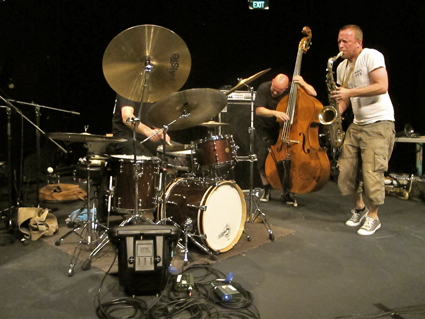
The Thing, SoundOut 2011
photo Yasmin Masri
The Thing, SoundOut 2011
SOUNDOUT IS THE NEW-KID-ON-THE-FESTIVAL-BLOCK, BUT BY NO MEANS UNFORMED IN TERMS OF AGENDA. WHILE OTHER FESTIVALS MAY NOW TAKE IN INFLUENCES FROM A RANGE OF MUSICS WITH EXPERIMENTAL FRINGES (POP, FOLK, BEATS), SOUNDOUT DIRECTED BY RICHARD JOHNSON, IS UNCOMPROMISING IN ITS PURE PURSUIT OF MUSIC IN THE MOMENT, SOUGHT THROUGH FREE JAZZ AND IMPROVISATION.
Johnson has established a rigorous structure in which 20 artists play in a range of groupings for a total of 16 hours over two days. If you attended the entire festival (which I, the artists, and a few dedicated punters did) you were treated to seeing the same people perform up to five times. The original programming, promising 40-minute sets with 8-minute turnaround times, quickly proved impractical as artists felt they needed to play for as long or (as was more often the case) as briefly as felt right—and thankfully some shorter sets allowed the audience to take a break. So while the event felt a little like an endurance test, there were many rewarding moments of which the following are but a few.
It was a joy to witness another instalment of the Great Waitress—Magda Mayas (Germany), Monica Brooks and Laura Altman. I saw them first at the 2009 NOW Now festival (RT89) and really appreciated their intense, quiet focus. This time they were louder and more forceful, Brooks on accordion producing fat humming drones, Altman on clarinet interjecting with high tones and overblows while Mayas, with her hands in the instrument, pulled strings attached to piano wires to create long, slow glissandi and big bent notes, evoking a Fellini-esque circus ambience.
Saxophonists Jim Denley and Rosalind Hall re-arranged the room to sit facing each other across a table set amid the audience. While Hall explored timbral shifts over long tones by placing a variety of objects into the bell of her saxophone, Denley, augmenting the mouthpiece of his sax with his trusty balloon extension, worked more with rhythm and phrasing. Their searchings around each other’s sounds created the sense of a challenging, yet cheeky conversation.
A playful approach also characterised a collaboration between Cor Fuhler (Germany), Dale Gorfinkel and Kim Myhr (Norway). Fuhler generated startling harmonics with magnets and ebows and then set toys crawling over the strings, while Myhr bowed ancient fairy tones from a zither. Gorfinkel added and subtracted bits from his trumpet/trombone hybrid, augmented with tubing and extra motors on which he placed spinning bits of styrofoam, his instrument strangely reminiscent of a platypus in its mismatched wonder. The overall combination of rich drones, agitated pizzicatos and friction squeals was as joyous as it was unique.
Late on the Sunday afternoon a primal drumming sequence from Gorfinkel and James Waples, with stuttered, broken chords from Brooks on piano, kicked in before the audience had come back from a break, creating a sense that we were welcome but not necessary to the proceedings: this was purely an exploration for the musicians themselves. After the initial energy burst of drumming fell away, Brooks busied herself running a glass over the strings of the piano; Waples explored a scratching sequence over his kits including cymbal spinning; and, after a long period of non-participation, Gorfinkel explored a tapping sequence on his trumpet. It was the purest set of the festival in its unabashed pursuit of sound-making actions with less concern as to how these might be shaped to appeal to an audience. It was a kind of crumbly music, with no binding principles beyond the authenticity of the actions themselves—a thought provoking session that had me pondering the tensions between process and presentation in improvisation.
The most invigorating shake-up was experienced in the blistering power jazz of The Thing (Norway/Sweden). With the bravado of stadium rock the trio delivered a sustained high-energy set—a seemingly endless stream of notes and complex rhythmic interplay crashing, clashing and sometimes combining. Occasionally it resolved into merely medium-energy free jazz, the saxophonist Mats Gustavsson treating us to fragments of nostalgic melody while the bass player Ingebrigt Håker Flaten generated warm fuzzy feedback hum through his amplifier until the drummer, Paal Nilssen-Love could no longer rein in his need to go faster, harder and louder and the band exploded, again—all orgasm faces and forces. The trio was joined by Tony Buck, also on drums, Mayas on piano and Mike Majkowski on bass and The Thing pulled back politely, creating something of a harmonic field over which the others added angular and pointillist elements.
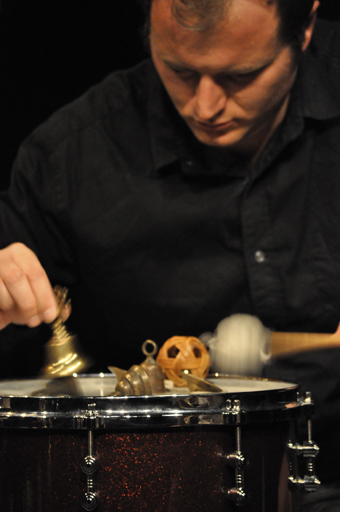
Isaiah Ceccarelli, SoundOut 2011
photo Yasmin Masri
Isaiah Ceccarelli, SoundOut 2011
However the most surprising turn in events came in the 16th set (out of 20) of the festival with Denley and Richard Johnson on woodwinds and Evan Dorrian and Canadian artist Isaiah Ceccarelli on drums. Ceccarelli had been an intriguing presence, often sustaining an action through long sections of a set, providing a sense of consistency while others swirled around him. In this instance, after exploring the running of bells across his drum, he suddenly burst into song! In a beautiful baritone he executed interval leaps and chants, creating an improv opera that was playful, profoundly beautiful and surprising, energising everyone, most of all, perhaps, his fellow musicians.
Moments like Ceccarelli’s poetic outpouring and Gorfinkel/Waples/Brooks’ ‘crumbly music’ were interesting responses to the intensity otherwise generated by the SoundOut format. (Yan Jun from China on delicate handmade electronics and Monica Brooks on accordion also sought extremes in their exactingly minimalist set in which the in-house cricket was decibels louder than their output.) It was fascinating to watch musicians discover that some of their tactics were exhausted by their fifth appearance, forcing them to push further to find new methods of engagement with their own instruments and with the group. Experiencing all the SoundOut sessions was not for the faint-hearted, but the compression certainly brought something out in the musicians: this energy was felt by audiences attending even a single session. While the NOW now festival (page 38) covers a similar improv remit, it encourages a little more cross-genre play and is more spacious, spread over several evenings. The crazy intensity of the work-day units of SoundOut, its purity of focus and its location in our nation’s capital offer it genuine points of difference.
SoundOut 2011, director Richard Johnson, artists Cor Fuhler, Dale Gorfinkel, Evan Dorrian, Jim Denley, Kim Myhr, Laura Altman, Magda Mayas, Michael Norris, Mike Majkowski, Monika Brooks, Richard Johnson, Rosalind Hall, Shoeb Ahmed, The Thing (Mats Gustafsson, Ingebrigt Haker-Flaten, Paal Nilssen-Love), Tony Buck, Isaiah Ceccarelli, James Waples, Yan Jun; The Street Theatre, Canberra, Jan 29-30
RealTime issue #102 April-May 2011 pg. 39
© Gail Priest; for permission to reproduce apply to realtime@realtimearts.net
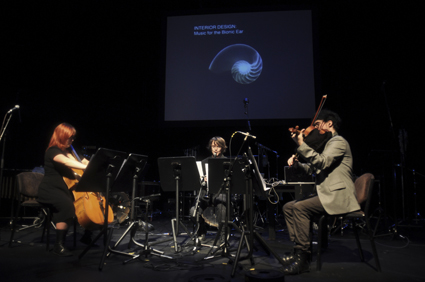
Judith Hamann, Sam Dunscombe, James Rushford, Golden Fur
courtesy the aritsts
Judith Hamann, Sam Dunscombe, James Rushford, Golden Fur
THE COCHLEAR IMPLANT CONSISTS OF 22 ELECTRODES CONNECTED DIRECTLY TO THE AUDITORY NERVE. A MICROPHONE TRANSMITS AN AUDIO SIGNAL TO THESE ELECTRODES, ALLOWING THE WEARER TO BECOME AWARE OF THE SOUNDS AROUND THEM. GIVEN THE DIFFICULTY FOR COCHLEAR IMPLANT WEARERS TO DISTINGUISH TIMBRE AND PITCH, MUSIC IS A CHALLENGING AND SOMETIMES UNPLEASANT EXPERIENCE. THE INTERIOR DESIGN: MUSIC FOR THE BIONIC EAR PROJECT, CULMINATING IN A PERFORMANCE OF SIX NEWLY COMMISSIONED WORKS, AIMED TO ADDRESS THIS ISSUE.
In the concert, performed by Golden Fur and Speak Percussion, 11 loudspeakers were designed to mimic the 22 electrodes in a cochlear implant for an audience listening with and without implants. Composers and scientists have worked with wearers to investigate which sounds can be effectively perceived.
As well as the practical objective of producing music that can be appreciated by cochlear implant wearers, this project also raises questions about the nature of musical engagement. How does one go about composing music for someone with an entirely different experience of sound from one’s own?
A similar dilemma is faced by audiences who do not use implants. At times it was difficult to know how certain sounds were intended to be perceived, given that a number of the compositions used sounds specifically chosen for the way they would be experienced through an implant. For example, Ben Harper’s This is All I Need employs a tuning system based on the frequency spectrum of the electrodes in the cochlear implant. Rohan Drape’s Another in Another Dark uses extreme limitation as a means of focusing a listener’s perception. Instruments play various combinations of one or two note fragments at a slow tempo, with slight variations in duration. The result is something analogous to a suspended mobile, in that the experience of the work does not change over time, although the gradual shift of parts creates an illusion of changing perspectives.
Natasha Anderson’s Study for the Bionic Ear #1 moves between radically different sound worlds. The work begins with a stark and dry pallet of shaker, bongos and congas played with mallets. This is transformed with the introduction of piano samples—single note, contrasting rhythmic patterns sent through various speaker channels. In stark contrast to this highly rhythmic and energetic language, the final section uses bowed vibraphone, vibraphone tremolos, sine tones and samples of cello harmonics to create a highly spacious and atmospheric sound world.
Eugene Ughetti’s Syncretism A engages through a sense of theatricality and playfulness. Three percussionists with expanded drum kit set-ups play with speech, dynamic level and obscured stylistic references. The work is a pastiche of contrasting styles and techniques. Hand-held microphones are used to diffuse the sound of certain instruments into various parts of the theatre.
In a brief statement preceding the concert, artistic director Robin Fox drew attention to the fact that the works of these composers are rooted in an experimental aesthetic, concerned with challenging the parameters through which we engage with music. It follows logically that composers with this kind of approach, generally speaking, would be the obvious choice for such a project. However there were instances in the program where the conceptual agenda weighed the music down for the hearing audience.
It is a supreme challenge to compose music that will be perceived in an entirely different acoustic reality. Fox’s 3 Studies for the Bionic Ear achieved this most convincingly. In this work, sound was diffused through speakers in various patterns, an integral component in the language. These sonic patterns were accompanied by visual material that was highly integrated with sound, brilliantly drawing attention to subtle sonic shifts which may not otherwise have been noticed. What was most exciting was that the strength and clarity of the gestures produced by sound and visuals made it seem entirely feasible that this work would be just as engaging through a radically different mode of perceiving sound.
James Rushford’s Tusilage was also a standout work, due purely to the strength of its musical material. Performed by Rushford on viola, Judith Hamann on cello and accompanied by tape play-back, there was an eloquence and depth in its form, created through a sophisticated layering of material. Variations in the complexity and density of timbre were created through an exploration of the sonic potential of the bowed instruments and planes of pre-recorded sounds, allowing Tusilage to traverse vastly different states of energy and movement.
Interior Design: Music for the Bionic Ear, artistic director Robin Fox, composers Robin Fox, Natasha Anderson, Rohan Drape, Eugene Ughetti, Ben Harper, James Rushford, performers Golden Fur, Speak Percussion, Fairfax Theatre, Arts Centre, Melbourne, Feb 13
RealTime issue #102 April-May 2011 pg. 39
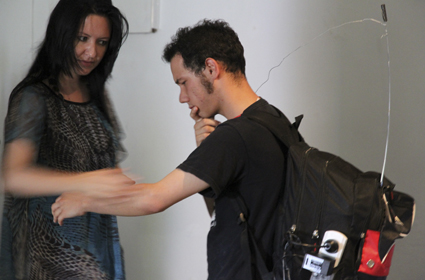
Human Theramin, Luke Pasquale Calarco and audience member
photo Pia van Gelder
Human Theramin, Luke Pasquale Calarco and audience member
AS IF HANDPICKED ESPECIALLY TO APPEAL TO MY SENSES AND ALIGN WITH MY ETHICS, THIS YEAR’S SYDNEY DORKBOT GROUP SHOW EXHIBITION AT SERIAL SPACE ASSEMBLED SIX CAPTIVATINGLY EARNEST WORKS. CURATOR PIA VAN GELDER ALSO HOSTED AN ARTISTS’ TALK THAT TURNED OUT TO BE A PRETTY SPECIAL SUNDAY AFTERNOON OF ENGAGING DISCUSSION.
Jiann Hughes’ interactive boxing breath-centric work, Below the Belt, is right up my alley: sensors, interactivity and an awesome costume to boot. Donning the red headgear, I’m strapped into an immersive solitary auditory environment that immediately blocks out the reverberant gallery sound. Appearing on screen, Tony (the boxing instructor from Mundine’s gym) puts me to the test. He’s only interested in one thing: my breathing. In a series of rounds, he manages to coach me through a couple of breathing exercises while dishing out occasional words of criticism or encouragement. Ability to control breath leaves you with a ranking of lightweight, featherweight or sometimes even better.
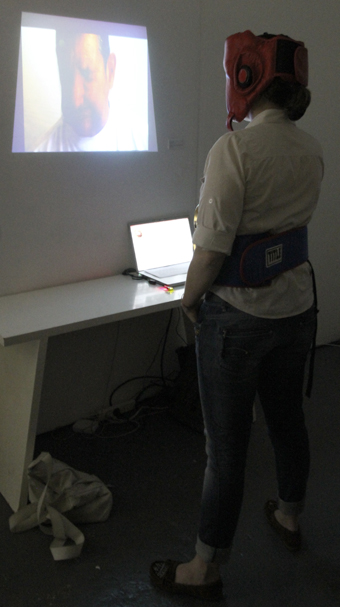
Below the Belt, Jiann Hughes
photo Pia van Gelder
Below the Belt, Jiann Hughes
So often breath-controlled interactives encourage peaceful experiences (such as the artworks of George Khut, Hannah Clemen or Elliat Rich). Below the Belt takes you into another realm of all-consuming fun reminiscent of You Are Here’s Pemulwuy Dream Team interactive boxing game, albeit with a very different motive. As Hughes puts it, the work explores “tensions between competitive contact sports and the inward focus of breathing practices that support[s] them.” Amid the fun, I am still consciously attempting to centre myself through my breath. Overall, Below the Belt could do with a little tidying at the edges. However building a work like this is challenging—especially in incorporating this form of interactive control—while ensuring the scenario is a truly believable one. Not for one moment was my attention distracted.
Next on offer is a different intimate interaction. The Human Theramin by Luke Pasquale Calarco is a construction made from a backpack stuffed with the essential old-school gadgets, aerial poking out the top, plus a power lead trailing behind. Wearing the backpack, Calarco turns himself into a touchable sound-producing instrument, generating a range of squeaks, squeals, drones and groans typical of a short-circuiting electronic gadget. Having navigated all the politics of physical interaction with a total stranger, audience members’ faces display a sense of wonder as they engage in the noise-making process. Observing from the sidelines, it’s like watching a bunch of two-year-olds with a newfound toy.
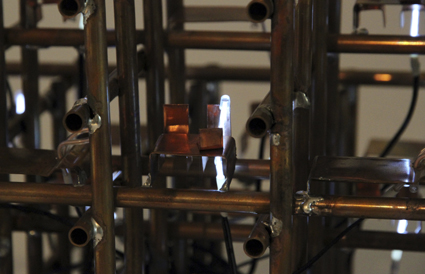
Drone 1, David Kirkpatrick
photo Pia van Gelder
Drone 1, David Kirkpatrick
David Kirkpatrick’s Drone 1, bearing several crucial messages, is a reflection of the state of current society. One oversized switch swaps the glow of a dozen or so tiny protrusions of electro-luminescent wire to radiating loops, positioned equidistantly in a 3D copper pipe grid. Look closer and you realise it is an apartment block in miniature—each room either an office (containing a desk, chairs and laptop) or a bedroom. At the flick of the switch, stick figures hard at work in their offices then lie still in their beds. Kirkpatrick describes Drone 1 as “the way we feel when moving towards a binary life,” and it’s almost impossible to oppose this statement. Which of us doesn’t feel chained to a computer almost every waking hour, with our only respite being sleep? Through further explanation in the artist’s talk, more layers of critique appear. “Copper is important to tell this story,” states Kirkpatrick. Constructed from finite resources, the materials he’s selected also draw attention to our way of life that is ultimately unsustainable in so many respects.
The other three works in this show are non-interactive and it’s worthwhile noting comments from the curator. She explains that visitors to the exhibition expect the works to be responsive. When nothing happens, they’re actually surprised.
The first of these is Michael Petchovsky’s Infomadream, which is a step towards socially, environmentally and economically conscious media art creation. For several years, I’ve been concerned about the immeasurable environmental impact of electronic components used in creating technology-based artworks. Infomadream is a gesture in the direction of overall awareness. This video installation utilises an open source operating system and video tools installed on some hard garbage (a laptop found on the side of the street). While the video wasn’t the most engaging work in the show, the ideas—particularly the desire for positive activism, which it helped to generate during discussion—sparked something far greater than the work itself.
Ross Manning’s Trapped Universe is the odd one out. Located in the main exhibition space, it deserved to be placed where quiet contemplation might occur. Without an interactive or time-based component, this work actually requires more patience of its audience. While it may have been overlooked on occasion, for those who were willing to sit and observe this undemanding work gently revealed an entire world of peaks, valleys and cascading rainbows.
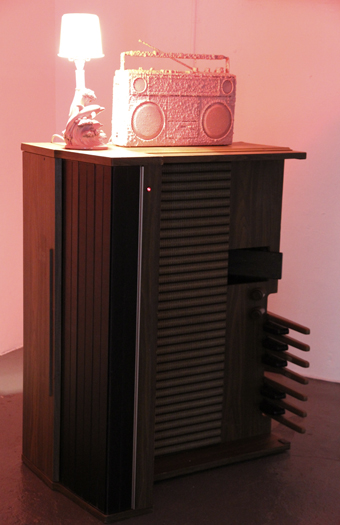
Death by Stereo, Wade Marynowsky
photo Pia van Gelder
Death by Stereo, Wade Marynowsky
Death by Stereo combines all of the elements one would expect to find in a Wade Marynowsky work, coupled with the essential Marynowsky aesthetic: retro devices, bubbling pink foam and the almost overbearing chords of impending doom—as if you’d been suddenly transported into a 1950s sci-fi horror flick. This work is the least understated of the exhibition, and I imagine that’s its purpose. As Marynowsky indicates, Death by Stereo “comments on the way we receive constant tragic news bursts.” I’m not so sure this is the message I receive. But it does imprint on my mind that anything pink and bubbly must certainly be toxic and I should remember to steer clear in the future.
I’m revitalised by the works in this exhibition, particularly the ideas driving them and so evident in the accompanying artists’ talks and subsequent discussions that were nothing short of invigorating. I can almost glimpse a new era of media art creation that is socially, politically, economically and environmentally conscious. A new generation and decade of art-making, considerate of the resources consumed in its construction and presentation, produces a glimmer of hope.
Sydney Dorkbot 2011 Group Show, curator Pia van Gelder, Serial Space, Sydney, Feb 22-27; http://dorkbotsyd.boztek.net
RealTime issue #102 April-May 2011 pg. 29
© Somaya Langley; for permission to reproduce apply to realtime@realtimearts.net
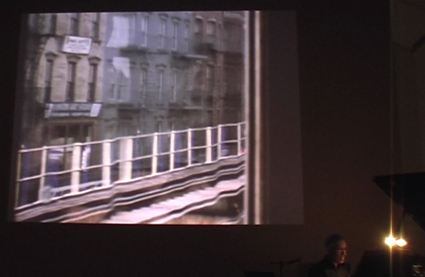
Stephen Whittington, The Music of Light
photo courtesy the artists
Stephen Whittington, The Music of Light
COMBINING WORKS OF MUSIC AND FILM THAT WERE ORIGINALLY INTENDED TO BE SEPARATE MAY SEEM LIKE A STRATEGIC ACT OF POSTMODERN APPROPRIATION OR INTERTEXTUAL ENQUIRY. STEPHEN WHITTINGTON’S THE MUSIC OF LIGHT IS IN FACT A UNIQUE TREATMENT OF THE ART AND PHILOSOPHY OF US FILMMAKER STAN BRAKHAGE (1933–2003) AND OF THE MUSIC OF THE COMPOSERS WHOSE WORK HE PERFORMS WHILE SHOWING BRAKHAGE’S FILMS. ULTIMATELY, WHITTINGTON’S PERFORMANCE IS AN ESSAY ON THE RELATIONSHIP BETWEEN SOUND, LIGHT AND HUMAN PERCEPTION, AN ESSAY THAT IS ITSELF A WORK OF ART.
In this 90-minute performance, Adelaide pianist, composer and lecturer Stephen Whittington shows several of Brakhage’s most famous short films, including Dog Star Man Part 2 (1963), Black Ice (1994) and Glaze of Cathexis (1990). Simultaneously, he performs at the piano the music firstly of JS Bach and then Alexander Scriabin, Arnold Schoenberg, Philip Corner, Anton Webern and Josef Matthias Hauer, and he replays a computer-mediated recording he made of keyboard music by Brakhage’s associate James Tenney. Brakhage, initially a poet, was influenced by Bach and studied music to inform his filmmaking and, in the program note, Whittington suggests that Brakhage’s films were visual embodiments of sound. Whittington also performs his own work, Passacaglia B.A.C.H. (2011), which he wrote for this performance, an entrancing piece performed without film accompaniment to allow viewers to focus solely on the music.
Stan Brakhage made hundreds of short films, some just a minute or two in length and some using radical techniques such as gluing objects onto the celluloid or scratching or hand colouring it. These were works of visual art more than cinema, often having the effect of an abstract painting unfolding in time. Those films that focused on places and people, for example The Wonder Ring (1955), which shows scenes shot from a train window—the world as perceived by the train—are primarily optical rather than narrative. The rapid succession of abstract shapes asks us to experience our visual awareness rather than read for meaning, and so to consider how we assign meaning to imagery. We’re invited to try to regain our visual naivety or innocence.
Brakhage’s film is avant garde in its intent and form, using the medium to analyse visual perception. Each composer also contributed to the dialogue on the essence of music, their avant-gardism lying in the investigation of the inner truth of their chosen art. The Music of Light is not a thorough analysis of Brakhage’s oeuvre, but considers aspects of his work and their relationship to music. Nor does the performance fully consider the oeuvres and impact of the composers. Instead, it is a synthesis of certain aspects of their respective work. This performance recalls some significant milestones in Western artistic development.
Whittington introduces Brakhage’s work and the music with readings—from Wassily Kandinsky’s On the Spiritual in Art (1911), Arnold Schoenberg’s Theory of Harmony (1911) and Johann Von Goethe’s Theory of Colours (1810). Kandinsky, the so-called father of abstraction, explicitly addressed the relationship between art and music, and The Music of Light illustrates these writers’ theories. Whittington also read from Brakhage’s Metaphors for Vision (1963), which opens with, “Imagine an eye unruled by man-made laws of perspective, an eye unprejudiced by compositional logic, an eye which does not respond to the name of everything but which must know each object encountered in life through an adventure of perception.”
Whittington states that the music was not intended to accompany the film, but that the performance comprised two streams in parallel. But the Brakhage works were intended to be silent and the music was intended to be heard on its own, prompting us to consider how combining them affects both visual and musical experiences. By blending visual, musical and textual discourses into a unique synthesis, Whittington creates an exciting new work that represents the way in which sound can induce visual awareness and vice versa. This cross-mediation of vision, sound and performed text opens each discipline to deeper phenomenological analysis through comparison and demonstrates the coherence between them, amplifying and confirming the nature of human awareness of light and sound and the way they are theorised.
The Music of Light is an illuminating and finely crafted performance. The program concludes with Brakhage’s Chinese Series (2003), made by the artist on his deathbed, and is accompanied by Whittington’s arrangement of Bach’s last work, also written on the deathbed, the Chorale Prelude: Before Thy Throne (1750). Whittington completes the parallel by describing the arc of the two artists’ lives, each leaving a final statement that reflected on life, death and God.
Stephen Whittington, The Music of Light, Art Gallery of South Australia, 2011 Bigpond Adelaide Film Festival, Feb 27
RealTime issue #102 April-May 2011 pg. 42
© Chris Reid; for permission to reproduce apply to realtime@realtimearts.net
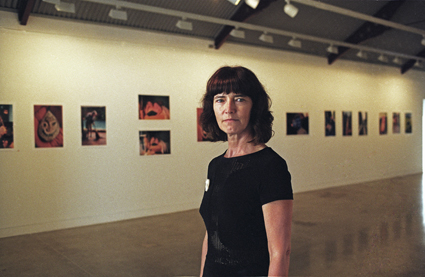
Sandy Edwards
photo William Yang
Sandy Edwards
SANDY EDWARDS IS A DISTINGUISHED SYDNEY-BASED PHOTOGRAPHER AND CURATOR. I TALKED TO HER ABOUT HOW PHOTOGRAPHERS ARE ASSISTED, MENTORED AND EXHIBITED HERE GIVEN THE PAUCITY OF GALLERIES THAT EITHER SPECIALISE IN OR FEEL CONFIDENT TO EXHIBIT PHOTOGRAPHY AND ABOUT HER ROLE AS CREATIVE PRODUCER IN HER BUSINESS, ARTHERE, WHICH PROVIDES SERVICES FOR PHOTOGRAPHIC PROJECTS AND EXHIBITIONS AS WELL AS MENTORING AND CONSULTATION.
What was the impetus for ARTHERE?
I’d been working at Stills Gallery for about 17 years. Stills is a beacon for photographers because there are so few prestige galleries that focus purely on photography in Australia. At Stills we have nine exhibition slots a year and even if you show two artists simultaneously, that’s only 18. At the same time we’re representing artists and that means regular exhibitions for them. Even though Stills is committed to providing spaces for emerging artists, I was constantly having to advise people where else to go. I also realised there was a general lack of understanding about how the gallery world works. I still have a really good relationship with Stills and work there part-time as a curator but I decided to make a sideways step away—hence this idea of helping people to find spaces and have exhibitions.
How do you establish your validity if you don’t have your own space?
That’s not so easy as a space speaks for itself. However, not having a space leaves you free to do things in different ways. A space means you have to be in attendance at all times or employ staff. The freedom of working from home and sometimes from makeshift offices means that I can do a lot online, meet people in person and then place their work in appropriate spaces around the city.
What sorts of spaces?
Everyone would like to be represented by a gallery because that’s in a way what you’re aiming for as a serious artist—the peak reward. This notion is supported by the political structure. It’s how works are purchased for gallery collections, bought by private collectors—how they’re seen.
My belief is that photography, being a varied medium, can attach itself to all sorts of meanings and forms of expression. Therefore it should have multiple possibilities in terms of where you see it. So I started looking at empty spaces, alternate spaces. It might be an embassy because an artist is a foreign national. It might be a café, a shopfront. Then the whole concept of pop-up galleries was presented to me, apparently already popular in the US; you have a space for the period of the exhibition and then you leave. Shopfronts are a natural for this kind of thing if they’re waiting to be rented. If you can persuade the owner or the lessee to let you use it then you can sometimes get a very good spot—visibility is pretty important. And then, of course, there are public and private galleries.
How do you find spaces?
I travel around a lot and I just see spaces. The first place we used was in Danks Street, Waterloo. The gallery scene there had been in existence for about five years. I noticed an arcade of shops that were not visible to the street. I approached the agent and he said I could have three of the shops for the period of an exhibition. So we had a three-week show and I put a different artist in each of the shops.
One of your shows was on the top floor of an apartment building.
The old Police Headquarters on College Street facing Hyde Park was being redeveloped into classy apartments. Photographer Pete Longworth had been employed by the developers to be their front-person to make the place and the location look beautiful to potential buyers. He’d provided them with a lot of photographs, but he’d also produced his own artistic interpretation of Hyde Park. So he came to me and we decided to have the exhibition on the top floor of that building with its fabulous views of the harbour and the park. That was really exciting.
In the last year and a half I have been moving away from the rental and pop up spaces and concentrating more on working with galleries, both commercial (Meyer Gallery, Sara Roney Gallery, Conny Dietzschold Gallery) and curating shows for public and institutional spaces (Customs House, UTS Gallery, Manly Art Gallery and Museum). The latest idea is Photography On Oxford, a project associated with the Head On Photo Festival. We plan to put photography in shopfronts along Oxford Street, Paddington as a mini street exhibition.
How do you manage the marketing given you’re dealing with a fair sweep of work—art photography, documentary…
The mailing list was built from the beginning. Obviously there are a lot of photographers, a general list of interested people, but then curators, collectors and a few other categories. What happens is that your relationships with people become really important and you have to develop and maintain them. I’m constantly telling the photographers I’m working with to grow their own mailing lists and to get to know their audience.
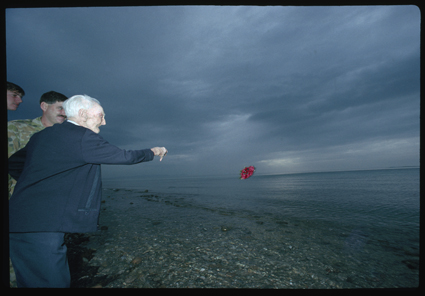
Jack Ryan throwing poppies into the Aegean Sea, When Old Foes Meet
photo Vedat Acikalin
Jack Ryan throwing poppies into the Aegean Sea, When Old Foes Meet
How do you select the artists you work with?
They come in waves. Lots of people come as they’re getting themselves together for the year. Photographers ask for consultations and that may roll over into what I call mentoring, to achieve a particular goal. It may be to get ready to approach a gallery or venue, or to secure the venue, or to follow the steps to having an exhibition once the venue is lined up. I’ve discovered that people who actually make the effort to come to me are already proactive. Not that everyone needs to be totally confident but that drive and the belief in what they’ve got is really critical.
People tend to be ‘other’ oriented. We want someone else to tell us that our work is good. To go to an established gallery and ask for an exhibition is quite daunting. A lot of my clients are having their first experience of the art world. But people who come to me whose work is not ready for exhibition go away with a list of tasks to further develop the work. I don’t want people to have to commit a lot of money in the beginning because they may not be in that place yet.
What proportion of your photographers are emerging artists?
It’s probably about 70 percent. However, I have people I’ve worked with before who are now onto their second or third exhibition. That’s really satisfying. Some artists, like Ben Ali Ong, whom I worked with in the early stages of ARTHERE, is now with Tim Olsen Gallery and doing really well. But it’s hard to get representation. If someone comes to me and says I want a gallery, I say, well, it might take a few years so we need to look at what the steps are. I find it hard to find galleries for people unless their work is absolutely standout.
And your own work?
I’m still taking photographs but I haven’t done anything in the way of an exhibition since 2004 when I had INDELIBLE at Stills. However, creativity comes in many forms and if you’re getting a lot out of what you’re doing, as long as you’re not burning yourself out, that’s very satisfying as well.
This seems to me a very creative enterprise. But can you make money from it?
I can. The only thing that’s problematic is that I’m making money pretty well purely from artists and, as we know, artists don’t have a lot of money. That’s why I have the different stages so someone can see me and, out of that meeting, they’ll get a lot of ideas and begin to focus. They’ll get the benefit of my knowledge about what’s required to be an artist—how it’s not just about working on your own. You need to have a context, a peer group; you need to see others’ work; you need to meet people. Otherwise you end up not being seen.
Tell me a little bit about your latest exhibition.
This is a good example of one that might never have got up. Vedat Acikalin is a Turkish-born photographer who’s lived in Australia for a long time. He’s worked as a press photographer in sports and world news. He photographed the 75th anniversary of the Gallipoli landing in 1990 and felt very passionate about the fact that former Turkish and Australian soldiers who’d previously fought one another were actually meeting and becoming friends. The exhibition is called When Old Foes Meet. It’s documentary work and tells a very positive story of reconciliation. Vedat was determined to get this exhibition up. He found a space in Chifley Tower. It’s in a beautiful marble foyer in Bent Street and the exhibition will run through Anzac Day.
I should say that the other critically important half of ARTHERE is Cassie French of Pop-Up Publicity. She works on most of the shows and takes on others as well and is unique in Sydney, specialising in photography. And if your show is not out there in the media it just doesn’t get seen. We’re pretty much equal in the business and bounce a lot of ideas off each other. Bruce Nicholson is the designer and technical support person and Lisa Sharkey is involved in installation.
So do you see ARTHERE as eventually growing into part of the infrastructure or will it retain its subversive character?
The mainstream gallery scene is pretty rigid. I’m not saying curators don’t choose really carefully but from my observation there are lots of photographers out there who don’t necessarily get looked at. So I guess it’s subversive in a way to try to find other venues in the hope that it will move things around. This is a time when lots of people are looking for different models. ARTHERE is just one.
ARTHERE: Vedat Acikalin, When Old Foes Meet, March 28-April 29, Chifley Tower, Bent Street Lobby, 2 Bent Street, Sydney, Mon-Fri 7am-7pm; www.arthere.com.au
Photography on Oxford Street, shop windows photography exhibtion, May 9-29
RealTime issue #102 April-May 2011 pg. 43
© Virginia Baxter; for permission to reproduce apply to realtime@realtimearts.net
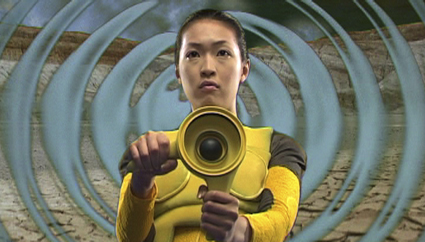
Philip Brophy, The Sound of Milk, 2004 video still
courtesy the artist
Philip Brophy, The Sound of Milk, 2004 video still
ACCORDING TO THE LONDON TELEGRAPH (FEB 1, 2011), SCIENTISTS HAVE MANAGED TO MAKE A PAPER CLIP DISAPPEAR USING ‘CLOAKING TECHNOLOGY’ OF THE KIND THAT ALLOWS VULCAN SHIPS IN STAR TREK (1966-2005) TO SUDDENLY MATERIALISE BEHIND THE ENTERPRISE. THEY’VE ALSO BEEN EXPLORING THE USE OF METAMATERIALS—PROJECTING ‘BACKGROUND’ OVER A MICROSCOPIC OBJECT SO THAT IT WILL SEEM INVISIBLE. IT SOUNDS RATHER LIKE THE TECHNOLOGY DESCRIBED BY WILLIAM GIBSON IN THE FORM OF SCRAMBLE SUITS WORN BY THE PANTHER MODERNS IN HIS NOVEL NEUROMANCER (1984). AS CURATOR LIZZIE MULLER SUGGESTS, “SCIENCE FICTION DOESN’T JUST PREDICT THE FUTURE, IN SOME WAYS IT BRINGS IT INTO BEING.”
Of course many science fiction writers are very well informed about science. In extending the possibilities of current tools and speculating on sociological trends they play a vital role in preparing us for new technological horizons. It is this interplay of fact, fiction, reality and dreaming that has inspired Muller and her co-conspirator Bec Dean in their curation of the upcoming exhibition Awfully Wonderful, at Performance Space. Dean is a curator, writer and Performance Space Associate Director and Muller, a Senior Lecturer in the School of Design at the University of Technology Sydney, is a curator, writer and researcher specialising in interaction, audience experience and interdisciplinary collaboration.
low-tech excursions
The relationship between science fiction and ‘new’ media art has always been strong. However, what is intriguing about Awfully Wonderful is the downplaying of technology: the works are, on the whole, relatively low-fi, with the emphasis placed firmly on the fictive content. There’s no bio-art, laser technologies, holograms or robots; rather there’s photomedia, video, installation, sculpture and painting. Well actually there is a robot, but it’s made of cardboard—Simon Yates will be recreating the cyborg Maria from Metropolis in the style of his balloon-suspended walking characters. Muller says ironically that Yates’ Maria “is probably not dissimilarly as high-tech as the one that starred in the actual film,” the longer, recently rediscovered version of which will also be screened in Awfully Wonderful.
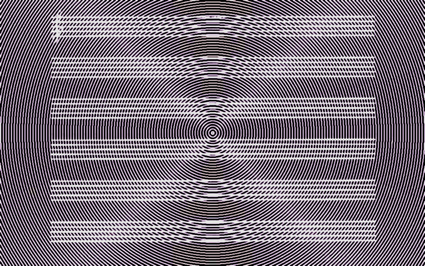
Eugene Carchesio, she sells $ilence by the sea shore 2011
courtesy Milani Gallery
Eugene Carchesio, she sells $ilence by the sea shore 2011
An unusual inclusion is artist Eugene Carchesio, who will be creating a wall painting specifically for the exhibition. Dean says, “I’m really interested in the small systems, languages and codes that Eugene proposes in his work…I think inside [this] painting is the potential for infinity within a closed form…Science, time and space are implicit and yet not overstated in his works. He is interested in numerology and cosmologies and all these different kinds of patterns and systems that are repeated and are not so easy to pin down or quantify.”
artist as lab rat
Bec Dean has also been interested in the work of Hayden Fowler for some time. Previously his absurdist scenarios in which people co-exist quietly with a variety of animals have been exhibited as video works, but in Anthropocene the artist himself will inhabit his installation accompanied by some lab rats. Dean explains: “[Fowler is] an artist who is interested in inter-species relationships and the kinds of connections that we might have with other sorts of life forms here on planet earth and maybe somewhere else too.” The use of lab rats alludes to biotechnology but Muller also suggests that the interspecies exploration is a “neo-Adam, neo-Eden thing…there’s this idea of biotechnology being the latest apple that we’ve stolen. What is that going to do to our relationship with the natural world? This is what Eden and Adam myths are about, the relationship to power, to knowledge, to god, to everything else that exists on the planet. That’s why sci-fi is such a great genre because it really goes at those great myths.”
time travellers
Time travel is explored through the technologies of moving image by both Sam Smith and Ms&Mr. Dean says Smith’s work “is about the kind of time travel that is inherent within any form of recorded media in terms of the way you can reverse it, play it forward, go back to a point or pause it. [This is] taken further by Ms&Mr who go back into old media and insert something new or intertwine stories [about themselves] before they’d even met. In both of those works the artists are very playfully engaging with the notion of time travel within media that is already extant, that we already have at our fingertips.” A related work by Jaki Middleton and David Lawrey will continue the artists’ explorations using the pre-cinematic device of Pepper’s Ghost to create pre- and post-apocalyptic dioramas, gradually shifting from prosperity to disaster before our very eyes. [See RT Studio]
earth’s atmosphere and beyond
The works of David Haines/Joyce Hinterding and Adam Norton engage a little more directly with notions of science. Haines/Hinterding are inspired both artistically and philosophically by the controversial psychiatrist and inventor Wilhelm Reich. They will be recreating Reich’s Cloudbuster, which was invented to produce rainclouds. Muller suggests that the cloudbuster has particular resonance now with “global warming and the possibility of geo-engineering fixing some of our manmade problems…the technological fix, but also technology as magic.”
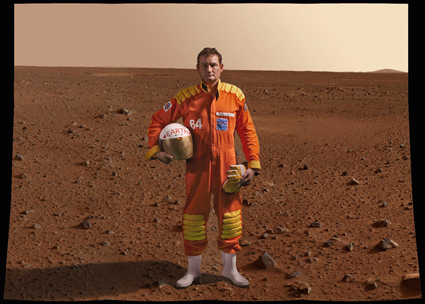
Adam Norton, Mars Space Walk
photo courtesy the artists
Adam Norton, Mars Space Walk
Adam Norton has set himself a particularly ambitious task attempting to recreate the gravity of Mars in the CarriageWorks foyer. Using a complicated system of harnesses and ramps based on NASA’s Apollo space program devices, he will perform Mars space walks in simulated 38% gravity at the opening and every Saturday during the exhibition.
the other woman
Deborah Kelly has been commissioned to create a work responding to the representations of women in science fiction. After trawling through Australia’s largest archive of sci-fi pulp magazines, Kelly has taken a slightly oblique approach. Inspired by the writings of radical feminist Shulamith Firestone on issues to do with women taking control of their own reproductive lives, she is creating delicate collages in which sci-fi scenarios are recreated with organic materials like seashells. Muller says, “it is another take on sci-fi imagery that I think is as interesting as the big breasted 70-foot woman, pulp-type imagery and is also really interesting in terms of the connection between the organic and the machinic, which is where the cyborg idea comes from.” Thematically linked is a Philip Brophy video work, exhibited here for the first time, The Sound of Milk (2004), a dystopian tale in which males and females have become separate species. Ian Haig’s Chronicles of the new human organism (2009, with sound by Brophy and Philip Samartzis), in the form of a post-apocalyptic nature documentary, will also play in the dedicated screening room.
sci-fi science
A particularly exciting inclusion is a series of artefacts sourced from the Powerhouse Museum, assembled and interpreted by Jo Law and featuring an Edison phonograph from 1908, a Curta Calculator and Dr Bodkin Adam’s Electromassager. While these artefacts relate to the artworks in Awfully Wonderful and are particularly beautiful as objects, they also offer their own fictions. For example, the Curta calculator features in William Gibson’s Pattern Recognition as a prize collector’s item connected with smuggling and conspiracy. The Electromassager manufactured by the Ediswan company is a vibrator that emits a violet light intended to relieve female hysteria, and was owned by English physician Dr Bodkin Adams who is suspected of killing a large number of his patients after securing inclusion in their wills. In addition, in their obsolescence these objects offer further potential for the imagination. Muller says, “because they’re no longer current in terms of scientific truth, they’ve moved into the realms of scientific fiction and they have that same kind of provocative speculative aura as the artworks.”
In addition to the exhibition, there will also be a range of public programs including a symposium and an audio guide by scientists, in collaboration with the Royal Institute of Australia (RiAus, Adelaide) who advocate for a broader understanding of science. “We really wanted to have scientists talking about the works and the scientific possibilities behind them and have that as an aspect of the interpretation,” Muller says.
For Lizzie Muller and Bec Dean, Awfully Wonderful brings together their passion for art and their shared love of science fiction. Muller concludes, “I did literature before I did art, and I was really interested in science too…I loved Gulliver’s Travels and things that combined science, literature and experimentation with a form. That’s what we’re looking for—artworks that have kind of wormholed into another dimension.”
Performance Space, Awfully Wonderful, curators Bec Dean, Lizzie Muller, artists Philip Brophy, Eugene Carchesio, Haines/Hinterding, Deborah Kelly, Jo Law, David Lawrey & Jaki Middleton, Ms&Mr, Hayden Fowler, Ian Haig, Adam Norton, Sam Smith, Simon Yates, Performance Space, CarriageWorks, April 15-May 14
The RealTime-Performance Space informal discussion with artists, curators and guests about Awfully Wonderful will be held Monday May 9, 6.30pm. All welcome.
Richard Alleyne, Invisibility cloak enters the real world, Feb 1, 2011; www.telegraph.co.uk/science/science-news/8296338/Invisibility-cloak-enters-the-real-world.html
RealTime issue #102 April-May 2011 pg. 45
© Gail Priest; for permission to reproduce apply to realtime@realtimearts.net
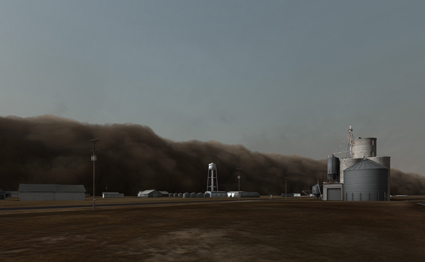
John Gerrard, Dust Storm (Dalhart, Texas), 2007, 2007, Realtime 3D
courtesy of the artist, Simon Preston Gallery, New York and Thomas Dane Gallery, London
John Gerrard, Dust Storm (Dalhart, Texas), 2007, 2007, Realtime 3D
THE LANDSCAPE HAS THE SPOOKY UNINHABITEDNESS OF THE COMPUTER GAME, AND THE SHIFTING VIEWPOINT OF THE SIMULATOR—BUT SLOWED DOWN TO A PACE AT WHICH PIXELS SCRATCH AT THE GAZE. ACROSS THE YELLOW-BROWN PRAIRIE RUNS A BITUMEN ROAD, EDGED BY POWER POLES AND LOOSE-SLUNG WIRES. THE VIEW SHIFTS TO REVEAL A MONUMENTAL SET OF FARM BUILDINGS, LIKE THE ANTITHESIS OF A SIMS GAME, AHEAD OF A MOUNTAINOUS FRONT OF CHOCOLATEY DUST. THE COLOURS, THOUGH REALISTIC, ARE RINSED WEIRDLY CLEAN. SILOS STAND LIKE SCI-FI WAR MACHINES, SENTINEL; THE SKY IS FEARFULLY WHITE.
Irish artist John Gerrard’s Dust Storm (Manter, Kansas) (2007) is part of his Animated Scenes series, four of which were shown recently at PICA. Constructed from thousands of still photographs, Gerrard’s ‘portraits’ are fully animated models, locked to a real-time schedule of changing light over the duration of the day. The viewer is drawn around both object and horizon in a stately, 360-degree orbit.
The images of dustbowl landscapes reference an astonishing history: the USA’s Black Sunday of 1935, when a dust storm 1,500 miles wide and half a mile high roiled and churned across much of Colorado, Kansas and New Mexico. The result of over-ploughing, the storm carried the topsoil of 100 million acres—a phenomenon made possible by the internal combustion engine. The storm took four hours to pass in some places; there are few photos of the apocalyptic event. To recreate it, Gerrard used photos taken by US troops in Iraq, of literal ‘desert storms’ passing over military bases.
The second work, Dust Storm (Dalhart, Texas) (2007) is even more epic and menacing, its group of farm buildings huddled in the far distance, insignificant before the advancing front. But as the view pans away from the storm itself, the threat vanishes. A dichotomy appears between the seething, chthonic cloud of grit and wind, and an idyllic, if sparse, pastoral scene.
The ubiquitous row of telegraph wires seems almost out of place here, as though there should really be no linkage between the cluster of distant equipment and the monstrous storm, or even indeed with the viewer. It’s a feeling that resonates with John Barrett-Lennard’s catalogue essay description of Gerrard’s works as floating in “a space between the real and imaginary, connected but apart from both.”
In his artist talk at PICA, Gerrard showed a photograph titled Figure Blocking Sun (Cesar) (2008). It features the silhouette of a man: an utterly black shape surrounded by a fine rim of backlight. Relating it to the Animated Scenes series, Gerrard spoke of the figure as void; of its form as an “oscillation between surface and portal.” As Barrett-Lennard points out, “however precise the rendering [of Gerrard’s images, their] reality is incomplete and a haunting emptiness remains.”
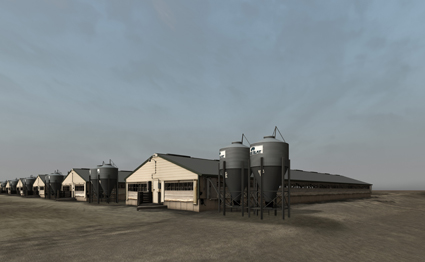
John Gerrard, John Gerrard, Grow Finish Unit (Near Elkhart, Kansas), 2008
photo Tony Nathan/Imagelab, courtesy the artist and PICA
John Gerrard, John Gerrard, Grow Finish Unit (Near Elkhart, Kansas), 2008
Gerrard’s Grow Finish Unit (near Elkhart, Kansas) (2008) presents an ominous array of low, grey-roofed buildings, whose eerie uniformity accentuates the silence of his works: no bird sings, no machinery hums. The term “grow finish unit” is a euphemism for an indoor pig farm, and the unnaturally still lagoon aligning with the sheds is, Gerrard points out, an effluent pond.
At the end of each shed are what seem to be extractor fan vents: large metallic cylindrical attachments, which, like squid suckers, lend an unsettling organic feel to the oddly warm cream and grey of the buildings. There is no opportunity to move the controls and enter. The paired feed silos that appear between sheds are strangely anthropomorphic, as though the viewer can’t help but place a figure here. Tellingly, it’s a figure that seems to ward off intruders.
Gerrard’s animations defeat the logic of the gaming engine he uses to create them, disabling the viewer from forging their own pathway through the work. The relentlessly orbiting ‘eye’ sometimes moves excruciatingly slowly, forcing reflection on these monuments to an environmental wealth that’s come at the price of desolation. The nodding oilfield Lufkin pumpjack of Lufkin (near Hugo, Colorado) (2009), like a huge, thirsty bird, is the most prosaic and familiar of the structures we observe, but seems the most irreal; perhaps because we are close enough to observe its subtle dislocation from the photographic image, the lack of minute detail rendering it smoothly alien. Gerrard describes it as “parasitically vasomorphic—reminiscent of the 20th century”—his own century, he says; a kind of self-portrait.
By eliminating surface distractions, John Gerrard’s ‘portraits’ distill both the human presence and the post-industrial ‘naturalness’ of the landscapes they recreate. It’s an uncanny blend of computer age and lost romanticism, which leaves the viewer oscillating in an intriguing void-portal space.
PICA: artist John Gerrard, production Werner Poetzelberger, modelling Daniel Felsner, programming Helmut Bressler, Matthias Strohmaier, additional modelling Christina Pilsl, additional programming Helmut Bressler; Perth Institute of Contemporary Art, Feb 17-April 3
RealTime issue #102 April-May 2011 pg. 46
© Urszula Dawkins; for permission to reproduce apply to realtime@realtimearts.net
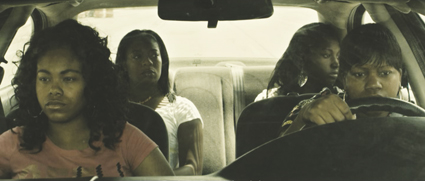
Sirens of Chrome, Jesper Just
courtesy the artist
Sirens of Chrome, Jesper Just
GOING TO THE CINEMA TODAY IS A NOSTALGIC THING TO DO, AS HOME ENTERTAINMENT SYSTEMS OFFER A SIMILAR SORT OF IMMERSIVE EXPERIENCE. THE MULTIPLEXES NOW RESORT TO ALL KINDS OF TRICKS TO ATTRACT AUDIENCES, FROM FIRST CLASS SEATS TO 3D GLASSES. IT IS AGAINST THE BACKDROP OF THIS CRISIS FOR CINEMA THAT JESPER JUST’S SHORT FILMS ARE INSTALLED, CINEMATICALLY, AT THE JOHN CURTIN GALLERY IN PERTH.
Several recessed rooms offer a sumptuous simulation of the multiplex, their doors open so that we are able to wander between films, between moods. This is indeed moody, melancholy stuff, as old men cry and young men sing. Yet these intensely choreographed vignettes also work to deconstruct the cinematic conventions that conspire to affect us. Movements are slow, controlled and slightly out of synch with their narratives, representing in style the disconnection that is also the theme of the relationships they depict.
The men in No Man is an Island II (2004) sit apart from each other in a windowless bar covered with erotic portraits of women, before coming together in a choral cover of Roy Orbison’s “Crying.” In Bliss and Heaven (2004) a truck driver dressed in drag breaks into Olivia Newton-John’s “Please Don’t Keep Me Waiting.” When he finishes and breaks into tears, it is difficult not to recall the pivotal scene at Club Silencio in David Lynch’s Mulholland Drive (2001) where the host reminds us that the performance is only a recording, only to have the singer drop dead while her voice carries on echoing through the theatre. Just’s films are full of such allusions to cinema and its conventions for simulating feeling. The truck driver’s song is uncannily moving although the scene is a comic one, in a duplicity of affect that leaves us unsure as to the film’s genre.
While Just’s earlier work focuses on men, curator Chris Malcolm has included his later attention to women. The Sirens of Chrome (2010) uses an Angelo Badalamenti style track to score an encounter between a woman and a parked car. She rolls over it in a choreographed orgy of limbs, chrome reflections and hair. Again it is difficult not to fall into the trap of genre confusion that Just has set for us, as the close camera makes it appear as if the woman is being hit by a moving vehicle, and simultaneously as if she is moving to a trashy modelling routine. This kind of ambiguity accounts for the strength of the work, immersed as it is in cinematic allusion. The women in Just’s films are far more in control than his men, who instead break into song and tears in desperate attempts to break the cold deadlock that separates them from others.
The cinematic installation of Just’s films offers a way of meditating on the subtleties of the medium in a way that online versions of the same (mostly on YouTube) can’t reproduce. Their affects are tied up in the qualities of cinematography and music, the details of performance and mise-en-scène. It is also Just’s reliance on cinematographers, musicians and other technicians of feeling that marks his work out as part of a more conservative stream of contemporary art. This is what Terry Smith calls “remodernism,” that revivifies older artistic practices (here, cinema), and lends itself to a history of art in a way that the much more radical contemporary video and new media movements do not. In this sense Just’s contemporaries reside less in the new democracy of the camera than in Hollywood. Just’s art becomes a way of thinking through the spectacle of this culture industry that carries on despite its apparent demise.
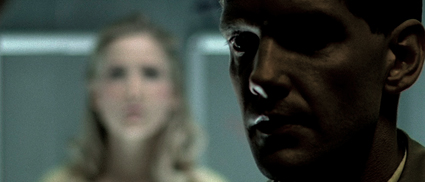
Jesper Just, Something to Love, 2005, production still
image courtesy of the Artist; Galerie Emmanuel Perrotin, Paris; and Galleri Christina Wilson, Copenhagen
Jesper Just, Something to Love, 2005, production still
It is appropriate, then, that Jesper Just helps us to be suspicious of the filmic conventions that are laid bare in his films. In Something to Love (2005), a black car moves through a car park, ominously suggestive, as if in some Swedish detective drama, before a man in tears disrupts the cool toughness of this cinematic cliché. The intersections and encounters in Just’s films return us to the point at which meaning and feeling come together, so that we are held in a state of suspense by their ambiguities, their combinations of cinema conventions, method acting and cover songs. These are remixes of a polished kind, lifting the tropes of classical Hollywood cinema into a slowed down and sublime version of themselves.
Jesper Just, curator Chris Malcolm, John Curtin Gallery, Curtin University, Perth, Feb 11-April 8; http://johncurtingallery.curtin.edu.au
RealTime issue #102 April-May 2011 pg. 46
© Darren Jorgensen; for permission to reproduce apply to realtime@realtimearts.net
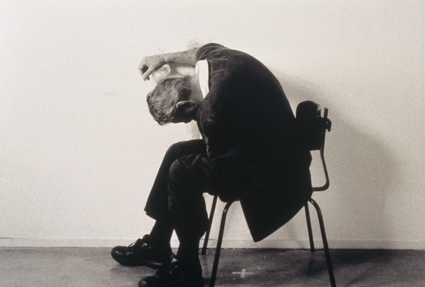
Mike Parr, Malevich (A Political Arm), performance for as long as possible
courtesy the artist
Mike Parr, Malevich (A Political Arm), performance for as long as possible
LOOK AT THESE TWO BOOKS. SAME ARTIST: MIKE PARR. SAME PUBLISHER: SCHWARTZ CITY. SIMILAR TITLES: MIKE PARR PERFORMANCES 1971-2008 (2008) AND THE INFINITY MACHINE: MIKE PARR’S PERFORMANCE ART 1971-2005 (2009). THE FIRST IS COMPILED BY THE ARTIST AND IS VERY MUCH OF THE ORDER OF AN ARTIST’S PROJECT. THE SECOND IS WRITTEN BY EDWARD SCHEER WHO TEACHES IN THEATRE AND PERFORMANCE AT THE UNIVERSITY OF NEW SOUTH WALES. HIS IS AN ACADEMIC’S PROJECT, THAT IS, WE APPROACH PARR’S WORK THROUGH THE INTELLECTUAL FILTER OF THE AUTHOR. BOTH BOOKS ARE LARGE AND RICHLY ILLUSTRATED. IN THESE TIMES, WHEN SO MUCH ON ANY GIVEN SUBJECT CAN BE ACCESSED THROUGH ELECTRONIC MEANS, IT IS SOMETHING OF A PUBLISHING MIRACLE FOR JUST ONE, LET ALONE TWO LARGE MONOGRAPHS ON THE SAME ARTIST TO COME OUT IN QUICK SUCCESSION.
The book is a form that to me inhabits the world of stasis (object) and the world of movement (text). And with these books and this artist, more than usual attention has been given to the experience of the reader who is simultaneously the performer of the object and the audience of the text.
As I mentioned, both books have the same publisher who is also able to handle distribution and has obvious connection to Parr’s dealer, Anna Schwartz. They also share the same editor, the always thorough Linda Michael and the same designer, John Warwicker of tomato, who has applied some stylistic crossovers but recognised the essential differences between the projects.
Parr’s book is a staggering 960 pages, printed on thin, absorbent paper that somehow manages the ink-heavy, often full-bleed illustrations extremely well. Scheer’s book is 200 pages with a high gloss cover and heavy coated stock that gives both images and text a more substantial feel. The closeness of the production team has ensured objects of great quality.
As the titles signify, a long chronological overview is important in both texts. And it’s being applied to a single strand of Parr’s practice: performance, or at least as far as that’s possible when one is dealing with an artist whose media extend to writing, film, video, drawing, photography, print-making, sculpture and installation. By privileging performance, one gets the sense that these other media (and even performance itself) are driven by a greater force, that of time itself.
This is certainly the guiding principle of Scheer’s text which is nothing short of a long essay on time, or more specifically on “duration” which he points out, “implies a specific construction of time.” He goes on to describe a “durational aesthetic” in Parr’s work and observes the changing shape of this aesthetic over what he sees as five distinct (chronological) phases of Parr’s work: the self-aggressive performances; the Black Boxes; the Self-Portrait Project; the Bride performances; and the political works. I found the focus on duration particularly nuanced and sustaining though more convincing in relation to the first and fifth phases, less so in those works dealing with the fixity of the arrested image such as the Black Boxes and the Brides.
Parr’s book is more catalogue raisonné than essay. He sets out to document his entire performance oeuvre. Each performance, including those that were never actualised, is fully catalogued in the back of the book. The front (major) section addresses most but not all of these performances according to photographic documentation and other appropriate forms of evidence, for instance “scripts,” letters to curators and controversial newspaper reviews. Parr has handled the notoriously difficult relationship between original performance and secondary evidence as a challenging opportunity to extend the reach of performance into its equally engaging after-effect.
One example is the treatment of the infamous “armchop” work from 1977, Cathartic Action: Social Gestus No. 5 from Rules and Displacement Activities III. Fourteen double-page spreads are devoted to drawing out the short, sharp blow of the tomahawk that Parr wielded to his meat-filled prosthetic left arm before a shocked audience. The images are frames from the original video footage. The 14 frames therefore represent less than a second in real time, but here we can slow time down or use it like a flip-book to reconstitute the original act. The following pages are occupied by six luscious colour stills taken by John Delacour illustrating the second, often overlooked part of the performance in which members of Parr’s family fit him with a replacement hand-knitted pink woollen prosthetic arm and Parr engages the audience in dialogue about what they’ve just witnessed. The documentation of this work concludes with a written statement by Parr exploring the provocations of the work for himself and his audience.
It’s interesting to compare how the same work is discussed in Scheer’s book. Occurring in the 1970s, all The Rules and Displacement Activities series fall within the first chapter of Scheer’s text. Here the writer introduces the importance to Parr’s work of the psychoanalytic theories of Freud, Jung and Lacan. In the subsection to Chapter 1 titled The Time of Abreaction, the Cathartic Action performance is the primary example for elucidating Freud and Breuer’s work on abreaction and its part in catharsis. Scheer maps the theory onto Parr’s own life experience of how his left arm came to be surgically removed shortly after birth and how this trauma is restaged for an audience. But, as Parr does with the inclusion of the Delacour images and explanatory text, Scheer is careful to devote as much attention to the post-traumatic phase. In keeping with his overarching theme, Scheer expresses it in terms of time: “Abreaction involves a complex movement of time in which there is a climactic cathartic moment followed by an extended period in which the subject’s traumatic episode can be gradually reintegrated into consciousness, the time of healing.”
From the early performances in the 1970s to the more recent, more politically directed works such as Close the Concentration Camps (stitched face) and Kingdom Come and/or Punch Holes in the Body Politic, performance for as long as possible (arm nailed to wall), Mike Parr has expected no less from his audience than he has demanded from himself. In such works, the demands are so high that the audience/artist divide dissolves. Many choose not to make the commitment and for many reasons. Scheer has certainly ventured where others feared to tread and in doing so has given, at least this reader, the critical time and space to reflect on Mike Parr’s work away from the affect-laden closeness of the performance arena.
Mike Parr, Mike Parr: Performances 1971–2008, Schwartz City, Melbourne, 2008, RRP $199.00
Edward Scheer, The Infinity Machine: Mike Parr’s Performance Art 1971-2005, Melbourne, Schwartz City, 2009, RRP $49.95
Both books available through Black Inc, www.blackincbooks.com
RealTime issue #102 April-May 2011 pg. 47
© Barbara Campbell; for permission to reproduce apply to realtime@realtimearts.net
{$slideshow}MY FIRST RESPONSE TO BILL HART'S IN THE GUISE OF THOUGHT DREW FORTH THE CATCHPHRASES “AWE-INSPIRING” AND “MESMERISING.” I MEANT THEM IN NO UNCERTAIN TERMS.
Hart was once a numerical modeller with the CSIRO; he changed careers in 1993, becoming an academic at the Tasmanian School of Art. He is one of the most genuinely gifted e-media artists operating in Tasmania. Visiting his show at CAST, you first see a warning to let your eyes adjust to extreme darkness. Eventually, by the soft light of computer-generated, abstract images floating across the large screen in the centre of the gallery, I found my way to a capacious sofa. I was instantly drawn into a visual experience of sheer beauty—seemingly random words and shapes morphing and dissolving into other ephemeral words and forms. The process is gently paced; it is interesting to pick out the cursive text as it ebbs and flows and re-forms yet again, on and on, always different.
Hart’s artist statement refers to Noam Chomsky and his linguistic universals—the idea that at base level all languages are similarly hard-wired into the brain. I remember struggling with Chomsky at university and later noted how his theories seemed to have had their day. This Hart observes; he explains that different languages have different structures and concepts. So his work is a swirling, seething mass of “language, of vague and amorphous concepts forming and rippling, struggling to form or perceive a larger meaning.” And this is done visually, using quotations from related studies.
I loved the visual element: the beautiful mini-pixilations (my terminology) ever-changing in the most subtle and engaging of colours, and the soft light at the centre of the darkened gallery. I simply gave myself up to the utter pleasure of the experience, returning to the gallery at least four times, just as one might to a much-loved movie. On my third visit I realised there was a soft soundscape emanating not from the screen, but from speakers in the cathedral-like gallery space, featuring the gently murmuring voices of William Burroughs and Laurie Anderson. The work is about language and thought but I'm not sure what this dimension added.
In the Guise of Thought is an important show—as “awe-inspiring” and “mesmerising” as I initially felt. My words cannot do it justice.
Bill Hart, In the Guise of Thought, CAST Gallery, North Hobart,
March, www.billhart.id.au
RealTime issue #102 April-May 2011 pg. web
© Diana Klaosen; for permission to reproduce apply to realtime@realtimearts.net
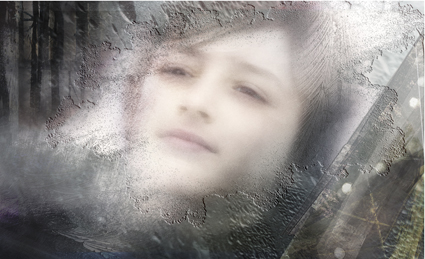
Snow White, Re-enchantment, courtesy ABC
RE-ENCHANTMENT IS A TRANSMEDIA DOCUMENTARY PROJECT, WRITTEN AND DIRECTED BY SARAH GIBSON AND PRODUCED BY SUE MASLIN. APPEARING ON TV, RADIO AND INTERACTIVELY ONLINE AS WELL AS VIA FACEBOOK AND TWITTER, IT EXPLORES “WHY FAIRY STORIES CONTINUE TO ENCHANT, ENTERTAIN, FASCINATE AND HORRIFY CONTEMPORARY ADULT AUDIENCES.” THE PROJECT COMPRISES A WEBSITE [WWW.ABC.NET.AU/TV/RE-ENCHANTMENT] WITH AN OPEN FORUM AND CURATED EXHIBITIONS, 10 THREE-MINUTE ANIMATIONS AND A SERIES OF NARRATED FAIRYTALES.
You’ve received critical acclaim as a documentary-maker. What drew you to the idea of an online documentary that also crossed into other media?
I have been making documentaries for over 30 years and I have always been interested in experimenting with the documentary form. Re-enchantment was a new direction, allowing me to explore whether working in a multiplatform and interactive way could extend the documentary essay and the poetic possibility of documentary—both have been important in my previous documentaries such as Myths of Childhood and The Hundredth Room.
To be honest when I began this project, I was extremely frustrated with the documentary landscape that was dominated by ‘reality.’ I have always been interested in documentaries about ideas and fairytales were occupying my thinking at this time. Although I had no previous experience working in interactive online form I was excited about the possibility of engaging with audiences in new ways. Fairytales seemed ideally suited to an interactive approach.
I saw other documentary makers using the web to repurpose their documentaries originally created for television but I was more interested in working on a project that was conceived for the web, that could use interactivity to extend the purpose of the project.
How different was it to embark on writing an online documentary?
I knew I did not want to retell the stories themselves but to approach their interpretation at the same time as deepening our connection to the mystery of the stories. I was interested in the way artist and filmmakers had reimagined these stories and sensed that Re-enchantment would in itself be a work of creative reinterpretation.
I began with research into each story and a script writing process thinking about how we might engage with the interpretations. I knew I wanted all six story spaces in the forest to look and feel different, using the motifs and symbols unique to each. Bluebeard was the first space developed. This is a story based on keys and a forbidden room. The script developed around Bluebeard’s castle where you find a “corridor of interpretation” and each door you unlock leads to a different take on the story. Cinderella unfolds in a vaudeville theatre and carnival space where different stage shows and experiences with a wheel of fortune and kissing booth determine the ideas you encounter. Rapunzel is set in a tower within a tree where you find yourself in a lift and choose a hair treatment. Each floor you enter challenges you with new content about interpreting the story.
Many visual ideas came from workshopping my scripts with lead animator and graphic designer Rose Draper and interactive designers Catherine Gleeson and Keren Moran and producer Sue Maslin. There was a massive job of visual research by Penny Chai who fed many images by artists into the script development phase. As the visual designs and ideas for interactivity were developed, I did more research and writing. We were all working without a template. I had to learn a new language of ‘navigation’ and ‘asset management.’
It was at this script stage that I had input into storyboards and visual design but then these images and ideas disappear into the world of computer programming and I would not see the results till many months later. This is a very different and frustrating process compared to shooting and editing a documentary. I found it very challenging that in this process I was committing to visuals very early with little or no opportunity for editing and changes. I did not know how interactive elements would work until they were programmed. On the plus side, there was an enormous possibility of layering graphic elements and images that has made for an extremely beautiful and poetic aesthetic. I kept reworking text throughout.
The role of writer/director of content changes in the interactive form. In a linear mode you can structure your documentary around an unfolding argument, even a visual one. But in an interactive mode users skip, hop, immerse, revisit or even turn off the sound. I had to accept they go on a journey of ideas that you as director can’t control. So the challenge is that, even more than in linear documentary, the form must embody my ideas. Each section of the site then has to engage the user in some way with the thinking about the story.
What gave you the inkling to focus on fairytales?
As a small girl I had a mysterious book of fairytales by the Brothers Grimm and Hans Christian Anderson. Dangers lurked in the woods. Caged birds and frogs changed into princes. The Little Match Girl died unfairly I thought. Each time I reread this book I thought I would be able to understand it, but I never did. Fairytales frightened me and fascinated me at the same time. When I became interested in Jungian psychology, I was once again confronted by the strangeness of these tales and their deep resonance in the human psyche. They have continued to surprise and delight me.
When I was making my documentary series Myths of Childhood (2006), I was drawn to fairytales because their more realistic depiction was an antidote to the over sentimentalised idea of childhood in contemporary western culture as a magical, precious time, a period separated off as special and permeated with adult nostalgia. In fairytales children are abandoned by their parents, mothers imprison and plan to eat their children and fathers have incestuous relationships with their daughters. But fairytales also provide hope in the battle against impossible odds and the comforting idea that others have been there before us.
The idea for Re-enchantment was seeded by a conversation. I have been making documentaries since the 1970s and increasingly my documentaries have taken up the relevance of psychological ideas for contemporary culture. In all my work I have been pushing our expectations of documentary. I was chatting with my friend and producer Sue Maslin at an exhibition opening. When she heard I was interested in fairytales she suggested that this would make a great interactive documentary. At that point I had no idea how one made an interactive documentary but we both agreed that fairytales were ideally suited to an interactive form.
Do you have a favourite fairytale?
I ‘lived’ the Hansel and Gretel story as a child and as an adult spent a long time learning to burn the witch in the oven. A fairytale will mean different things to us at 5, 15, 35 and 55. I love the dark aspects of fairytales, in particular stories of the negative mother who imprisons and threatens to devour her children. Now I think about what we can learn about ourselves as older women from the Baba Yaga or old witch stories.
Did this initial response colour how you went about directing the project?
I knew that the power of fairy stories lies in their mystery. They are poetic and cannot be reduced to ‘this means that.’ I think it is exactly because of this they continue to enchant and satisfy us. Visually I wanted to keep a poetic quality and the story spaces to be evocative and where possible playful. Rather than stripping away the mystery and enchantment, the project threads together various interpretations and versions of a story from the perspectives of psychology, social history and popular culture in a way that deepens our connection to and fascination with the richness of fairytales. It is the connection we make to a story that gives it the power to excite our own reimaginings.
The visual language throughout Re-enchantment reflects the symbolic language of the story, for example the use of the shoe motif or hair, and responds to the content or interpretations of the story being considered.
You’re a Jungian therapist. Do you find the symbolism of fairytales affects the way your clients see the world, or how you practice?
Fairytales can help us make sense of inner and outer life experiences. I always liked what the novelist Phillip Pullman once said, “your life begins when you are born, but your life story begins when you realise you were delivered into the wrong family by mistake.”
In the therapy room I have observed that if we are able to see our own personal history in terms of story we are much less likely to be overwhelmed by negative life experiences. When we can imagine our selves as the fairytale figures in say Cinderella or Snow White, we gain new psychological insights into sibling rivalry, overwhelming envy, poisonous, devouring love and murderous hatred. We are introduced to the ways in which difficult life experiences can be endured and even overcome. Tales tell of the ensnaring witch who is defeated, the murderous husband who is killed, the spell of enchantment that is broken and the transformation that is possible.
How great do you see the impact of fairytales on contemporary literature, film and television?
I have been interested in the way traditional fairytales have a powerful hold on our cultural imagination. Adapted, revised and parodied they greet us in print and popular fiction, as a reality TV show to find an Australian princess, at the movies as Pan’s Labyrinth and Sex and the City, in advertisements for everything from Chanel to Moccona coffee and hair conditioner to Magnum ice cream. I am fond of the work of Tim Burton who often speaks about the power of fairytales in his own narratives and how all monster movies to him are a version of Beauty and the Beast. Visual artists, photographers and filmmakers are constantly reimagining these traditional stories. Fairytales are perpetually in the back of our collective minds. Knowing fairy stories provides us all with a rich vein of motifs and narratives available for creative reimagining.
Fairytales are of course cultural snapshots of the time and location of their telling, but they can also open out wider cultural questions for us today: Why are we caught up in the princess fantasy? Why do we project greed and overconsumption onto children? Why is cosmetic surgery of the foot on the rise? Why are older women demonised? Why is death our night-time entertainment?
As well as the Forum, the Re-enchantment site also features curated exhibitions. Why is that?
I draw together work by artists exploring particular themes. There are two online now: “Woman and Wolf” and “The Heroine Re-Imagined.” I am confident that there are hundreds of visual artists, photographers and filmmakers who are working with fairytales in some way or other. The Gallery provides a place for their work. This project is a conversation with others who are interested in fairytales. This is the heart of the reason why I wanted to do a project that is interactive.
Re-enchantment, writer, director Sarah Gibson, producer Sue Maslin, Inside Out Productions with the assistance of Screen Australia, Film Victoria, the Australian Broadcasting Corporation and the University of Technology Sydney; ABC On-Line, ABC 1, ABC Radio National; www.abc.net.au/tv/re-enchantment
RealTime issue #102 April-May 2011 pg. 27
© Kirsten Krauth; for permission to reproduce apply to realtime@realtimearts.net
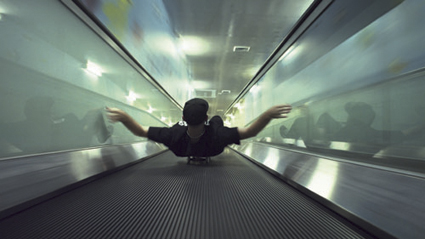
Shaun Gladwell, Parallels (2011), synchronised dual channel HD video
courtesy the artist and Anna Schwartz Gallery
Shaun Gladwell, Parallels (2011), synchronised dual channel HD video
SHAUN GLADWELL’S FORTHCOMING EXHIBITION AT ACMI, THE MAJOR COMMISSION STEREO SEQUENCES, PROMISES TO BE ONE OF THE ARTIST’S BOLDEST STATEMENTS TO DATE. WORKING ON A GRAND SCALE, THIS SHOW AFFORDS GLADWELL THE OPPORTUNITY TO CREATE A NEW SERIES OF WORKS WHICH GENERATE A PATTERN OF INTERCONNECTED NARRATIVES—A DIALOGUE BETWEEN PERFORMER AND PERFORMER, PERFORMER AND MACHINE, BODY IN LANDSCAPE AND ONE IN WHICH THE VIEWER BECOMES AN ACTIVE AGENT. FOLLOWING ON FROM HIS TECHNICALLY EXTRAVAGANT VIDEO WORKS OF RECENT YEARS, GLADWELL’S CONCERNS FOR THIS SHOW REFLECT A NEW MODESTY TO HIS PRACTICE, WITH A REVIVED INTEREST IN THE EXTREMITIES OF THE RELATIONSHIP BETWEEN THE SUBJECT AND ITS REPRESENTATION ON FILM.
For this exhibition, Gladwell returns to some of the guiding principles of his early experiments in the late 90s where, for example, he explored the freedoms of the early Handy Cam, turning the camera on himself as he skateboards through the streets of urban Australia. The final artwork, he states, reveals itself in the final edit, and while the new works are clearly more involved, the drive for undirected experimentation is evident.
soldiers: dance with camera
The logic for this show evolved from a commission by the Australian War Memorial, the institution somewhat controversially appointing Gladwell as their Official War Artist at the end of 2009. Locating himself in southern Afghanistan, Gladwell ran a series of ‘workshops’ with two soldiers. During this process, he handed the camera to the soldiers to record each other acting out a series of self-generated mirroring movements. Through repetition, a constant in Gladwell’s oeuvre, the work documents the ritualistic practice of gestural movement and by default taps into the commitment and focus which is central to the soldiers’ training and performance in the extremes of war.
Gladwell refers to this action as akin to “an early form of dance” and it is clear that the suspension of consciousness, which the soldiers develop through the work, is the artist’s aim. The dedication and focus of the subject, be they skateboarder, break-dancer or soldier are the drivers for Gladwell’s search for the ‘authentic.’ While on initial approach this may be easily dismissed as cultural appropriation, it becomes clear that Gladwell’s impetus is to capture on film the intense psychological states that occur when the body is placed in extreme situations.
In handing over the camera to the performer, the authorship of the work is largely relinquished. This seems not to perturb Gladwell who places his practice firmly in the context of Dan Graham’s performative experiments in the 1970s: “I particularly loved the idea of him not reporting the work but enabling the audience to do so.” Like Graham, Gladwell wants to test the conventions of the audience and performer relationship, a practice clearly rooted in his own origins in urban sports and street cultures. Through the gesture of self-documentation, Gladwell is almost testing his own levels of perception; as for the viewer, we are there to accompany him on this journey of curiosity.
figures, machines, landscape
Shaun Gladwell is not concerned with the democratisation of media, a notion that has engulfed our digital age. Though he enjoys his works appearing on social networks and flirted briefly with placing work onto handheld consoles, his concerns are much more discursive—connecting subcultures to cultural traditions. He places cars, helicopters and other machines of transportation into a desert landscape in order to portray the details embedded within these grand gestures. Gladwell references the Romantic German landscape artist Casper David Friedrich and particularly his genre-defining painting Wanderer Above The Sea Fog (1818) which depicts a lone figure standing triumphant at the peak of a mist-engulfed mountain. In Gladwell’s works the individual employs the machine to attempt mastery over landscape, while their anonymity and subsequent insignificance marks this as an ultimately barren act.
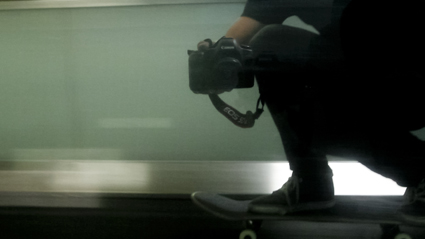
Shaun Gladwell, Parallels (2011), synchronised dual channel HD video
courtesy the artist and Anna Schwartz Gallery
Shaun Gladwell, Parallels (2011), synchronised dual channel HD video
new perspective, new vulnerability
Though now distanced from his early works involving the reappropriation of physical acts into alien environments, Gladwell’s new work, Stereo Sequences, is still rooted in the depiction of the body in space—largely the Australian landscape. His shift of focus from urban to outback was pivotal in Interceptor Surf Sequence (2009) where the cinematic idioms of Australian action movies dictated the overall aesthetic. Within the new works, this landscape is conveyed to the viewer less through the vista of Hollywood than as a point of exploration for the artist for whom this terrain is also unfamiliar. This shift adds vulnerability to the work by replacing the readymade, fast paced aesthetic of Australian action cinema with a more naive consideration of the vast terrain. The boldness of this act reflects the fluidity of Gladwell’s larger practice—he is in a process of exploration and traditional conventions are discarded as necessary. This notable shift in the artist’s work is one of which he is fully conscious: “I like the idea that a signature style can be broken…if an idea demands a certain methodology then you have to go with it.”
a crossfire of images
The monumental scale of the films will be key to the presentation of the final works at ACMI. Each film is presented as a pair, which the audience passes through a central corridor. Gladwell intends that walking through these coordinates you make decisions as a viewer, again suggesting a nod back to Dan Graham’s experiments, with the audience caught in what Gladwell describes as a “hall of mirror gazes.” Within this crossfire of images, the viewer encounters simultaneous movement of the subject in real-time, with the recorded figures at times looking at each other and sometimes moving within the frame. However it is the body’s relationship to machines—helicopters, cars, skateboards—in the environment that drives the motion in this series, creating a comparative study.
the urban edge in a spin
The urban edge to Gladwell’s practice prevails within this show, particularly in a series of films focusing on the singular performative act of spinning. Engaging a range of practitioners from break-dancing, skateboarding and capoeira, Gladwell ran a series of ‘relational workshops’ in which he asked each practitioner to perform the act at its most extreme within their own discipline. The actions recorded, Gladwell then shared footage with the other groups in an attempt to engender a form of cultural fusion around spinning. Through this process, the rotation of the body in space becomes apparent, amplified through Gladwell’s use of a fixed, overhead camera point which frames the body in motion. Gladwell will install these films as a ceiling projection suspended above the audience inviting the viewer to address them from a horizontal position. The Romantic element of the artist’s practice is again evident as the original, fast, physical act mutates into a series of ethereal movements forming a never-ending choreography in space.
It is hard to pin Shaun Gladwell’s practice to a single genre. He is at once a landscape artist, a social documenter, choreographer and performer. His work, however, provides a moment to reflect on what it means to be a solitary being in a dense and hyper-paced world. His empathetic interventions into subcultures and landscapes exaggerate the potential and limitations of the body while reaffirming the value of the individual self. The most ambitious works to date from Shaun Gladwell’s prolific output will leave you feeling at once displaced, overwhelmed and fragile but, above all else, alive.
ACMI, Australian Centre for the Moving Image, Shaun Gladwell: Stereo Sequences, Federation Square, Melbourne, June 1-Aug 14; www.acmi.net.au
RealTime issue #102 April-May 2011 pg. 26
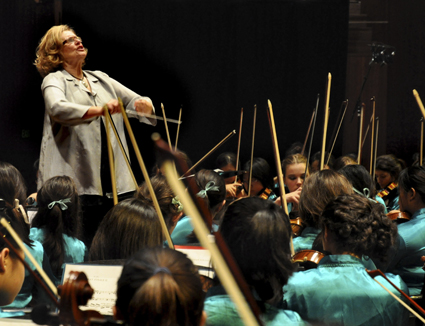
Mrs Carey’s Concert, Bob Connolly, Sophie Raymond
BOB CONNOLLY’S DOCUMENTARIES HAVE AN EXTRAORDINARY QUALITY, LIKE ROUNDED WORKS OF FICTION. THE WONDERFUL PNG TRILOGY—FINDING THE CHARACTER THAT LINKED FIRST WHITE CONTACT WITH A TRIBAL WAR IN THE PRESENT; THE LAST MINUTE MACHINATIONS THAT DECIDED THE LEICHHARDT MAYORALTY IN RATS IN THE RANKS; THE BRITTLE EMOTIONS BEHIND ACADEMIC FACADES IN FACING THE MUSIC.
In Mrs Carey’s Concert—Connolly’s first documentary in a decade and made without the balancing force of his late wife and film-making partner, Robin Anderson—we’re once again suffused with musical emotions. But we also have good and bad leads, two last minute crises and a cathartic triumph. What’s amazing is that the world in which Connolly and new film-partner Sophie Raymond are operating is a private girls’ school as it spends 18 months working up to a massive concert in the Sydney Opera House—an ethos apparently quite beyond the predictability or manipulations of drama.
And yet Chinese immigrant Emily Sun makes both character and musical leaps over that period to progress from a kid vaguely at risk to a model of self-knowledge, as well as knocking off a damn fine performance of the Bruch Violin Concerto’s first movement at 12 weeks’ notice. We realise she couldn’t have done it without Head of Music Karen Carey’s subtle mind games. But would Emily have discovered that without this film?
Even more ethically tight-roped is Iris Shi—another Chinese-Australian girl at the ethnically diverse Methodist Ladies College—who must have adored having her leather-jacketed, gum-chewing badness given star billing. Her cool boasts of exploiting her teachers’ weaknesses are linked on screen to Mrs Carey’s one moment of self-doubt in a saga that’s intended to confirm the life-changing power of music. One has to wonder, though, whether Iris’s life was changed one iota by her minor musical role singing in the Slave’s Chorus from Aida?
To achieve such delineation, time was of the essence. Eighteen months filming allowed Connolly’s camera to become part of the MLC furniture, even in the cramped staff quarters where conferences and the cajoling of girls occur. But another 18 months was needed to turn 263 hours of random events into this coherent story: editing credits to Sophie Raymond and Ray Thomas. What story streams or high dramas were left out?
Certainly the wider school story was brushed aside—you’d think they did music all day and every day; not just 45 minutes a week. But multiple cameras at the concert meant we not only got a ‘Last Night of The Proms’ detail of the musicians we’d got to know enjoying their finest hour; we also saw the backstage dramas of Mrs Carey nearly losing a star wind player and actually losing her conducting score, and some grainy, Breughellian images of tired and tense teachers undergoing the finely balanced intensities of the concert.
There’s a naughty schoolboy just under Bob Connolly’s hide. One of film’s joys is the alert camera work that picks up the cheeky reactions of the girls, unseen by their teachers, and an episode with a sabotaged computer took me right back to the ‘invisible’ snowball left in the middle of my boys’ school Music Room—its existence denied by the whole class. Gender equality at last!
And how marvellous that everyone involved—from precious parents to mocked teachers—gave their assent to appear unvarnished in the film.
But, since the project emerged from Connolly’s recording of a previous Mrs Carey’s concert when another violinist was boosted up to concerto level, it certainly distinguished this version that Emily Sun’s back-story has enough human and musical twists to both underscore the constant battle between the technicalities of just playing the notes and finding emotion in both the score and herself, which carries this film into the realm of the ‘migrant overcoming the odds’ story.
Mrs Carey’s biennial triumph of the will is made bitter-sweet by her comment that her pupils will leave school and she’ll lose them: “we have to start all over again…”, a wistfulness underlined by the credits ending with the cacophony of recorders that began this musical progress. But that’s the teacher’s inevitable lot. And Mrs Carey won’t only have this film as succour in her retirement—she’ll also have the sound of Emily Sun’s career, which has already progressed to the Royal College of Music in London. Will she follow Iris Shi so keenly, though?
Mrs Carey’s Concert, directors Bob Connolly, Sophie Raymond, camera Bob Connnolly, editors Sophie Raymond, Ray Thomas, producers Helen Panckhurst, Bob Connolly, Music Films, 2011, 95mins; www.mrscareysconcert.com
Mrs Carey’s Concert premiered at the Bigpond Adelaide Film Festival and screens throughout Australia from April 28, except Brisbane from May 5
RealTime issue #102 April-May 2011 pg. 25
© Jeremy Eccles; for permission to reproduce apply to realtime@realtimearts.net
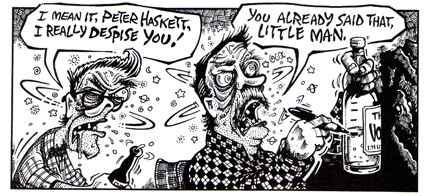
Shut Up Little Man! An Audio Misadventure, director Matthew Bate
“FILMS DON’T CHANGE THE WORLD. PEOPLE WHO SEE THE FILMS CHANGE THE WORLD.” THIS IS THE MOTTO OF GIL SCRINE’S CINEMA VENTURES, A DOCUMENTARY DISTRIBUTION MODEL, PRESENTED AT ADELAIDE’S HILTON HOTEL AS PART OF THE 2011 AUSTRALIAN INTERNATIONAL DOCUMENTARY CONFERENCE. ALONGSIDE THE HOST OF INTERNATIONAL AND NATIONAL SPEAKERS WHO PRESENTED KEYNOTE ADDRESSES, MASTER CLASSES AND PANEL DISCUSSIONS, SCRINE WAS NOT ALONE IN STRESSING THE NEED TO RE-EVALUATE ESTABLISHED MODELS OF DOCUMENTARY FUNDING AND DISTRIBUTION IN ORDER TO EMBRACE NEW METHODS OF CONNECTING WITH AN AUDIENCE.
Over four days, conference delegates were presented with case studies of recent TV and web documentary success stories and conversations on documentary craft, as well as alternative strategies for funding and development. Running alongside the BigPond Adelaide Film Festival, where for the second time, the F4 (First Factual Film Festival) was able to showcase the work of emerging documentary makers, the 2011 conference marked the launch of P2P: CO-CREATE, a networking initiative designed to connect Australian factual content creators with international partners. With the swag of national and international commissioning editors, acquisition managers and executive producers signalling what AIDC Executive Director Joost den Hartog describes as “a new found confidence” in the TV sector, one can only hope that many a deal was struck.
In a session exploring global trends in factual television programming, Stephen Harris of American A&E Television Network spoke of the need for programs to feature big characters, high stakes and unique access—traits undoubtedly present in Channel 4’s 2011 breakout hit, Big Fat Gypsy Weddings. With 8.7 million UK viewers tuning in for the second of four episodes, this program’s success suggests that audiences want to connect with characters living in unusual or unfamiliar worlds. This premise has been explored locally (albeit on a smaller scale) through a community-made webisode project, Big Stories, Small Towns, also presented at AIDC. Giving voice to local groups in three South Australian towns, this innovative project offers its audience insight, for example, into the Longriders Motorcycle Club in Murray Bridge. With a clear community focus these stories tap into larger themes of belonging and identity.
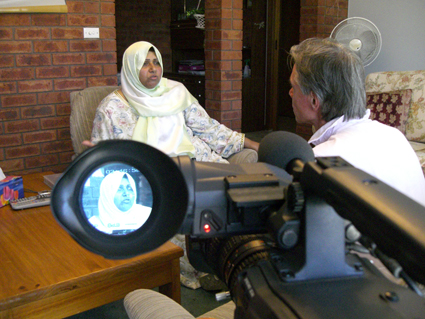
Amal Basry with Steve Thomas, Hope
cinema ventures
Drawing on the DIY spirit of 1970s film co-ops, Cinema Ventures is an exciting attempt to reconnect with audiences at grass roots level. As Gil Scrine commented, this means getting films and the social issues they explore out to people in rural locations. With a focus on community, not unlike that of Big Stories, Cinema Ventures takes a philanthropic approach to the not-for-profit distribution of documentary. Inspired to find solutions to the difficulties facing community groups when attempting to undertake effective film screening fundraisers, the project began with an eight-leg tour of Steve Thomas’ film Hope, a documentary partly funded by refugee support groups. Screening in venues such as community halls and churches in remote parts of Australia, this survival story of a shipwrecked refugee boat drew audiences of up to 200 people at a time, with the filmmaker present to discuss his work.
Most surprisingly, the community group that initiated or helped organise the screening was able to keep the box-office takings, amounting to between $1,300 and $3,000 per screening. This is the beauty of Cinema Ventures: with the filmmaker receiving a standard film hire fee for each screening, and able to capitalise on revenue gained by undertaking guest lectures in local schools and businesses, it seems that everyone is a winner. Scrine commented that the industry was crying out for a new model of distribution. With many cinema chains owned by distributors (Dendy, owned by Icon, being one example) small, independent films often find traditional paths difficult to access. “You can easily get done down in the world of distribution,” remarked Scrine. “It’s hard to navigate.”
Since the initial tour of Hope, a website has been developed with assistance from Screen Australia and several state agencies, and a slate of films is being assembled. Scrine encourages filmmakers to think of Cinema Ventures as a distributor that could be attached to projects in the development stage, assisting with the raising of production funds through philanthropy. As one AIDC attendee commented, the strength is in Cinema Venture’s database, a list of remote venues, screening contacts and audience information that can assist with the organisation of a tour. With the ultimate goal of establishing a network of occasionally used community cinemas in rural locations, Scrine is already in talks with groups in Wynnum and Stradbroke Island.
“It’s amazing after a screening when people have to pack the chairs away, when someone says, ‘come back to my place and we’ll open a bottle of wine and have a party.’ That sort of thing doesn’t happen at Hoyts.”
from the sunroom to sundance
In the wake of the Sundance Film Festival screening of the South Australian documentary feature Shut Up Little Man (Sophie Hyde, Matthew Bate), the From the Sunroom to Sundance panel discussion elaborated on models of documentary development and production funding currently in place at the South Australian Film Corporation. Alongside Matt Bate, Sophie Hyde and Bryan Mason of the prolific Adelaide-based company Closer Productions, SAFC CEO Richard Harris explained how the programs Film Lab and the Documentary Innovation Fund have allowed for the production of stories that may not have been made otherwise.
In the case of the Film Lab feature film development and production initiative, the focus involves developing people, rather than projects. Although not initially designed for documentary production, it was soon apparent that Matt Bate’s Shut Up Little Man was an international project well suited to the initiative’s tight budget constraints. Bate commented that the project had received little interest from the ABC and SBS due to the American nature of the story, and the film would not have been made without SAFC support. The guaranteed production funding meant that the director could establish sound relationships with the subjects of the film in the development phase as there were no questions as to the certainty of the project. As well as receiving a special mention in the BigPond Adelaide Film Festival’s official competition, Shut Up Little Man is currently negotiating a deal for theatrical distribution in the USA and Canada following its successful reception at Sundance.
The SAFC Documentary Innovation Fund is unique in that it backs projects without the constraint of having a broadcaster attached prior to production. For Sophie Hyde this meant the opportunity to break out of the emerging filmmaker mould with her feature length project Life in Movement about the late dancer and choreographer Tanja Liedtke. SAFC support meant that Hyde was able to access additional development and production funds from Screen Australia and the Adelaide Film Festival, where the film premiered to rave reviews. SAFC Director Richard Harris commented that the two SAFC initiatives are not about ignoring old methods of development, but rather, embracing new ones. As session moderator Julia Overton commented, “It’s all about backing talent.”
Other AIDC conference highlights included a masterclass on “maximising the story” by producer, John Smithson (127 Hours, Touching the Void) and from Dr David Gallo from the Oceanographic Institution’s keynote address on the wealth of deep water stories that wait to be told. (Did you know that there are lakes and waterfalls underwater? There were certainly many AIDC delegates left open mouthed when Gallo provided still images of the phenomenon.) With these and many other speakers on the guest list, AIDC was an opportunity to pose questions about rapidly changing methods of development, production and audience engagement, as well as how to network and deal. As Smithson concluded, it’s about finding the small human story that paints a bigger picture. Then it’s about getting that story out there.
AIDC (Australian International Documentary Conference) 2011, Adelaide Hilton, March 1-4
RealTime issue #102 April-May 2011 pg. 24
© Kath Dooley; for permission to reproduce apply to realtime@realtimearts.net
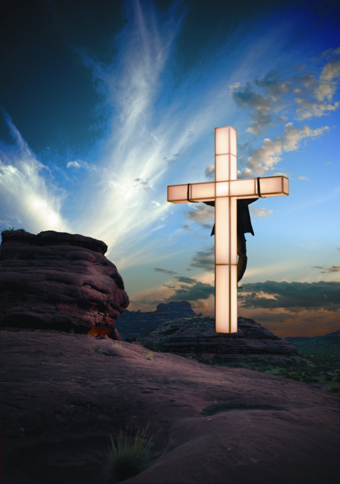
Warwick Thornton, Stranded, 2011, film still, commissioned by Adelaide Film Festival Investment Fund 2011
© the artist
Warwick Thornton, Stranded, 2011, film still, commissioned by Adelaide Film Festival Investment Fund 2011
AT THE EXHIBITION OPENING, AMID ENDLESS GLASSES OF CHENIN BLANC, THE GUESTS WERE FORTUNATE ENOUGH TO WITNESS A TRADITIONAL KAURNA SMOKING. LOCAL ELDER UNCLE LEWIS O’BRIEN THEN WELCOMED ARTISTS, CURATORS AND GUESTS IN KAURNA LANGUAGE TO STOP(THE)GAP, AN INTERNATIONAL EXHIBITION OF INDIGENOUS MEDIA ARTS, BEFORE ADDING A BRIEF FOOTNOTE IN ENGLISH: “WE HAVE BEEN WELCOMING VISITORS TO OUR LAND FOR THOUSANDS OF YEARS. THE PROBLEM IS WE’VE NEVER TOLD THEM TO GO HOME.” HIS COMMENT MET A GENERAL SILENCE.
A similar frankness runs through curator Brenda L Croft’s introductory essay in the exhibition catalogue. In an aggressive and confessional style Croft outlined her infuriation at being Indigenous and intelligent in a place as heart-poundingly and mind-numbingly stupid as mainstream Australia, where even the most elementary reflection on colonisation and the marginalisation of Indigenous Australians is consistently and wilfully avoided. It was an angry and perhaps reckless decision to share such unrestrained thoughts. For daring to express her outrage in forthright political language Croft was ruthlessly attacked by The Australian’s Christopher Allen in a review less concerned with discussing the artworks on display than with celebrating the writer’s tiresomely cynical politicking.
Such political directness was not, however, to be found in the artworks on display in Stop(the)Gap. Indeed, the exhibition is surprisingly non-confrontational. Something quite different (and often more complex than) direct ideological or political discourses on ‘Indigeneity’ is on offer here. Suggesting no easy answers, or even difficult answers, the conceptual implications of the seven featured artworks (of which I will discuss four) are instead fleeting and poetic, grasped for a moment.
The elusiveness of the artworks on display at Stop(the)Gap points to what might be understood as the exhibition’s determining ethos. Opening the forum held to discuss the exhibition, curator Croft (who coordinated the choices of her overseas guest curators) clearly explained her key goal for the exhibition as a movement (or series of movements) beyond colonial forms of representation towards Indigenous self-representation. And this, of course, means a movement into the unknown. In Croft’s words:
“Indigenous communities around the globe share colonial histories relating to dispossession, injustice, inequity and misrepresentation. Even in the 21st century, indigenous art continues to be negatively configured through the historical contexts of Western art.” Exhibition catalogue.
Alan Michelson’s large four-channel work TwoRow II (2005) stands as an emblematic expression of this ethos. Michelson (a Mowhawk member of the Six Nations) is clearly aware that a large part of the contemporary Indigenous artist’s energy must be spent bending, breaking, transgressing, transcending the constrictive and static representations of Indigeneity perpetuated by colonial discourses. That’s a no-brainer. Michelson is also aware, however, that there are two sides to this agenda. In TwoRow II, two horizontal bands of purple and white images (alluding to a belt woven by the Native American Haudenosaunee people to mark their 1613 treaty with Dutch colonists) denote the two sides of the Grand River in southern Ontario, Canada. One bank is populated by non-Native townships. The other is the site of a Six Nations reserve. Travelling in both directions along the river, the viewer absorbs these juxtaposed rows simultaneously (along with the contrasting Indigenous and non-Indigenous stories and tourist commentary played on loudspeakers).
For Michelson the river both links and divides the Native and the non-Native. Ideas of ‘Coloniality’ (as well as ‘Indigeneity’ or ‘Aboriginality’) must therefore be opened up for questioning. The Colonial and Indigenous are interrelated and in a constant state of change. Quite literally, Michelson’s work keeps moving. The literal two-sidedness of Two Row II undermines the viewer’s desire to focus on one of these sides independently of the other. There is no stationary reference point.
Two other interesting and very different large-scale works came from Canadian artists Rebecca Belmore (of Anishinaabe-Canadian heritage) and Dana Claxton (of the Hunkapa Lakota Sioux nation). Noting their obvious differences, Canadian curator David Garneau (who selected both works for exhibition) emphasised his interest in their paradoxical commonality. Beginning at either end of a hypothetical Indigenous artistic spectrum, Belmore and Claxton seem to be moving towards something in the middle, some common problem or ideal perhaps. This dialectical relationship was emphasised by Croft, who positioned the two works opposite one another on the ground floor of the Samstag Museum.
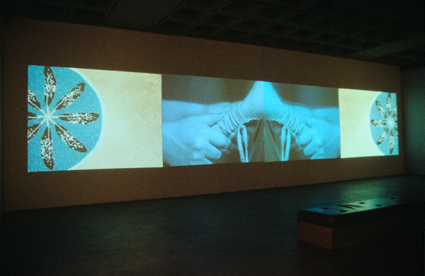
Dana Claxton, Rattle, 2003, installation view
© the artist
Dana Claxton, Rattle, 2003, installation view
At one end, Claxton’s Rattle (2003) is one of the most beautiful examples of installation art in motion I have seen. A difficult work to describe in concrete terms, Rattle is in the artist’s own words “a visual prayer attempting to create infinity…[much] like a palindrome” (catalogue). Across four screens—the inner two mirroring and the outer two mirroring—Claxton offers the viewer-listener a hypnotic and strangely powerful aural-visual experience of perceptual and perpetual rhythm. It is a delicately made and extremely impressive work, of living art over artefact, invoking traditional Sioux singing, music and movement without conceding to any coy idea of the ‘traditional.’
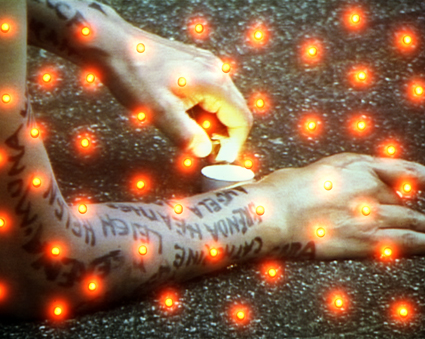
Rebecca Belmore, The Named and the Unnamed, 2002, video installation, Collection of the Morris and Helen Belkin Art Gallery, The University of British Columbia
photo by Howard Ursuliak, © the artist
Rebecca Belmore, The Named and the Unnamed, 2002, video installation, Collection of the Morris and Helen Belkin Art Gallery, The University of British Columbia
Rough, handheld and with a markedly street aesthetic, Rebecca Belmore’s The Named and the Unnamed (2002) seems to be everything that Rattle is not, certainly no delicate expression of Indigenous spirituality. Also seemingly the most overtly political work of the exhibition, The Named and the Unnamed is an installation based around Belmore’s performance work Vigil (in fact it is, more or less, a recording of this performance projected onto a wall sparely quilted with small lights perhaps indicative of the women lost—the subject of the work). Approaching performance as a sacred act, Belmore acts out a series of painful rituals on a street corner in downtown Vancouver, a site where many missing and now presumed murdered Indigenous prostitutes worked. It’s not entirely clear as to precisely why the artist performs particular rituals (stripping roses with her teeth, nailing her dress to telephone poles) but that’s how rituals work. In the exhibition notes, Jolene Rickard suggests Belmore’s intent is to set right or balance imbalance (“Rebecca Belmore: Performing Power,” 2005). With no material justice coming from authorities who have shown little interest in pursuing the cases of these poor, marginalised, Indigenous women, Belmore aims at a higher spiritual justice for these young souls in trauma. It is a problematic but also very arresting piece, demonstrating that sacredness has nothing, essentially, to do with style.
Finally, there’s Warwick Thornton’s Stranded —a difficult work to pin down, all the more so coming from the director of the realist masterpiece Samson and Delilah. On entering the space—with 3D glasses and complementary popcorn in hand—we see the artist himself, nailed to a kitsch fluorescent cross that spins slowly, hovering above a richly coloured central Australian landscape with wide open skies and waterholes. At the base of the cross is a skull and crossbones. Dressed in a drover’s outfit (a reference to Aboriginal stockmen?), Thornton seems at first to be feigning an heroic machismo, but then, in close-ups, is revealed as simply drowsy: sleeping, yawning, head slumping. On his chest (in intense close-up) are the bloody traces of a whipping.
The only explanation we are offered in the exhibition notes is that Stranded was inspired by a drawing the artist made when six years old, under which he wrote, “When I grow up I want to be just like Jesus.” Thornton’s decision not to attend the exhibition forum only reinforced a sense of his reluctance to explain anything more about the work. The ironic tone (the ludicrous cross, the costume, the flaccid hero) suggests a playful critique of European Christianity’s influence on First Australians, or of Thornton himself. But that doesn’t seem nearly enough. Perhaps what we are seeing here is the juxtaposition not only of ideologies but of histories: the ‘newness’ of the flash cross (Christianity) highlighted by the ‘ancientness’ of the surroundings (Country, Dreaming). We are also possibly witnessing a representation of a ‘lost’ Aboriginal generation, Thornton’s own, no longer under missionary control, yet still nailed to the cross, detached and hovering above the Land. Perhaps in Stranded we encounter another ‘muddying of the waters:’ art that worries at the line between Indigenous and non-indigenous, elusively pushing beyond established concepts.
If it can be put into words, Stop(the)Gap seems to outgrow old restrictions, naturally and organically, advancing towards new, as yet unformulated conceptions of Indigenous self-representation. The role Brenda Croft assumes as curator is unusually active in this respect. With a second chapter of Stop(the)Gap due for exhibition in various Adelaide gallery spaces in October, Croft envisions the exhibition as spreading worldwide, in a state of continual relocation and reconfiguration.
Stop(the)Gap: International Indigenous arts in motion, curator Brenda L Croft, artists Rebecca Belmore, Dana Claxton, Alan Michelson, Nova Paul, Lisa Reihana, Warwick Thornton, Samstag Museum, Adelaide Film Festival, Feb 24-April 21
RealTime issue #102 April-May 2011 pg. 23
© Tom Redwood; for permission to reproduce apply to realtime@realtimearts.net
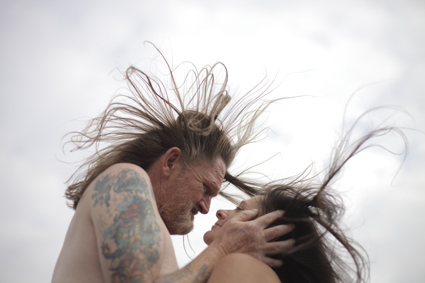
Daniel P Johnson, Leeanne Letch, Hail, Amiel Courtin-Wilson
photo Germain McMicking
Daniel P Johnson, Leeanne Letch, Hail, Amiel Courtin-Wilson
THE 2011 BIGPOND ADELAIDE FILM FESTIVAL FEATURED A STRONG LINE-UP OF NEW AUSTRALIAN FILMS, SIGNIFICANT OVERSEAS WORKS AND, CHARACTERISTICALLY FOR THIS INNOVATIVE FESTIVAL, DIVERSE SCREEN WORKS THAT RICHLY ILLUSTRATED THE HISTORY AND POTENTIAL OF A RAPIDLY MUTATING MEDIUM. THESE INCLUDED A LIVE BENSHI PERFORMANCE, MUSIC FOR STAN BRAKHAGE FILMS (SEE CHRIS REID’S REVIEW), FESTIVAL GUEST SPECIAL EFFECTS LEGEND DOUGLAS TRUMBULL, AN ENGROSSING TRACEY MOFFAT RETROSPECTIVE AND THE INTRIGUING STOP[THE]GAP INTERNATIONAL INDIGENOUS MEDIA ARTS EXHIBITION AT THE SAMSTAG MUSEUM OF ART (SEE BELOW AND THOMAS REDWOOD’S RESPONSE).
The Australian International Documentary Conference (AIDC) was also held during the festival contributing informative and provocative discussions about innovation, funding and distribution (see Kath Dooley’s report).
In just over a week we sampled the festival’s diversity of forms and practices in an extensive program that nonetheless retained the requisite sense of intimacy that makes an event like this work its magic. However, slotting ourselves into half the duration of the program meant missing the competition winner Incendies (Canada/France, 2009) directed by Dennis Villeneuve who received the $25,000 10 News International Award for Best Feature Film. Special Jury Mention was granted to Shut Up Little Man! An Audio Misadventure (Australia, 2011) a documentary directed by Adelaide filmmaker Matthew Bate. Meanwhile, word of mouth also rated highly the festival’s opening night film Bob Connolly’s Mrs Carey’s Concert (see Jeremy Eccles’ review) and hotly debated Justin Kurzel’s Snowtown, admiring the film for its superb craft but disturbed by its scenes of sustained violence.
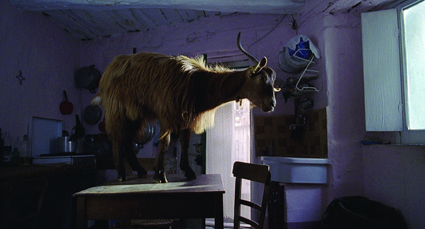
The Four Times, Michelangelo Frammartino
michelangelo frammartino, the four times
In RealTime 101 Tom Redwood sampled the festival program, seeing the Kurdish director Shahrah Alidi’s Whisper with the Wind, winner of the Young Critics Award at Cannes, Year Without A Summer by Malaysian director Tan Chui Mui, Michelangelo Frammartino’s The Four Times (La Quattro Volte) and Romanian director Radu Muntean’s Tuesday, After Christmas (RT101). The Four Times proved particularly memorable, a sublime fiction that does away with language and conventional plotting, tracking the mysterious transmission of a soul from nature to man to domesticated animal to tree and—via ritual and artful rural manufacture—to fire, smoke and charcoal. All of this is achieved without any sense of religiosity (a seasonal church pageant is quite comical if juxtaposed with a moment of poignancy) and constantly surprises with its unpredictability and glorious cinematography. We’ll certainly now regard goats in a different light, observed here with the same acuity usually given human subjects. Surely The Four Times must have been a strong contender for the best feature award and, surely, it must find its way into other Australian festivals and cinemas. The incredibly elliptical narrative of Year Without A Summer, however, proved a considerable challenge, making even the Apichatpong Weerasethakul’s wonderful Uncle Boonmee Who Can Recall His Past Lives seem a relatively straightforward exercise.
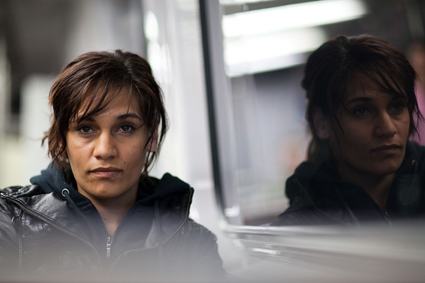
Shai Pittman, Here I Am
beck cole: here i am
Beck Cole prefaced the screening of her first feature, Here I Am, by declaring it “a tribute to the women in my life.” It’s a film about women who have lost their place in the world and most of its players are women. The plot has a familiar feel—a young Indigenous mother, Karen (Shai Pittman), is released from prison into a half-way house; unskilled, she struggles to get a job while at the same time attempting to retrieve her child from her embittered mother (Marcia Langton) who has given up on her addict daughter. However, the spontaneity of the performances (mostly from non-professionals), the often witty screenplay (ample evidence of the Indigenous sense of humour that counters misery where it can) and Warwick Thornton’s luminous cinematography take us into less familiar territory. The scenes between the women in the half-way house are some of the film’s best (especially a late night party), revealing the diversity of backgrounds, troubles and personalities and the ways in which this temporary community is enabling for Karen—offering her support, companionship and an understanding of how others cope, or not.
A fascinating aspect of Here I Am is that most of the institutional figures that Karen encounters are Indigenous—job consultants, prison guards, social workers. And a firm, forceful and droll bunch they are, as if Cole is saying, with hope, that the world is changing: no longer is it a matter of Indigenous people oppressed by white police and bureaucrats, but something more complex. The film’s measured optimism is tempered, however, by some emotionally demanding scenes that leave despair on the agenda—a girl taken back into custody, Karen’s monitored meeting with her child and the tense encounters between Karen and her mother. Pittman plays her role with a quiet directness and an affecting watchfulness, as if slowly waking up to the real world, while Langton’s mother appears cruelly stubborn, unyielding almost to the end when the camera closes in on a look that says forgiveness might just be possible. With its tight focus on an imperiled woman in a transient community bounded by a less welcoming if stable world, Here I Am is an assured, finely crafted film, with some its greatest rewards to be found in the realism of its unaffected ensemble acting.
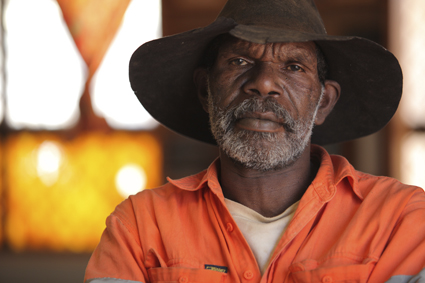
Lloyd Doomadgee, brother of Cameron Doomadgee, The Tall Man, Tony Krawitz
photo Hamish Cairns
Lloyd Doomadgee, brother of Cameron Doomadgee, The Tall Man, Tony Krawitz
tony krawitz: the tall man
Tony Krawitz’s documentary The Tall Man painfully captures the horrendous ambiguities surrounding the death of Mulrunji Cameron Doomadgee on Palm Island in 2004 and the failure to convict police sergeant Chris Hurley for his part in the man’s death. Like Chloe Hooper’s award winning book of the same title, this is a film that attempts to deal with both (or more) sides of a story that is deeply complex given the character of Queensland colonialism, its police history and the cruel peculiarities of Palm Island, once run like a penal colony and still a place where people don’t belong to the land. The book is credited with inspiring the film, though the documentary doesn’t have Hooper’s first person presence nor her close, if shifting, relationship with the women of Palm Island—they’re certainly not as central to the film as in the book, nor is their strength as fully acknowledged.
Telling differences between book and film aside, The Tall Man stands on its own as an indictment of a system that has ruined the lives of Indigenous people and then held them guilty for the outcome. Krawitz combines recent interviews, historical stills and film footage, news reports, court case recordings and rough documentation of the rioting after Hurley was not charged. At times, as we take an account of an aspect of the unfolding drama, Krawitz cuts away to children diving into the sea, a boy riding a horse, as if some normal pleasures are being pursued amid all the pain. At other times his camera suggests anxiety and foreboding, wandering the nighttime streets of Palm Island. The rioting scenes (seen at greater length in Vernon Ah Kee’s Tall Man installation at the Australian Experimental Art Foundation), Hurley’s re-creation of the ‘tragic accident’ scene, the interview with Cameron Doomadgee’s son Eric before he suicides, the massive police force rally on behalf of Hurley, these and other images alongside the emotionally worn faces of victims and witnesses become indelibly painful.
vernon ah kee, tall man
Vernon Ah Kee’s large-scale video installation, Tall Man, fills the long wall of the Australian Experimental Art Foundation gallery with personal and archival news footage of the Palm Island riot, shot on the streets and from within the embattled police buildings. “They’ve just heard how Doomadgee died…Game’s on, we’re in trouble,” cries a policeman, issuing orders as projectiles crash into the building. All we see are his fumbling hands. “Put a few shots in the air to scare the shit out of the fuckers!” These trapped men know they might be killed. People make speeches in the street: in a telling moment, as a woman speaks passionately to the media (“We are an oppressed people”), someone cries out, “You, the media, you gonna put this on…no one will stop this tidal wave.” Somebody else yells, “Don’t edit it!” (Elsewhere the people of Palm Island are described as illiterate with no understanding of the court system—the consequence: “their fear is our fear.”) But amid the images of anger and confusion, Ah Kee interpolates footage of two children watching the burning police station from a distant hill, and the aerial view from the plane bringing in police reinforcements.
If Krawitz’s film unfolds the whole tragic story of Palm Island for our reflection, Ah Kee in 12 minutes has created an artistic, political document from the crude documentation of eruption of anger, fear and panic, multiplying the same image simultaneously across the four screens in one contiguous frame or mixing and juxtaposing discrete images to unnerving effect. It is a work that is at once contemplative and deeply disturbing. We are well used to the news media’s obsessive repetition of a small number of images that suit their purposes. Here Ah Kee rhythmically fixes our attention on video in the public domain that we might otherwise not be aware of and shapes it for our contemplation. If you’ve read Chloe Hooper’s book or you’ve seen Krawitz’s film, or done both, you identify key figures, filling in names not provided here, placing incidents and speeches, ascribing meaning—an eerie experience, as if of recognition. The inclusion of Ah Kee’s Tall Man video installation in the Adelaide Film Festival is an indication of the expanded vision of film and media arts that has been the mark of this event since its inception.
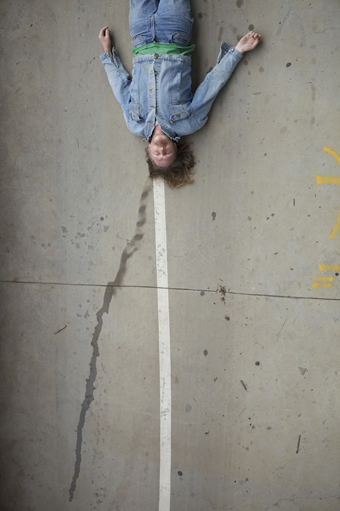
Daniel P Johnson, Hail, Amiel Courtin-Wilson
photo Germain McMicking
Daniel P Johnson, Hail, Amiel Courtin-Wilson
amiel courtin-wilson, hail
Amiel Courtin-Wilson’s documentary feature Bastardy, about actor, singer, potter and former criminal and addict Jack Charles, is blessed with brutal frankness, inherent sadness and remarkable immediacy in its embrace of a wounded man who nonetheless evinces energy, wit and creativity. Hail, Courtin-Wilson’s first drama feature, is also rooted in the life of someone who is very real, Daniel P Jones, another man associated with crime and drugs, a 50-year-old ex-convict who likewise found refuge in the theatre. In Hail, Jones plays Dan someone it seems very much like himself; the film’s plot, says Courtin-Wilson, is fuelled by the stories Jones told the director about himself and his milieu. Like Charles, Jones has a touch of the poet, but his character’s demeanor is cool to cold and, when on edge, restless, obsessive and downright dangerous.
Hail is a drama feature that deftly manages to fuse documentary immediacy (fluid hand-held camera work, raw dialogue) with carefully constructed scenography built around lyrical editing and richly textured and adroitly framed widescreen cinematography (Germain McMicking). It’s a big screen, immersive experience.
Just out of prison, Dan comes home to his girlfriend Leanne (Leeanne Letch). Initial awkwardness surrenders to a slow build to sexual embrace in extreme visual and aural close-up. The film then relaxes into a job search, funny if it wasn’t so sad. Jones has no resume and admits he’s a former criminal: “but I don’t steal from people I work with.” An employer who takes him on says, “You look like a criminal.” Dan humbly retorts, “I’ll put my teeth in for a start.” Later we see him insert his teeth before a mirror, shyly practising a smile.
After a near fight in a pub, Dan’s old friends, all reformed, gruffly advise him, “You wanna change, we’ll help you.” But all too soon his demons possess him (“I’m a danger to me…something out there wants me dead”), intimacy is too much for him (smashing a birthday cake, he flees the house) and he loses his job after falling from a ladder. Leeanne is murdered by an old drug-dealing flame (or, we wonder, perhaps by Dan himself in a fit of jealousy). Dan immolates her body in a car in snow country, madly stalks and assaults a woman but then with neat psychotic rigour calmly tracks the murderer for the balance of the film, torturing and killing as he goes. The stark beauty of the journey and the relentless suspense are engrossingly sustained but the sudden one-dimensionality of the revenge saga radically thins out the psychological complexities that had been so carefully and convincingly established earlier.
Despite this uneven development, Hail is a remarkable film: Jones and Letch’s performances are excellent in their portrayal of a profoundly uneasy love, cinematography is superb and the script tightly focused, conveying both spontaneity and a sense of craft and purpose. As Courtin-Wilson wrote of his earlier collaboration with Jones (Cicada, 2008): “I interviewed Danny, transcribed that material, edited it, then fed it back to him as honed dialogue in the context of dramatic scenes. In this way Danny is able to truly own the material while performing, thereby transcending the all too common problem of non-actors being given dialogue that never really sits comfortably with them. This technique also circumvents the issues with meandering improvisation as the raw material can be used extremely sparingly in the context of a scene” (http://hailmovie.com).
tracey moffatt: narratives
The Tracey Moffatt retrospective at the Art Gallery of South Australia is focused principally on the artist’s photographic and video works, offering cinematic pleasures of other kinds. Spaciously displayed, the exhibition was a vivid reminder of Moffatt’s gift for merging supreme craftsmanship, humour, pathos and tragedy to make beautiful art with political heft. There are the wickedly funny but revealing collections of movie clips (including Doomed, made with Gary Hilberg, 2007) built around particular themes in which, for example, scenes of women being physically abused become cumulatively more and more shocking while the female assaults on men appear happily vengeful.
The photographic series Up In the Sky (1998) and Laudanum (1999) suggest stills from films of earlier eras (hints of neo-realism and Nosferatu-ish shadow play respectively) that we’ll never see but can imaginatively piece together. Other works are more painterly but still invested with a strong sense of scenography as in Invocation (2000) with its 13 silk screen prints suggesting animation stills inspired, the gallery notes confirm, by Goya, Hitchcock and Disney. One of my favorite series, Scarred for Life (1994/2000), evokes documentary filmmaking with telling stills and suggestive captions (a weeping girl has “found out her real father’s name;” Homemade Handknit 1958—”He knew his teammates were chuckling over his knitted football clothes”). This finely staged retrospective warrants a national tour.
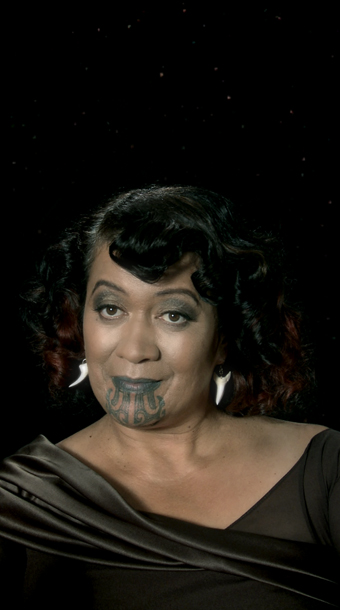
Lisa Reihana, Te Po O Matariki, 2010, video
© the artist, courtesy ARTPROJECTS, New Zealand
Lisa Reihana, Te Po O Matariki, 2010, video
stop(the)gap: nova paul, lisa reihana
Stop(the)Gap curated by Brenda L Croft with overseas guests, presented a fascinating range of works from Australia, Canada, US and New Zealand each working the screen in a unique way, technologically and culturally (see Tom Redwood’s review). Nova Paul’s deployment of “three colour separation, an early cinematic optical printing process” (catalogue) in This Is Not Dying (2010) makes for a magical experience as a slowly panning camera reveals a community coming together, setting tables, and riding motorbikes. But as each movement continues, a trace of it remains and a third image manifests, each a different colour, each at their own lyrical asynchronous pace, suggesting co-existing realities unfolding in the slippage between past and present. Lisa Reihana’s sleekly crafted video images in Te Po O Matariki (NZ, 2010) silently evoke the power of song and ritualised gesture as it is passed through generations of women, hovering in dark space like Maori goddesses.
port projections: rea, genevieve grieves
In Port Projections, organised by the film festival’s Associate Director Adele Hann, Australian artists r e a and Genevieve Grieves projected extant works onto the face of large, old building, part of Port Adelaide’s historic Harts Mill. Arriving at night by car was a bit like going to a drive-in in the old days: a row of cars facing the ‘screen,’ people wandering about, chatting amiably. The Port River lapped quietly by as we looked up at the images overlaying windows, doors and brickwork without greatly surrendering their specificity. Instead the historical dimensions of both works with their 19th century contexts were amplified.
In PolesApart (2009, RT91), r e a, in a long black dress is lost in the bush, pursued by the unseen forces of colonial oppression and finally disappears—as if she’d been the Indigenous subject who never appeared in the ‘nation building’ Heidelberg School paintings. In Grieves’ Picturing the Old People (2006-7) project, the artist reconstructs the making of studio portraits of Indigenous peoples either attired in European garb or carefully arranged as anthropological curiosities, remnants of a dying race. There are moments of both humour and poignancy. For the artists this was something of an experiment: r e a told me that the possibility of further re-platforming of this kind excited her but would require more technical investment in the creation of future works. I could see the potential although it helped that I’d seen the works before and already knew what I was looking at. It might have been a more mysterious experience for others, but true to the Adelaide Film Festival vision here was another opportunity taken to expand our sense of cinema into public space.
charlie hill-smith, strange birds in paradise: a west papuan story
This not-to-be-missed film from Adelaide documentary filmmaker Charlie Hill-Smith is to be screened later this year on SBS-TV, trimmed from 75 to 52 minutes, while the full-length version will be released on DVD. The film was rejected repeatedly by ABC TV, leaving producers Jamie Nicolai and John Cherry wondering if the ABC was afraid of upsetting the Australian and Indonesian Governments. Certainly the Australian population needs to know that West Papuans are being oppressed, their environmental heritage ruined and their mineral wealth appropriated. If that’s upsetting, so be it.
This vigorous documentary effectively weaves together a number of strands. There’s Hill-Smith’s innocent, home-movie visit to West Papua in the late 90s (the beginning he says, “of my own rite of passage;” “we’ve been blundering around an undeclared war”) followed by a later, much more alert trip travelling deep into the country, meeting locals of all kinds and persuasions and interviewing exiled rebels across the New Guinea border (where one of the wives sadly declares the exhaustion of the women as the men talk on and on). Also in the weave is revealing news media footage grimly spilling out the country’s bloody history, and there’s the unfolding story of composer David Bridie working in a studio in Australia with West Papuan musicians on an evolving song. Not least, there are animation passages that vividly evoke a sense of the culture’s identity and challenges featuring birds both metaphorically and in terms of West Papuan mythologies.
Hill-Smith figures quietly in the film, sometimes merely sitting in the frame, writing, sketching, chatting. He tells us that he has emotional ties with an Indonesian family in Java, making his task emotionally harder since his return to the country any time soon is unlikely. Strange Birds in Paradise is a brave film, inventive, informative and provocative. It could make a difference. Australia provides aid to and investment in Indonesia but why, as the film asks, does that have to include military aid when it’s the Indonesian military that plays a major role in the oppression of West Papuans?
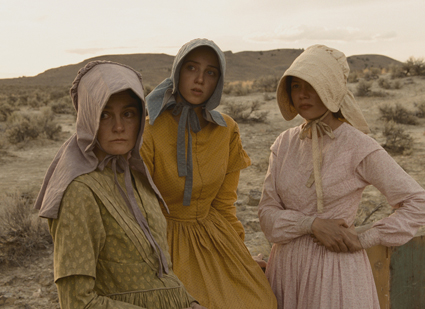
Meek’s Cutoff, Kelly Reichardt
kelly reichardt, meek’s cutoff
So soon after enjoying the Coen Brothers’ True Grit, it was a great pleasure to see an even more atypical western, Kelly Reichardt’s Meek’s Cutoff (US). A small wagon train is lost on its way to California. The travellers are short of water, fear their guide, Meek (Bruce Greenwood), has deliberately mislead them and all are anxious about the hostility of the Indian tribe whose land they are crossing. The women in the train are at the film’s centre. When the men wander off to meet and make decisions away from the wagons, the camera and the sound stay with the women—like them we can sometimes only guess at what the men are saying. As conditions worsen, the group captures a lone Indian who appears to be singing the land, something the travellers can’t comprehend, their Christianity compounding fear of his apparent primitiveness. But, despite the cynical Meek’s desire to kill the Indian, they persuade him to lead them to water.
What is so striking about the film is Reichardt’s subtle portrayal of the cultural gaps between the men and the women (nuanced in varying, revealing degrees) and between the travellers and the Indian. The gap between the men and the women is negotiable to a degree—one of them (Michelle Williams) shockingly usurps the male prerogative at a critical moment, saving the Indian from Meek—but the chasm between invader and indigene is profound. There is no smoking the peace pipe or pidgin bartering or sign language, only the most basic communication. The sense of otherness is exacerbated by the long-held shots of the barren landscape and real-time takes of trudging to exhaustion. The dialogue is aptly spare and the performances, especially from Greenwood and Williams, idiosyncratic and finely honed. If not an action-packed Western, Meek’s Cutoff is suspenseful and insightful, a rewarding variation on the wagon train genre and deserving of cinema release here.
clio barnard, the arbor
The Arbor is a curious exercise in the reconstruction of the life of Andrea Dunbar, a poorly educated young woman from a Bradford housing estate in the UK who became a famous playwright for a brief period from the late 1970s although she’d never been near a theatre in her life until that time. While her acutely realist plays were being picked up by the Royal Court Theatre, Dunbar’s life deteriorated rapidly. Often staying in bed for most of the day, writing and then heading off to the pub, all the while she was seriously neglecting her daughters. We see TV footage of Dunbar but everyone else in the film—the psychologically wounded daughters (traumatised by a fire after they’d been locked in by their mother), distraught neighbors who looked after and loved the children, and Max Stafford-Clark from the Royal Court—are played by actors who lip-synch the recorded voices of the originals. They’re good performers, but the aesthetic motivation for director Clio Barnard’s approach is difficult to gauge. As well, a group of actors perform excerpts from Dunbar’s works in a park in the housing estate—we never learn what the gathered locals (mostly at a distance from the action) make of this exercise.
It was assumed that given Dunbar’s subject matter and insights, she was socially enlightened. What the film reveals is a broken marriage to a Pakistani man, the father of her first daughter. She subsequently treats the girl with disdain and, later, open hostility. She declares publicly, “I’m not a racist, I just couldn’t deal with Pakistanis.” (It seems her husband locked her in when she was pregnant as well as applying other constraints.) The daughter becomes a heroin addict, her son dies in mysterious circumstances (possibly accidental methadone poisoning), she is treated like a murderer, cleared and, despite her damaging history, admits, “I had to grow up and stop blaming the world.”
Although very oddly constructed (for example, the dramatic opening scene of a bed on fire and the adult sisters standing by it reflecting on their childhood has no later equivalent) and contrived (the lip-synching suggests documentary authority, but at a fictional remove), The Arbor is an intriguing and certainly disturbing experiment in the contemporary mode of melding documentary and outright artifice in ever more elaborate ways.
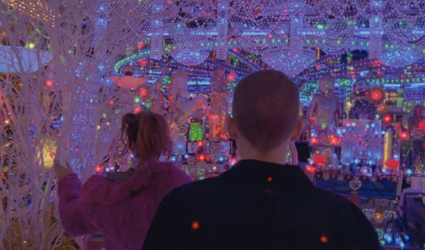
Enter the Void
gaspar noe, enter the void
In terms of cinematography, Gaspar Noe’s Enter the Void (Germany/Italy) has to be seen to be believed. It trawls through contemporary Tokyo, drug-induced deliria, back street clubs and a multi-coloured fluorescent model of Tokyo (weirdly, the city subsequently takes on its astonishing hue). The film’s protagonists, brother and sister—American 20-somethings, refugees from the car crash death of their parents—are incestuously inclined; he’s flirting with crime and has had sex with his best friend’s mother; while she’s a dancer at a club owned by a criminal lover. At first the story is told elliptically as fragments of the past and present are put together, then melodramatically as consequences are played out and finally as a long, beautiful-to-look at but tediously sluggish hallucination when the young male enters the void. But it’s a void blindingly rich in colour and illusion (there’s even a Douglas Trumbull 2001-stargate homage). As in Hail, the descent into disaster becomes one-dimensional, but the film remains worth seeing for its uncommon narrative adventurousness and bold cinematography—no drugs necessary. A good film festival must bravely remind us of film’s potential in whatever form, using whatever technology and wherever shown—in cinemas, on computers, in galleries or public places.
Bigpond Adelaide Film Festival, including Stop(the)Gap, International Indigenous Arts in Motion, Samstag Museum of Art, Feb 24-April 21; Port Projections, Port Adelaide, Feb 25-27; Vernon Ah Kee, Tall Man, Australian Experimental Art Foundation, Feb 24-March 26; Tracey Moffatt: Narratives, Art Gallery of South Australia, Adelaide, Feb 25-March 20
The RealTime Managing Editors were guests of the Bigpond Adelaide Film Festival.
RealTime issue #102 April-May 2011 pg. 21,22,25
© Keith Gallasch; for permission to reproduce apply to realtime@realtimearts.net
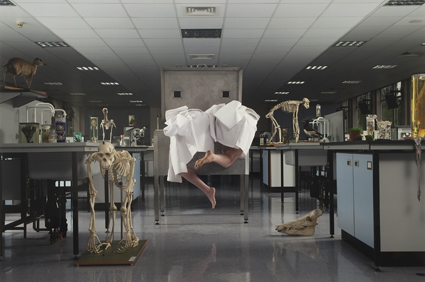
Refolding (Laboratory Architecture), Kira O’Reilly and Jennifer Willet, InBetween Time
photo Jamie Woodley
Refolding (Laboratory Architecture), Kira O’Reilly and Jennifer Willet, InBetween Time
ACCORDING TO THE PROGRAM, ONE OF THE STRANDS OF THE 2010-11 INBETWEEN TIME FESTIVAL, THE EXHIBITION, WHAT NEXT FOR THE BODY, PRESENTS WORKS THAT “CONSIDER THE CONDITIONS AND OUTCOMES OF THE CONTEMPORARY BODY BREAKING DOWN…AT WHAT POINT DOES OUR MATTER CEASE TO BE OURSELVES?”
Director Helen Cole said during an exhibition tour that the commissioned work in InBetween Time came from artists who have a history of working with the body in live art contexts; who have done a whole lot of messing about with insertion and incision and bodily fluids and using the body as their canvas or perhaps their medium; who have on their own flesh tested the limits of endurance, exposure and incarnation. Some of these artists are moving on from thinking of the skin as ultimate border between one reality and another, as a barrier that must be tested and/or crossed. Cole explained that one question guiding her choices in curating the festival was, if you run out of body, then what? And what if the body is over, fails and dies? What about the traces that are left behind? The symposium on February 5 took up this and other issues in more detail.
death, tatts & zombies
In the first session, Dr John Troyer, Death and Dying Practices Associate at the University of Bath, talked about memorial tattoos. In this practice a person’s living body is used as a canvas to display an image of a dead loved one. Troyer’s presentation drew fascinating contrasts between different attitudes to tattooing: 19th century notions that tattooing and criminality are connected; the idea of the Noble Savage; the idea that the body is unfinished and needs to be modified in order to be cultured rather than natural, hence tattoos and body modification; that the tattoo may equally be a pledge of love, a nationalistic affirmation, a gesture of reclamation or a ritualised token; that a tattoo is a visible sign that provokes a narration of its meaning, in order to be activated.
The slides Troyer showed ranged from 19th century post-mortem photographs to a colour snapshot of the tattooed back of a girl he met on the beach. He asserted that memorial tattoos make death visible on a person who wears them. He also mentioned the practice of keeping post-mortem tattoo samples. Some examples from museums consist of a few square inches of inked skin stretched on a frame—what was once a living memorial, a trigger for the exchange of dialogue, memory and imagination in everyday live encounters, becomes an inert graphical object. At this point someone in the audience speculated on whether it would ever be possible to maintain an excised tattoo as living tissue.
Martin Hargreaves’ provocative presentation (he claims his research interests lie between boredom and hysteria) dwelt on what might be the ultimate body; unstable, ugly, predicated on decay and nihilism. Referencing David Wojnarowicz and Bruce LaBruce (RT99, p26), AIDS discourse and “the societal death-wish of the young effeminate,” Hargreaves made an unlikely case for the zombie as a signifier of the attempt to lead an ethical (gay) life. “What are the positives of opening up to zombie logic?” he asked.
Unlike the other contemporary horror tropes of vampire and werewolf, the zombie is not glamorous. Bereft of everything—mind, sense, volition, wholeness—the zombie is helpless to resist invading appetite, and is cannibal; the zombie will inexorably infect others with its own infirmity. It has nothing but its own self, which is defunct. Between helplessness and authenticity, the zombie figures as (heroic) exemplar of our hapless existence.
Mind you, going by Bruce LaBruce’s Otto; or, Up with Dead People, the zombie is rather good looking. So far, so ghoulish.
immortal cancers, divisive dividends
Dr Muireann Quigley talked about legal, scientific and commercial issues pertaining to human remains: cadavers and cell strains. The speaker cited test cases to illustrate the current situation of property in the body. She talked about cell lines and cultures; mentioning such cases as Henrietta Lacks, whose cancerous tumour gave rise to an ‘immortal’ cell line still being used in laboratories around the world, contributing to the profit of the institution that first made a culture of it.
Quigley explained some of the legal precedents that create an economy around bodily remains, producing concepts of ‘bio-equity’ and of a ‘tissue economy.’ “Human bodies and bio-materials are firmly in the realm of property discourse and subject to property relations.” She noted that within this discourse there is conflict between emotional and scientific value, and between public and private realms. Listening to her explain the application of commercial values to bits of people’s bodies had a strangely fetishising effect. This bio-material also has some value simply because, being derived from humans, its use is transgressive, going against contemporary cultural mores. It is as if commercial value becomes a totem which science shakes in the face of those who might question the use of this material. It was odd, to say the least, to catch glimpses of such an archaic mindset underlying the operation of some of our newest technologies.
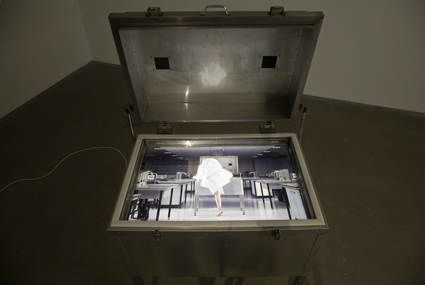
Refolding (Laboratory Architecture), Kira O’Reilly & Jennifer Willett, InBetween Time,
photo Jamie Woodley
Refolding (Laboratory Architecture), Kira O’Reilly & Jennifer Willett, InBetween Time,
bio-art: science look-alike
Dr Jennifer Willet and Kira O’Reilly, whose collaborative photographic work Refolding (Laboratory Architectures) was part of the gallery exhibition, took it in turns to address the symposium. Willet spoke via Skype from Canada.
She began with a definition of bio-art. The prefixes genetic-, transgenic-, biotech-, vivo-, life-, ecological-, land-, bio- joined to the word ‘art’ all describe practices aligned to or contained within bio-art, whose artistic medium is life or living systems. It is a woolly concept but a large one, and it is easier to define what it is not, than what it is. Bio-art does not represent another thing, it forms neither pictures nor maps. Occurring in the laboratory, it may make use of methodologies more usually seen in studio practice, or may create a scientific methodology peculiar to itself. It is not science, although it may look like science.
Willet asserted that as bio-art involves the manipulation of life to aesthetic ends, it is political, intrinsically involving ethical considerations not conventionally afforded to other art forms. Typically, bio-art must adhere to ethical codes and community standards established by the scientific community. But, according to Willet, in requiring collaboration between artists and scientists, bio-art represents a democratisation of scientific processes.
Kira O’Reilly has been Honorary Research Associate and Artist in Residence at the School of Biosciences, University of Birmingham. In Refolding (Laboratory Architecture), installation photographs portray O’Reilly and Willet in scientific environments. The photographs illustrate a taxonomic system of which the humans are part. Through costume they are coded as part of the system; as observing it; and as camouflaged within it. Willet and O’Reilly wear specially designed white lab coats, each modified to indicate a different era, evoking its associated historical/cultural habits of thought.
The siting and collaborative methodology of Refolding (Laboratory Architectures) within a scientific institution, confers the institution’s credibility on the work. It is fair to say this is characteristic of bio-art.
to infinity and beyond!
The idea of regeneration and what cell technologies might mean for a transhuman, or indeed post-human future became a hot topic of the symposium. The aspiration towards immortality had kept surfacing all day. In spite of the context some element of magical thinking seemed to come in to play, fixing on the potency of physical traces we leave behind. It’s almost as if our detritus, our bits and pieces, achieve a witchy glamour from being at once inanimate while also theoretically capable of being reanimated.
I was comforted to recall something I wrote for the last InBetween Time in 2006: “(Sally Jane) Norman insisted that although technology has extended the human impulse to play with versions of embodiment and variations of reality, this has not changed our fundamental nature. ‘The post-carbon, hairy monkey Stelarc body refutes the idea that we are somehow less physical than we once were.’”
I say comforted. From the Golem to Metropolis to Dr Frankenstein to Planet of the Apes to Alien popular culture views the notion of humans using technology to enhance or engender life with foreboding and caustic cynicism.
jam tomorrow
As demonstrated in Dr Troyer’s presentation, Western culture has historically had a stronger appetite for the ghoulish than is currently generally acceptable. Museums once thought nothing of collecting and displaying anthropological remains, shrunken heads and skeletons of subject peoples, entire skins of tattooed men. These practices are embedded in the history of collecting, and are loaded as drastic acts of objectification of subject peoples’ bodies, a totem activity of the colonial project. However much potency Live Art practice derives from breaking taboos, it would be ironic if seizure of the trophy relic regained legitimacy under its wing.
Jordan McKenzie explained he was a founding member of the Dead Dad’s Club. His performances, a meditation on breath, were a response to watching his father die of emphysema. So, he creates traces: in Drawing Breath, McKenzie breathes into a charcoal covered paper bag which is burst against the wall, leaving a print of its impact. In Condensation Box and Holding My Breath McKenzie breathes into a glass tank, freezing the resultant condensation. The ice dissolves in his hands as he holds it above a block of charcoal, splashing and leaving a mark. The marks he leaves delineate the edges of representation, they signify a boundary where something existed for a short time. A notch is placed in time as well as space. In these actions, McKenzie is standing in for another body: he is his father’s proxy. His actions create the memorial.
Richard Gregory introduced Quarantine’s new project, When You Thought You Were (an Inbetween Time commission). The year-long participatory enterprise is “a biography of an (extra)ordinary person…a kind of wake for someone living” (www.qtine.com). Speaking of relics, memorials and celebrations, Gregory showed slides of grass, shoes, summer, dinner, play. He told the audience how, going to clear out his mother’s house after her death, before he locked the back door for the last time he had taken a jar of jam from the pantry. There and then he brought out a pot of jam and some teaspoons, placed the pot on a saucer and handed it down the table inviting the other panellists to taste it, which they did. He mentioned that blackcurrant jam wasn’t his favourite.
This is an action that suggests a form of immortality through sharing, lineage and relationships. The jam is a relic, it engages the senses and needs to be physically handled. It is concrete, it is able to be shared, it requires narration to release its meaning—it demands engagement on several levels before it can be understood; and its impact cannot be completely appreciated on a verbal level. The other thing demonstrated here was the difference between action and discourse.
“Once you are born, know you have to die.” With fireworks and intensity most of the symposium demonstrated the latter half of this equation. The achievement of many of the artists involved in InBetween Time was to give weight to the other half. Academic language needs to be able to position both these approaches along the same continuum: however much the occult needs to be revealed, so does the thing that is hidden in plain sight.
InBetween Time Festival of Live Art and Intrigue, director Helen Cole; symposium What Next for the Body, Feb 5; exhibition Arnolfini, Bristol, UK, Dec 1 2010-Feb 6 2011; www.inbetweentime.co.uk
RealTime issue #102 April-May 2011 pg. 8
© Osunwunmi ; for permission to reproduce apply to realtime@realtimearts.net
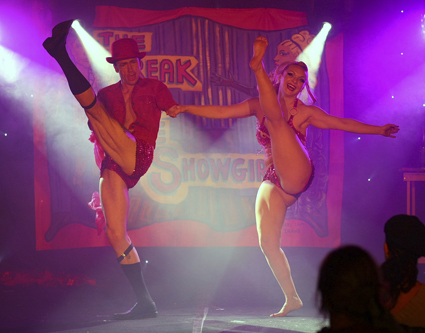
Mat Fraser, Julie Atlas Muz, The Freak and the Showgirl
photo courtesy the artists
Mat Fraser, Julie Atlas Muz, The Freak and the Showgirl
WA’S ARTRAGE MOUNTED A MAJOR PUSH IN FEBRUARY TO BOTH DEVELOP THE FORMAT FOR A PERTH FRINGE IN 2012 AND TO TEST THE MARKET WITH AN AMBITIOUS PROGRAM OF CABARET, BURLESQUE AND BOUTIQUE SHOWS. IT’S NOT THE ‘BIRTH’ OF A PERTH FRINGE AS SUCH; RATHER A RETURN—ARTRAGE ITSELF HAVING BEEN FOUNDED IN 1983 AS THE QUAINTLY NAMED FESTIVAL FRINGE SOCIETY OF PERTH.
Fringe World ran for three weeks and four weekends at The Pearl Spiegeltent (recently acquired by ARTRAGE) with a handful of ‘black box’ solo shows round the corner at PICA’s Performance Space. Audiences gathered before, after and in-between at the modest but pleasantly balmy outdoor hub of the Urban Orchard, tucked conveniently between the Art Gallery of Western Australia, PICA and the Perth railway station. As well as 23 shows from local, national and international performers—including the Wau Wau Sisters, Woohoo Revue, Frisky & Mannish, locals Sugar Blue Burlesque, Piff! The Magic Dragon (UK) and New Yorker David Calvitto, to name a few—Fringe World also included a two-day summit to thrash out how Perth Fringe 2012, dubbed “The Boutique Fringe at the Edge of the World,” might be structured.
Inclusion of the PICA Performance Space in Fringe World created an opportunity for four local solo performers (and one international) to enjoy the benefits of a high-profile central theatre venue and Fringe World’s readymade marketing machine. I managed to catch two PICA shows—Leon Ewing’s The Problem with Evil and Andrea Gibbs’ Grow Up.
The Problem with Evil is largely based around two ‘characters’: an Al Gore-style circuit-lecturer on a “demotivational tour” to encourage more evil; and a talking fish-puppet called Bruce. In a series of fairly heavy-handed monologues, the death’s head-masked public speaker referenced everything from the GFC to the Museum of Old and New Art (MONA) and online paedophilia, enthusiastically equating profits, bushfires and mining with evil and even congratulating cats for devastating native wildlife. While the message was ironically clear, its delivery seemed confused at best and banal at worst. The crassness reached its zenith when Ewing performed a ludicrous ‘interpretive dance’ against repeated video loops of the World Trade Centre as the second plane smashes through the building. This scene was, admittedly, genuinely disturbing: is it evil to perform such a thing, or evil to be watching it? Or both?
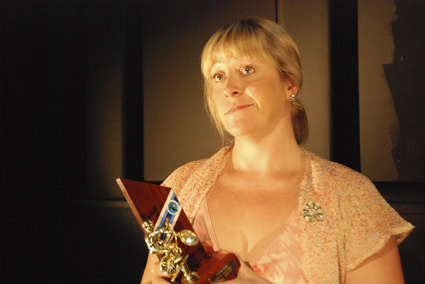
Andrea Gibbs, Grow Up
photo Brett W Cullen
Andrea Gibbs, Grow Up
Perth comedian Andrea Gibbs’ Grow Up is a perhaps-autobiographical series of vignettes from childhood and adolescence, announced by scene-setting, projected titles such as “In Bathers I Trust.” From the poignant reflections of an eight-year-old pondering being killed by a werewolf, to the aching bravado of a teenager confronted by a male ‘skimpy’ after sneaking into the pub, Gibbs held the audience captive with her impeccable timing and telling gestures, subtle as the brush of her feet on the rungs of her stool. Like The Problem with Evil, Grow Up embodied a certain naivety—but unlike Ewing, Gibbs created a space for the unspoken, in a study of vulnerability that belongs as much to the adult performer as to the child.
Around the corner at The Pearl Spiegeltent, the programming encompassed a not-unexpected mix of music, comedy, burlesque, sideshow and circus, with a good number of local performers gracing the stage. Fringe World laid on plenty of ‘quality acts’—like Matt Kelly and Rich Higgins’ clever and pacy The List Operators, for example—and the queues were encouragingly long in a city unaccustomed to such a wealth of choices. Truly edgy or subversive work was a little harder to uncover; but Mat Fraser and Julie Atlas Muz’s (UK/USA) The Freak and the Showgirl stood out with its self-proclaimed “orgy of flesh, flippers and fun.”
The Freak and the Showgirl is, at face value, pure burlesque: a series of themed show-numbers and skits loaded with spinning, sequined nipple-pasties and titillating tricks. What set it apart was not only that Mat Fraser has two very short arms—or ‘flippers’—due to his mother’s encounter with Thalidomide, but that he and Atlas Muz extend both the burlesque and the freak-show genres to talk about it, politicise it, and most of all to sexualise Fraser’s ‘different’ body.
Early in The Freak and the Showgirl, Atlas Muz and Fraser played with limbs, false limbs and limblessness, beginning with Atlas Muz’s strip act, complete with wolf mask and replacing her own hands with wolf ‘gloves.’ She and Fraser performed sleight-of-hand tricks to “It Wouldn’t Be Make Believe,” Atlas Muz standing behind Fraser and replacing his arms with her own. Fraser performed his own striptease, shedding a pair of prosthetic arms along with his clothes.
Between song-and-dance routines and the casting off of spangled costumes, Fraser introduced himself, firstly explaining his condition and a little later performing a monologue about the history of old-time dust-bowl freak shows. He painted a picture of the ‘empowered freak’ who earned a good living and lived independently with a supportive freak ‘family.’ Later still, Fraser turned himself into the sideshow, shaving himself, sawing through a piece of wood, unscrewing a bottle and then swigging from it. The absence of glittery costumes or sexy moves now turned the mirror back onto the audience: while burlesque is all about the gaze, suddenly it was no longer burlesque—our own voyeurism seemed to become the object of scrutiny.
The glitter kept on coming though, both performers exploiting every opportunity to strut, pout, shimmy and eventually disrobe; until sex and sweat seemed to have got the better of both Freak and Showgirl. From start to finish, The Freak and the Showgirl managed to carefully hone a razor’s edge between the bawdy and the troubling; and while seeing Matt Fraser and Julie Atlas Muz descend into a messy melée of simulated sex elicited slight shock, the feeling in the audience was far from discomfort.
Debate raged during the two-day Fringe World Summit as to whether Perth Fringe 2012 should be an Adelaide/Edinburgh-style open call, or a curated festival along the lines of the Dublin or New York Fringes. The question remains unresolved, but Fringe World 2011 gave Perth audiences a taste of things to come. And for local artists, many of whom have toured work to Edinburgh, Adelaide or the Canadian Fringe circuit, it was a rare opportunity to showcase their work on home ground.
Fringe World: Spiegeltent Program and Fringe World Solos,The Pearl Spiegeltent and PICA Performance Space, Perth, Feb 4-26
RealTime issue #102 April-May 2011 pg. 6
© Urszula Dawkins; for permission to reproduce apply to realtime@realtimearts.net
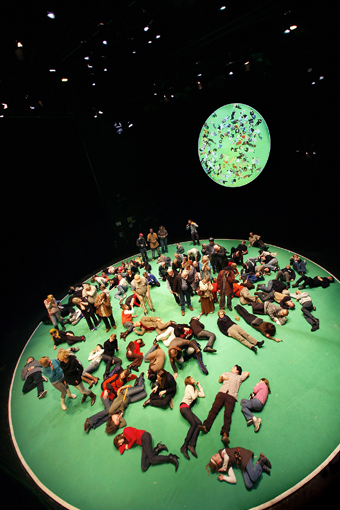
100% Berlin, Rimini Protokoll
photo © Barbara Braun/drama-berlin.de
100% Berlin, Rimini Protokoll
FOR THOSE WHO FEEL THAT THEATRE IS SUPPOSED TO BE A COMMUNAL EVENT, THIS YEAR’S PUSH FESTIVAL TURNED OUT TO BE A POWERFUL EXERCISE IN CIVIC BONDING. WHILE THE FESTIVAL WAS AS EXPANSIVE AS EVER, ONE OF THIS YEAR’S THEMES WAS “NOTIONS OF CITYNESS.” IN A CITY THAT PRIDES ITSELF ON ITS PANORAMIC “VIEW CORRIDORS,” ARTISTS AT PUSH REVERSED THE LINES OF SIGHT, CUTTING INTO THE SURFACE GLOSS OF THE URBAN MATRIX TO REVEAL A SURPRISING DEPTH OF COMMUNITY FEELING.
100% vancouver
Theatre Replacement’s adaptation of Rimini Protokoll’s 100% series—in this case 100% Vancouver—was perhaps the most explicit example of this depth. The show puts 100 citizens on stage—representing all of the city’s neighbourhoods, ethnicities and ages—and has them group and regroup according to how they answer a number of census-like questions. It can be a surprisingly moving exercise—to see someone take centrestage in response to “How many of you are sick?” becomes a remarkable act of exposure. Vancouver, often a poster child for post-modernist urban fragmentation, is shown here to be anything but a place of disjointed neighbourhoods in which people of varying backgrounds are unable to connect with one another. I confess I was astonished when fists were raised in solidarity to the question, “How many of you would fight for your city?” Was this an expression of existing bonds or a longing for a unified civic identity?
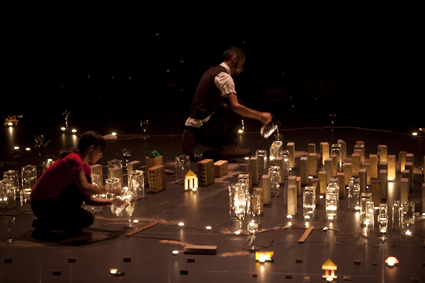
City of Dreams
photo Tim Matheson
City of Dreams
city of dreams
From demographic city to city as architectural accumulation. English director Peter Reder, in collaboration with Vancouver’s Urban Crawl Theatre, presented City of Dreams, an installation that constructs the urban landscape before the audience’s eyes. It begins with six performers outlining the contours of the city’s coastline with twigs and cedar fronds placed on the floor, and ends with them building a high-rise representation made of old bricks and glass vases. During the implied timeline, development accelerates after WWII. Neighbourhoods are filled in and the downtown area takes on the ‘city of glass’ character for which Vancouver has become known. Wine glasses line the waterways and dozens of tea candles are sprinkled throughout. In the dim light the effect is mesmerising. Each glowing candle is like a star in a constellation that happens to take the shape of the city.
During a post-show talkback spectators had a range of responses, from utter enchantment to grief at the loss of natural habitat and the aboriginal way of life. The unspoken ideological perspective of the piece was also questioned: didn’t the focus on urban development and on the past century support a Eurocentric, colonialist point of view? Reder had no arguments with any of this; he intended the piece to be open to interpretation; feelings of loss, including lost dreams, were part of it. I was one of the artists who built the Vancouver edition of Dreams, and I found that the differing opinions expressed by the spectators reflected my own conflicted views about creating the work. But I couldn’t deny that Reder and sound designer Tom Wallace had captured much of the city’s character. A week after the show closed I was riding my bike along the north side of False Creek at dusk. I looked across the water at the cluster of apartment buildings in Yaletown. The evening sun reflected off the glass exteriors. Individual flats were lit up warmly from within. It looked like life imitating art, like Reder’s miniature theatrical representation blown up to scale. It was breathtaking—monumental and fragile at the same time.
peter panties
It could be argued that with its tinkling of wine glasses amid a glittering assemblage of candle-lit skyscrapers City of Dreams had a West-side feel to it. Peter Panties, on the other hand, offered a glorious orgy of East-side freakdom. Panties, the brainchild of Niall McNeil, was co-written with Neworld Theatre’s Marcus Youssef and staged by the wild geniuses that typically make up a Leaky Heaven Circus performance. Panties is all about sex: Peter Pan (James Long), who by the end of the play is revealed to be McNeil’s alter ego, wants to get into Wendy’s (Sasa Brown) undergarments. The more Wendy resists coital and matrimonial union, the more trials the playwrights put her through. Peter is a creature of irrepressible sexual impulse; Wendy has a more thoughtful, searching side. While the character of Wendy is hesitant, the play as a whole indulges Peter/McNeill’s fantasies. These include having Wendy captured and bound by a Captain Hook figure in a scenario that is part innocent childhood fantasy, part sadomasochistic bondage routine; a showdown between Tinkerbell (Tanya Podlozniuk) and Wendy is performed in silhouette, emphasising the actors’ shapely bodies, and includes a tit-twisting wrestling match. I think it’s intended to be both titillating and absurd. Peter/McNeill’s adolescent sexual desire is the lens through which we see this transformation of the Peter Pan story, one in which escape from the constraints of ordered civilisation is taken to libidinal extremes.
The staging has a deceptively anarchic feel but is actually carefully composed and includes composer Veda Hille and the superb teenage rock band, The Bank Dogs, who together provide musical accompaniment for the songs. Peter Panties is like a slumber party where sexual latency bursts through the flannel and runs riot. The beautifully disjointed dialogue and stage imagery is full of unexpected turns, and is evocative of the theatre of Alfred Jarry, Dada and the Surrealists in that it is never lacking in delightful surprises. And, as a friend commented, “There’s something very human about it.” Kudos to Leaky Heaven for once again setting the standard for Vancouver theatre.
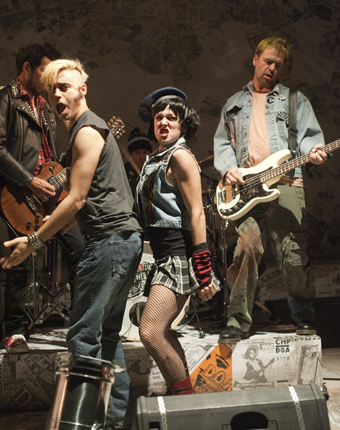
Hard Core Logo: Live
photo courtesy the artist & Push Festival
Hard Core Logo: Live
hard core logo: live
Vancouver didn’t invent punk, but it has carved its place in history as the founding city of hard core. If this is a city of glass, then legendary bands like DOA have made it their mission to smash in the windows of the over-privileged. Contrary to the civic pride expressed in 100% Vancouver, punk takes aim at the “plastic people building a plastic steeple” (in the words of DOA). But trying to squeeze Punk sensibility into a conventional theatre format is a tricky exercise. When so much order is imposed on chaos is it still Punk? Hard Core Logo: Live is November Theatre’s stage adaptation of Bruce McDonald’s film adaptation of Michael Turner’s book of the same name. Turner’s book is a poetic account of the disastrous re-union tour of Hard Core Logo, a fictional band based on the real-life legendary hardcore Vancouver band DOA. McDonald turns Logo into a road movie, which is appropriate to the structure of the book. DOA has been going strong since the late 70s, but this show is essentially a nostalgic rock revue in which four aging band mates try to rekindle the anarchistic spirit of their youth, with music by DOA icon Joey “Shithead” Kiethly and lyrics by Turner. Michael Scholar Jr, who wrote the stage adaptation (and performs the lead role), keeps some of the flavour of the road movie and book while managing to flesh out the characters and their relationships to a degree that elicits more emotional investment than its predecessors.
For a two and a half hour performance that can’t offer the visual distractions of cinematography, or the freedom to put the book down when interest flags, this was a good move. But the frame of a conventional theatre set-up, in which the performers are confined to a proscenium arch stage, and the spectators sit obediently in the assigned seating area, undermines any subversive intent. The Vancouver Punk scene thrived in venues where audience and spectator were always a threat to one another. There was rarely a tidy separation between the two. It was also a politically charged scene. Its anti-establishment posture was intelligently focused—a fact which seems entirely absent from any of the three versions of Hard Core Logo. To this day DOA, the grand-daddies of the scene remain anarchistically active, musically and politically. Hard Core Logo, on the other hand, comes off as a harmless meander down a grunge-bordered memory lane.
PuSh International Performing Arts Festival, Vancouver, Jan 18-Feb6, http://pushfestival.ca
RealTime issue #102 April-May 2011 pg. 40
© Alex Lazaridis Ferguson; for permission to reproduce apply to realtime@realtimearts.net
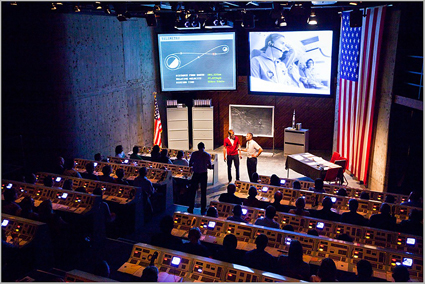
APOLLO 13: Mission Control, Hackman
photo courtesy Brisbane Powerhouse
APOLLO 13: Mission Control, Hackman
IN THE POWERHOUSE FOYER FOR THE WORLD THEATRE FESTIVAL, A REALISTIC LOOKING SPACE MODULE BEARING THE INSIGNIA OF THE STARS AND STRIPES PROVIDES A BRIEF FRISSON FOR MEMBERS OF MY GENERATION.
Two apparently pregnant members of Chilean theatre company, Teatro en el Blanco, pour cascades of beans from burgeoning bellies onto a darkened stage at the finale of their play, Diciembre—a poignant, complex image encapsulating themes which inevitably bring up memories of past American interventions in that country.
In a foretaste of her project in development, Rramp, petite Lisa O’Neill en pointe pounds drumpads like an obsessed automaton creating a metronomic synergy of sound and movement. Guitar wielding, towering Goth-resplendent, Christine Johnson, inclines her Bride of Frankenstein bouffant condescendingly to enquire, “Do your feet hurt, dear?”
The hedonistic precinct of nearby Fortitude Valley at night was the location for a race to solicit someone willing to indulge in the chaste thrill of kissing a man in a rabbit mask, an innocuous fairytale recounted for us in a real-time version of the flicks by UK group Gobsquad (but no popcorn) in Super Night Shot.
Rats ran riot in a Polytoxic work-in-progress environment in the Turbine Hall, and the young performers of The Escapists inveigled us on a mystery tour culminating at the top of the Powerhouse in a breathtaking moment of pure jouissance. Distracted by a theatrical sleight of hand, we rummaged in boxes to release a flight of balloons (ho hum). Only when we looked over the balcony did we perceive the panorama of the forecourt below which at that time of day was a teeming thoroughfare. Bathed in a late afternoon glow, hordes of pedestrians, cyclists, joggers, mothers with strollers and children in hand, flaneurs of all kinds went about their business each holding a string with a balloon attached. A joyful flash of Seurat by the river. I thought I caught a glimpse of Jacques Tati bicycling through. And then in a gesture of detournement worthy of the Situationists, they insisted on giving us $2 back on the price of our ticket.
These random snapshots of the World Theatre Festival at the Brisbane Powerhouse in February might conjure pictures from any alternative (read niche marketing) festival anywhere in the world. What was so unique about WTF that I should sing its body electric? First let’s clear the decks. WTF aimed to capture the imagination of younger generations by providing a saturated environment similar to events like The Big Night Out, accessible ticket pricing and answering its own question—WTF is theatre?—with exemplary pluralism. Some people complained that Gob Squad belonged in a film festival and was not pertinent to theatre. Gob Squad, of course, sits well in either format, and blurring the boundaries was a distinctive feature of WTF. But an ironic confusion of categories innocently appeared in locally produced Daniel Santangeli’s participatory Room 328, a show I admire. (See review). Young women high on pheromones and other substances blithely performed themselves careening through the space, apparently oblivious to the abusive acts the young male performers were perpetrating on their symbolic sister: a rubber sex doll. Santangeli’s forceful critique of clubland seemed cancelled out by WTF’s wooing of the same.
There was an apparent groundswell of young people, but the anonymous admixture of audiences was more apparent on band nights that ran concurrently with the festival on Fridays and Saturdays; audiences in the theatre were by and large the affluent and aficionados. Perhaps management should have bussed in young people with less ease of access. I spoke with a young artist who’d travelled up from Melbourne and was surprised not to meet friends with whom she’d studied drama at Queensland University of Technology not so long ago. Changing culture is a long haul I know, and WTF should be credited with putting its money where its mouth is with progressive programming that supports equity, fairness and tolerance. I personally look forward to a potentially broader conflation of audiences in 2012.
Groundbreaking is an overused word nowadays (compared to whom? Beckett? Kantor? Pina Bausch?) and I didn’t find any of the works earth shattering in this sense (except perhaps for the legitimate shock value inherent in the work in progress Black Queen Black King). So why was WTF so impressive? WTF promised a dialogue, and on this count it delivered. I was completely taken over by the conversation that took place between the shows (I mean the shows themselves were in conversation), something that captured a hopeful zeitgeist. Something that registered a seismic shift. Something with the colour of balloons. Something that restores to art its avant garde function as social antennae, pointing in the direction of new social imaginaries.
teatro en el blanco, diciembre
I interpreted the overall affirmative nature of this conversation as the tentative expression of an ethic of joy, previously postulated by Spinoza and Nietzsche, a joy that is not necessarily concerned with liberating mankind from pain and suffering (the American pursuit of happiness), but rather the living of a true life in this world. This ethic was given a voice in a final soliloquy by the politically uncommitted brother in the Chilean production of Diciembre who finds his personal discovery of love for men, whilst in the army, transcends opposing ideological imperatives represented by his two older sisters. Guillermo Calderon, the young award winning writer and director of Diciembre and representative of the generation who grew up under the fascist dictatorship of Pinochet, regrets the lack of any genuine attempt at a process of reconciliation in his country, but has been equally appalled by the so-called restoration of democracy in neo-liberal guise. His acidulous black comedy performed at breakneck speed by actors who doubled themselves in subsidiary roles in the blink of an eye, consummately, was a tour de force of round table discussions, especially as in the end the two sisters swap points of view, a not unlikely proposition evident from our own political comedy performed in Canberra.
art & egalitarianism
WTF keynote speaker Jude Kelly (artistic director of Southbank UK) in an inspiring extempore speech seemed to be groping towards articulating a political position that takes stock of the way power operates now, and that doesn’t rely on violence and the hardening of attitudes along right and left lines to arbitrate outcomes. She also seemed, bless her, to endorse the notion of some kind of redistribution of cultural wealth, an idea that has become a shibboleth in the economic sphere. She cited successful educational schemes along these lines gleaned from her travels in South America that in no way compromise artistic standards of excellence and come close to the realisation of Felix Guattari’s conception of an ‘ethico-aesthetic politics’. Another panel discussion pursued egalitarianism along intergenerational lines set out by Lenine Bourke (artistic director of Contact Inc) and Mary Anne Hunter in their Currency House Platform Paper, Not Just an Audience: Young people Transforming our Theatre.
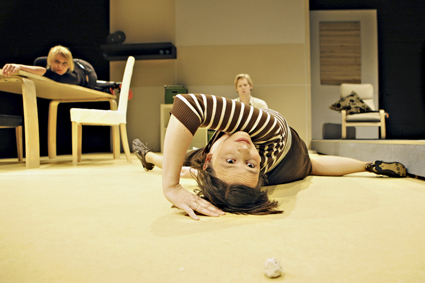
Good Cop Bad Cop, Kassys
photo Prudence Upton
Good Cop Bad Cop, Kassys
kassys, good cop bad cop
Kassys in Good Cop Bad Cop presented a humorous, sharply observed and self-mocking observation of ourselves as we are, and how we embrace the media promulgated fabulising that allows us to invent and interpret these selves as our own. The video interviews that inter-cut the performance, are triumphs of banal, self dramatising content and sincere delivery. Their effortless stage playing style, by contrast, evoked the unsensationalised and natural behaviour of domestic animals with seeming spontaneity flowing into moments of pictorial stillness. I loved this unusual and quietly intelligent work both for what it said and left unsaid. (See also RT101.)
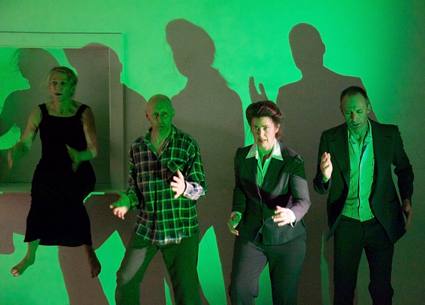
Kate Hunter, Nick Papas, Carolyn Hanna, Andrew Gray, The Waiting Room, Born in a Taxi
photo Leo Dale
Kate Hunter, Nick Papas, Carolyn Hanna, Andrew Gray, The Waiting Room, Born in a Taxi
born in a taxi, waiting room
I appreciate experiencing performers who are old in their craft. In Born in a Taxi and the Public Floor Project’s The Waiting Room the physical ensemble improvisation felt like a surfeit of riches in poor theatre guise. The ability of the performers to almost telepathically fragment and re-cohere always followed a mysterious boundary line between order and chaos. Cognitive scientists describe a process in which original ideas crop up at random and then survive or fail in microseconds, depending on their fitness for rapidly changing electrochemical environments produced by surrounding brain activity. The Waiting Room was such an environment. It seemed to elicit, in its exits and entrances, sad human reflections such as Gauguin wrote on one of his Polynesian paintings: “Who are we, where do we come from, where are we going.” In this way, the work was oddly moving. One room, one door, rows of chairs and ourselves as co-performers.
hackman, apollo 13: mission control
Apollo 13: Mission Control was a big flight of the imagination. However naive the New Zealand company Hackman might have appeared about Cold War politics and its involvement in the space race, it delivered a complex and immersive theatre environment which was impressive in its sheer enormity as a passable replica of the NASA control room of the period. Playing it was great fun for everybody. Narratively it followed a well-tried Hollywood formula about the grizzled veteran and the young nerd who eventually saves the day. However, this was played with credible verisimilitude and was really only background to our own involvement in bringing the boys home. They created a huge level of engagement leading to a crucial moment demanding that an audience member, in the absence of any one else—the actors having left the stage—spontaneously step into a performer’s shoes to respond to increasingly panicky calls from the astronauts. The spear-carriers carried the day.
temporary distortion, american kamikaze
A transnational collaboration by US company Temporary Distortions, American Kamikaze’s admittedly seductive pop aesthetic which, on the surface, appeared as a potent and congruent mix of art installation, video and live performance seemed nonetheless to be the odd man out at WTF. The set is a triptych of two human sized boxes with a vertical video screen between and slightly above them. The actors’ mode of delivery is straight on to the audience, they never make eye contact with each other, never touch and barely move. Their lines only tangentially read as dialogue. The video projections are beautifully composed, and have a ravishing cinematic sensuousness, acting as a hell-mouth for eruption of repressed materials reproduced from Japanese Horror Films and Hollywood film noir. The overall mood is subdued, overcast, brooding and a non-linear story line fractures both time and identity. In its hallucinatory darkness, this set-up reminded me of a 19th century wax museum which, it has been suggested, is a kind of proto cinema. The show deconstructed men’s phallic panic when confronted by women, the animal and death. However, women were portrayed as bereft, vacant objects of desire or else she-devils, and men remained either lone cowboys incapable of intimacy or else predatory beasts. Because we had no sense of characters, everything seemed reduced to a surface equivalence with no hope of change.
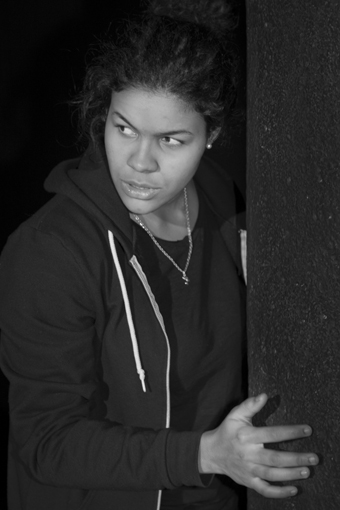
Zahra Newman, Random, Real TV
photo courtesy Brisbane Powerhouse
Zahra Newman, Random, Real TV
realtv, random; stephen oliver, black queen, black king
The lives of black minorities were examined in Real TV’s premiere production in Australia of Random by English playwright debbie tucker green, and in the presentation of excerpts from a musical theatre work in progress, Black Queen Black King by Queensland’s Steven Oliver. Random was a fresh and poignant one-woman show in the slice-of-life genre. Zahra Newman performed brilliant emotional riffs as she re-lived a day in the lives of a Jamaican working class family stricken out of the blue by the tragic death of their 15 year old son in a senseless street fight. In her role as older sister telling the story, Newman was by turns funky, cocky, caustically funny, magnificently sharp-tongued, sarcastic, sorrowing, angry and dignified. She slipped seamlessly in and out of multiple family and community roles. In a word, superb. Black Queen Black King was a confronting exposure of the lives of gay Indigenous men, as the play expressed it, “on the margins of the margin.” The script was gutsy, graphic, funny and often tender. It dealt with issues that seemed as melodramatic as a revenge tragedy but are the real stuff of Indigenous experience. I’m glad that Powerhouse director Andrew Ross seemed to be taking it under his wing.
World Theatre Festival 2011, Hackman, APOLLO 13: Mission Control; co-creator, director Kip Chapman co-creator, designer Brad Knewstubb; Born in a Taxi and The Public Floor Project, Waiting Room, director Penny Baron; Kassys, Good Cop Bad Cop, deviser-performers Liesbeth Gritter, Esther Snelder, Ton Heijligers, Mette van der Sijs and Adriaan Beukema; Gob Squad, Super Night Shot; deviser-performers Johanna Freiburg, Sean Patten, Elyce Semenec, Berit Stumpf, Sarah Thom, Bastian Trost, Simon Will Mat Hand; Real TV, Random, writer debbie tucker green, actor Zahra Newman director Leticia Caceres; Temporary Distortion, Americana Kamikaze writer, director Kenneth Collins co-creator, video projection William Cusick; Teatro en el Blanco, Diciembre, writer, director Guillermo Calderon; SCRATCH SERIES: Polytoxic, The Rat Trap; Daniel Santangeli, Genevieve Trace, Room 328; Christine Johnston, Lisa O’Neill, Peter Nelson, RRAMP; Steven Oliver, Black Queen Black King; The Escapists, Elephant Gun; Brisbane Powerhouse, Feb 9-20
RealTime issue #102 April-May 2011 pg. 2-3
© Douglas Leonard; for permission to reproduce apply to realtime@realtimearts.net
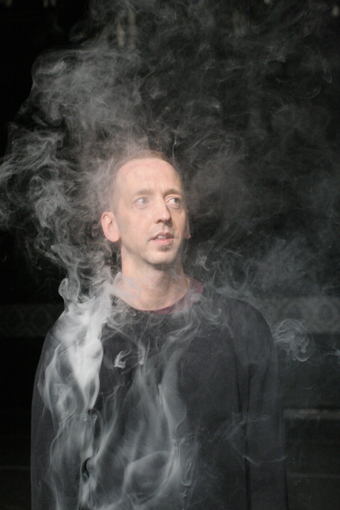
John Jasperse, Becky, Jodi & John, John Jasperse Company, Dance Massive 2011
photo Alex Escalante 2007
John Jasperse, Becky, Jodi & John, John Jasperse Company, Dance Massive 2011
New York dance maker John Jasperse looks like he’s firing in Becky, Jodi and John, one of the works in the excellent 2011 Dance Massive program in which enormous creative energy was unleashed on the stages of Malthouse, Dancehouse and Arts House across almost two weeks. In this edition we’ve reproduced a selection of reviews sweated out daily by the RealTime writing team for what was certainly a smokin’ Dance Massive. Long may it burn for the sake of Australian contemporary dance and its lovers; but what exactly is the future for Dance Massive?
And while we’re on burning issues, the detention by the Chinese Government of Ai Wei Wei, a leading Chinese artist whose work and personal presence has been strongly felt in Australia, has revealed in no uncertain terms that China will not tolerate any dissent, particularly while the so-called Jasmine Revolution continues to build in northern Africa and the Middle-East. In 2009, Ai Wei Wei was beaten by police (resulting in an operation for a subdural hematoma); last December he was prevented from attending the Nobel Peace Prize awards; and he was subsequently placed under house arrest for protesting the government demolition of his Shanghai studio. The artist was detained on April 2 at Beijing airport while on his way to Hong Kong. His home and studio have been searched and his staff detained as well. The United States, France, Britain and Germany have all called for the artist’s release and the Australian Government has stated its concern. “Only sustained international pressure can help Ai Wei Wei now,” says Sophie Richardson, Asia Advocacy Director, Human Rights Watch. We should all urge our government to intensify its protest, not only against the detention of Ai Wei Wei but of other artists and dissidents.
RealTime issue #102 April-May 2011 pg. 1
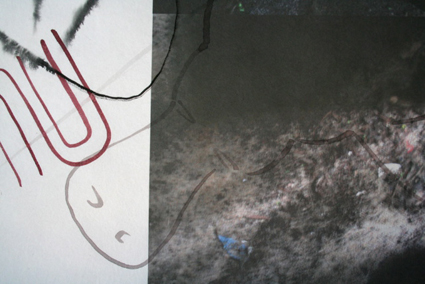
Bonita Ely, detail, DelugeDrown (2010)
Ink jet print on rice paper, ink, silk, wood. 1400 cm L x 92 cm W
image courtesy of the artist and AEAF
Bonita Ely, detail, DelugeDrown (2010)
Ink jet print on rice paper, ink, silk, wood. 1400 cm L x 92 cm W
environmental engagements
The Australian Experimental Art Foundation is about to open Three Rivers, a major survey of Bonita Ely’s environmental art. We’ve previously admired Ely’s work in the MCA’s exhibition In the Balance and the Campbelltown Art Centre’s River Project (RT100). The exhibition includes the artist’s most recent work, The Murray’s Edge, which focuses on the river’s headwaters in the Mount Kosciusko National Park. When combined with her earlier work, the result is a complex and “compelling study of the Murray River from the 1970s until the present” (press release). If you can’t get to Adelaide, you can listen to Ely talk about her long-running engagement with the environment in an online video titled The Murray’s Darling. Bonita Ely, Three Rivers, Australian Experimental Art Foundation, April 8-May 5; www.aeaf.org.au
making and remaking the city
Still on the environmental theme, keep an eye out for The Right to the City, a symposium and exhibition happening in Sydney. The project takes its title from David Harvey’s article of the same name, in which he argues that the “freedom to make and remake our cities and ourselves is…one of the most precious yet neglected of our human rights” (press release). Curated by Lee Stickells and Zanny Begg (who reported on Tipping Point in RT100), the exhibition includes international artists such as Temporary Services (US), Atelier d’Architecture Autogérée (France), Marjetica Potrc (Slovenia), as well as locals Claire Healy and Sean Cordeiro (RT92, RT57), Joni Taylor, SquatSpace and Milkcrate Urbanism. There is also a symposium on April 9, featuring a keynote lecture by Professor Margaret Crawford from the University of California, Berkeley. If you can’t be there, an exhibition catalogue is being published and selected symposium papers will be published in the Architectural Theory Review. The Right to the City, symposium April 9, exhibition April 8-30, TinSheds Gallery; www.therighttothecity.com
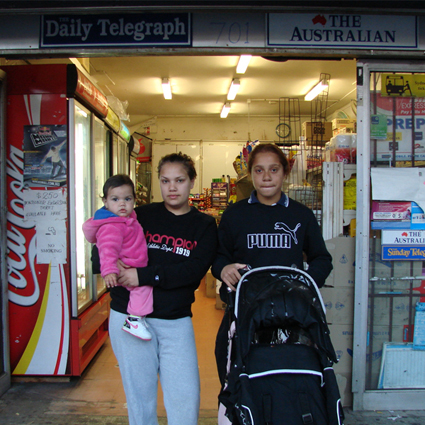
The Waterloo Girls
photo Karen Therese
The Waterloo Girls
out and about
The practice of walking is one way of remaking the city that has become increasingly popular. So much so that there is now a Walking Artist’s Network where you can find artists who work with walking practices as well as a list of symposia and academic publications. Karen Therese’s name might be added as she kicks off the Performance Space season of “walks, promenades, marches and strolls” with The Waterloo Girls. The piece “traverses though the lives and places of four generations of women who grew up in Waterloo” (website). Later in the year, there’ll be walks with Paschal Daantos Berry, Deborah Pollard and Anino Shadowplay Collective (Philippines); Jennifer Hamilton; Big Fag Press, Jo Holder and Fiona McDonald; Sarah Rodigari; Diana Smith; and Lily Hibberd. Quite apart from the walks, it’s good to see Performance Space getting out of CarriageWorks and getting about Sydney. The Waterloo Girls, part of Walk, Performance Space, April 7-9; www.performancespace.com.au
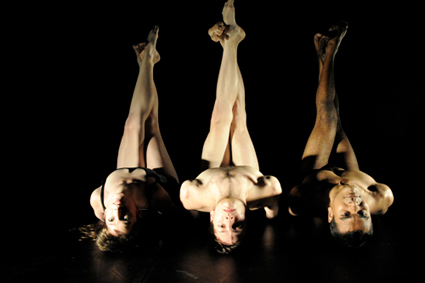
Chrissy Norford, Benjamin Hancock, Eric Avery. Forseen
photo Regis Lansac
Chrissy Norford, Benjamin Hancock, Eric Avery. Forseen
double dance
It’s only March but 2011 is already shaping up as a major year for contemporary dance in Australia: Dance Massive has just concluded; it’s Gideon Obarzanek’s last year at Chunky Move; Rafael Bonchela is consolidating himself at the Sydney Dance Company, extending his contract; there’s a new national secondary curriculum in dance to be written; and we’ve just launched our RealTime Dance portal, which includes all our dance articles back to 1994. In the meantime Dance Bites, from Western Sydney Dance Action and Riverside Theatre Parramatta, continues to gain momentum. Their latest show is a double bill by Frances Rings (RT98) and Narelle Benjamin. Rings’ Debris was commissioned by the West Australian Ballet and Benjamin’s The Dark Room was initially created for the Australian Ballet, so as it’s likely you missed them the first time around now’s your chance. Forseen: Double Bill, April 6-9; www.riversideparramatta.com.au
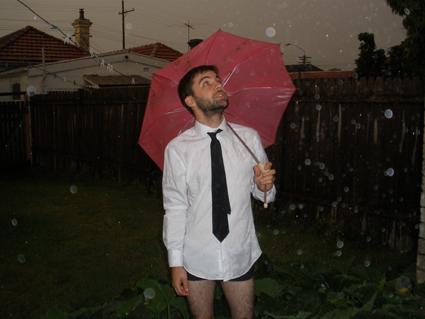
Applespiel, Tiny Stadiums
photo courtesy of the artists
Applespiel, Tiny Stadiums
spatial and relational art
We’ve only just recovered from the Imperial Panda festival (see Caroline Wake’s forthcoming review in the May 9 e-dition), but there’s another artist-produced festival on the horizon. Presented by PACT and curated by Quarterbred, the Tiny Stadiums Festival is now in its fourth year. This time round it presents a selection of projects that consider “art and its relationship to public space” with the chosen works spanning mediums including video, performance, live art, participation, installation and duration (press release). The artists include Applespiel (RT100), Beth Arnold, Lucas Ihlein (RT84), Jen Jamieson (RT87), Dan Koop (RT101), Bennett Miller, Nat Randall, Amy Spiers and Lara Thoms (RT76). Tiny Stadiums, PACT Centre for Emerging Artists, May 2-15; www.quarterbred.blogspot.com
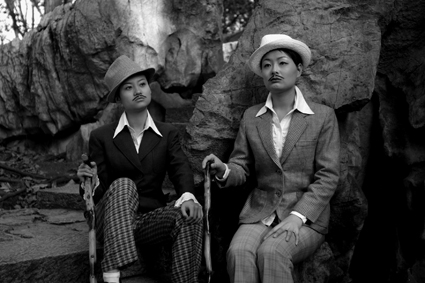
Yang Fudong, No Snow on the Broken Bridge, (still), 2006, 35mm film transferred to DVD, music by Jing Wang
courtesy the artist and ShanghART Gallery, Shanghai, China
Yang Fudong, No Snow on the Broken Bridge, (still), 2006, 35mm film transferred to DVD, music by Jing Wang
no snow on broken bridge
The work of Yang Fudong has appeared in a number of exhibitions over the past year: first in the 17th Biennale of Sydney (RT97); then in Mu:Screen, Three Generations of Video Art at UTS (RT98) and also in The Big Bang at White Rabbit Gallery (RT98). Now, he has an exhibition all to himself at the Sherman Contemporary Art Foundation. The exhibition opens with No Snow on the Broken Bridge, a black and white multi-screen film that “explores the lives of the generation of young intellectuals who have grown up in a country hurtling toward modernisation” (press release). It also includes special screenings of Yang Fudong’s seminal five-part film Seven Intellectuals in Bamboo Forest (2003-07). Yang Fudong, No Snow on Broken Bridge, Sherman Contemporary Art Foundation, March 18-June 4; www.sherman-scaf.org.au
RealTime issue #101 Feb-March 2011 pg. web
© RealTime ; for permission to reproduce apply to realtime@realtimearts.net
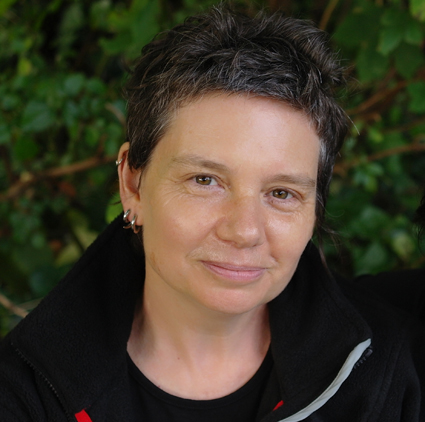
Urszula Dawkins
photo courtesy of the author
Urszula Dawkins
Bio
I work mostly as an arts journalist and producer, also maintaining my own creative writing practice. I was based in Perth for a while but am back in Melbourne now. Some of my favourite gigs have been with Melbourne Festival, Arts House and Gasworks Arts Park. I co-wrote Melbourne’s successful UNESCO City of Literature bid, and was excited to work as producer for the 2009 Art of Difference deaf and disability arts festival. My training is in creative writing, visual arts and journalism; I occasionally write for Art Monthly Australia as well as RealTime.
My fiction has been published in anthologies and journals in Australia, the UK and the US and I’ve presented countless spoken word performances in several cities. I’ve done artist residencies in Minnesota, Marrickville, Reykjavík and the high Arctic, and am now working on a non-fiction manuscript as well as some collaborative projects with visual and performing artists.
Exposé
I’ve always loved words—when I was a musician I wrote songs; when I did visual arts, writing was an important element; and eventually words took over completely. I did a postgrad in journalism in 2008 and got especially interested in the blurred spaces between creative writing and explanatory journalism. I do arts journalism because I’m fascinated by the process of creation. I love talking to artists about why and how they make work, and I love it when readers go “oh!” and can share that pleasure. I also like the challenge of reviewing work that I may or may not immediately respond to—it pushes me out of my world and into someone else’s space and ideas.
In my own work, I’m a kind of ‘fractured Romantic,’ obsessed with CD Friedrich-type landscapes full of jagged peaks and broken ships, and curious about my place in them. I’m interested in how the beautifully sublime quickly becomes treacherous when you commit yourself to walking there; and I’m equally fascinated with emotional landscapes, how we negotiate their peaks and their perils. One way or another, it’s all about desire.
Other writing
my ‘arctic blog’ and some recent work-in-progress can be found on my web site Light Blue
basically i don’t… but actually i do, plus a selection of other articles written for arts house, north melbourne
steiner/lenzlinger – the water hole, art monthly australia, no 220, june 2009
allegory in smog—the art of stormie mills, art monthly australia, no 223, september 2009
a promiscuous, fleeting moment: simon terrill’s crowd theory, art monthly australia, no 230, june 2010
RealTime issue #103 June-July 2011 pg. web
© Urszula Dawkins; for permission to reproduce apply to realtime@realtimearts.net
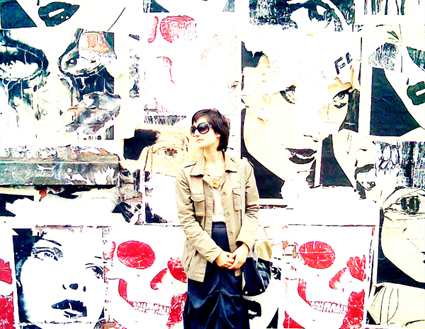
Jana Perkovic
photo courtesy of the author
Jana Perkovic
Bio
Biographies are hard. I moved to Australia from Croatia, via Italy, in 2005. I have studied languages, philosophy, literature, theatre, have half a degree in Japanese (language and culture) and I’m a trained classical pianist. By profession: urban designer and geographer. I teach and research at the University of Melbourne on issues ranging from spatial clustering of creative industries to why children no longer walk to school on their own. I proudly sit on the Green Room Awards panel for performance, hybrid forms, circus and puppetry. As any emigrant, my life is full of inexplicable fractures of logic.
Exposé
I’ve been writing since about the age of three, but I think of language as a form of communication, not a fetish object. I like things that are not words, that cannot be words: dances, places, experiences, emotions. My engagement with RealTime comes out of this interest in writing about the unwriteable. One thing I try to instill into my students is that reflection of this sort is painful, but necessary, if one is not to be a typing (or dancing, designing, or singing) monkey. This year, I am also hoping to create some space for that long overdue conversation about performance and live art in Melbourne—but I will say no more.
I am also hoping for a break from language, and more space for designing: spaces, projects, events. This year, I will be going to Japan to study Japanese cities, and perhaps to Croatia to work on restoring socialist-era hotels. And after a long stint writing academically, I am making room for imagination. Last year I saw a number of inspiring approaches in Europe—projects involving people in the thinking of their city in hugely stimulating ways, such as Urban Festival. There must be room for similar work on this continent.
Other writing
the sad truth about time travel, plotki
riding the next wave to half-baked theatre, crikey
‘goldilocks, or on disorder and dramatic virtue’ or ‘how to tell the difference between a good play and a poor one’ in seven easy scenes, emerging writers 2010 festival reader
These are diverse articles. The Plotki was an honest recounting of what moving to Australia felt like. The Crikey article I include because it generated heat that caught me unprepared: people stopped me on the street to congratulate or admonish me. The Emerging Writers Festival Reader one was the most fun to write.
There is also my blog, www.guerrillasemiotics.com. An eclectic place.
RealTime issue #103 June-July 2011 pg. web
© Jana Perkovic; for permission to reproduce apply to realtime@realtimearts.net
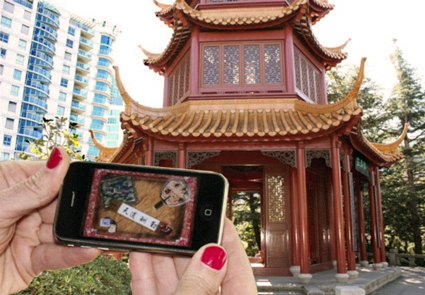
China Heart
photo courtesy d/Lux/MediaArts
China Heart
THE CHINESE LUNAR NEW YEAR BEGAN FEBRUARY 3. IT’S THE YEAR OF THE RABBIT. TO CELEBRATE WE PARK AND STROLL SLOWLY (LIKE A PAIR OF DUCKS) TO THE POWERHOUSE MUSEUM; IN THE LIGHT RAIN, HEAVILY PREGNANT, I WADDLE. WE HOPE FOR A HAPPY MARRIAGE, CLEAR DIRECTIONS VIA GOOGLEMAPS, A YEAR OF HEALTH AND WEALTH. AT THE POWERHOUSE WE DOWNLOAD OUR IPHONE APP FOR CHINA HEART.
There’s a map with various spots highlighted. Videos to watch like mini soap operas. Special objects from the museum are displayed in a glass case. As strains of the museum’s AbbaWorld karaoke filter in, we look at papercuts, toggles for men’s belts used to hold small bags of tobacco, a fan with low-flying ducks.
We begin the journey perched on a red leather seat. We’re guests at an engagement party—a mother-in-law gives a speech in English at first, turning to her native tongue when distressed. Her daughter, Lian, understands but in anger won’t translate; her son-in-law, a ‘good boy,’ is oblivious to her pain. A mysterious parcel arrives with a note that needs translation. After a fight with her mother (about a father who has died, who was never really around before), Lian suggests Chinatown, to find out more about the note (and her ancestors).
We head off looking for clues. The Southern Gates of Chinatown—no, not the golden arches of Maccas nearby—are the first stopping point. The clues are cryptic but the answers easy to find. As we head through Chinatown we are distracted again and again to follow our own hearts: late yum cha customers spill onto sidewalks with banquets piled high (we are told that “for romantics,” dim sum can mean “to touch the heart”); a dragon-twisted queue waits patiently for the Emperor’s Cream Puffs, a “supreme nutritious snack”—what are they? I want one.
Shops sell masks, cheap dragon puppets on strings and glittering lipstick cases while a dragon lies beneath the city linking the Chinese districts. We watch the narrative unfold in noisy streets, struggling to hear through the iPhone speakers. At Albion Place, women recount their experience of debutante dances and Dragon Balls at the Trocadero—we’re invited to imagine a building that no longer stands— remembering how the chutes above the roof would open out to rain streaming down on dancers doing the can-can.
We wonder at the lack of interactivity. It seems we are following a formula, being told by our iPhone what to do. Where’s the chance to talk back, to take photos, to interpret what we find, to tell our own stories? Perhaps as we proceed…
Men flip roti and make satay in the windows as we snake back through the streets to Belmore Park, the original site for the Chinese market gardens. The narrative turns from fiction to documentary as we weave into the Capitol Theatre, the eventual site for the markets (the facade decorated with fruit and flowers) and meet an English woman who, posed in front of historical photos, tells of her desertion by a Chinese man who returns to his country. Her story echoes the more recent accounts of the “astronauts’ wives” (Lian’s mother is one) who, through the 1990s, recount the years of bringing up their children in Sydney while their husbands ‘go into orbit’ in Hong Kong to work, leaving their families for years; a sad contrast with the symbolism of the two ducks on the fan, swimming together and mating for life. The juxtaposition of happy marriage and absent husband/father is played out throughout China Heart and gives the central video narrative its edge of melancholy as a couple prepares for their wedding. But walking through the city reminds us of the times we have loved, the food we have discovered, how the streets have changed, and we sit down and have a Valentine’s Day dinner, ordering pork buns and stuffed eggplant. The couple next to us order Peking duck, the waiter tenderly placing the skin onto pancakes.
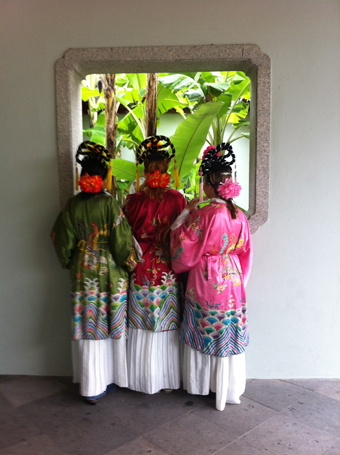
China Heart
photo Damon Girbon
China Heart
Sitting in the Chinese Gardens of Friendship eating yum cha with a pot of tea, we watch Lian and her mother sitting eating yum cha with pots of tea. Then, looking out over the lotus pond, we watch Lian and her beau contemplate the same expanse of water (her father reappears on the surface offering closure). The nature of mobile technology offers the chance to experience the narrative in the exact location where the characters were filmed, and a kind of frisson emerges in the experience, the retelling via iPhone means making connections in real space. A group of teenage girls in magnificent Chinese dress wobble as they balance delicately on stone bridges over the water. At first we think they are the promised Chinese opera performers but as they edge closer, and we take their photo, they point to a sign that directs visitors to where they can play dress-ups and try on traditional outfits.
China Heart seems a starting point for a technology just beginning to emerge—a tourist guide-meets-ficto-historical narrative—that doesn’t quite use the possibilities of the app to full effect. It works more like a school excursion (join the dots; great for children) rather than an integrated media work. It’s a disjointed experience on your feet, but it helps if you revisit the journey online (all the videos and links are available to explore using a regular web browser). The possibilities—for linking histories, documentary, narrative fiction, interaction with users, maps and locations, museum resources, web links—are just starting to open up.
China Heart, writer, director, producer Annette Shun Wah, producer Josephine Emery, presented by d/Lux/MediaArts, 4A Centre for Contemporary Asian Art, the Powerhouse Museum and the Project Factory; Jan 30-Feb 13
You can still do the walking tour by downloading the free app or take the journey online via the China Heart website, www.chinaheart.org.au
This article was first published online April 5, 2011
RealTime issue #102 April-May 2011 pg. web
© Kirsten Krauth; for permission to reproduce apply to realtime@realtimearts.net
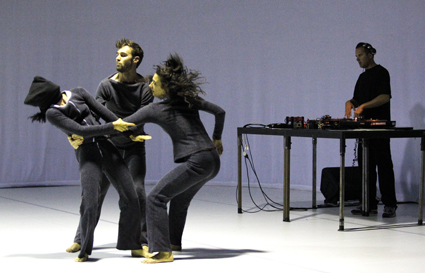
Amplification, BalletLab
photo Jeff Busby
Amplification, BalletLab
DANCE MASSIVE, IN ITS SECOND INCARNATION, AGAIN PROVED TO BE INVALUABLE TO THE GOOD HEALTH OF AUSTRALIAN CONTEMPORARY DANCE, ATTRACTING PASSIONATE AUDIENCES, STRENGTHENING A SENSE OF COMMUNITY AND GENERATING INTENSE DISCUSSION ABOUT THE STATE OF THE ARTFORM AT A TIME WHEN HYBRIDITY RULES.
This unique dance event premieres new works, re-mounts acclaimed productions and invites local and international presenters to consider prospective touring and co-production. This is a dance event that is both marketplace (showing complete works rather than excerpts) and festival. The value for dance artists of seeing and discussing each other’s work cannot be underestimated.
Dance Massive has also commissioned RealTime in 2009 and 2011 to provide detailed responses to all the works in its programs, with some creations being reviewed by two writers or covered again in survey essays, for example on space or sound (p20). As newspaper reviewing declines, as evidenced in shorter and shorter responses, if offered at all, it’s important to have longer estimations of choreographers’ creations, both as documentation and dialogue.
RealTime Editors Virginia Baxter and Keith Gallasch teamed with Melbourne writers Jana Perkovic and Carl Nilsson-Polias to respond to the performances while Associate Editor Gail Priest put our words in print and online and produced the RealTime video interviews with Dance Massive artists. Significantly these interviews were made soon after we’d seen the work—unlike most media interviews that act as previews of works as yet unseen. We look forward to doing many more of these.
It’s of concern that the future of Dance Massive seems uncertain, not least because its cooperative progenitors—Stephen Richardson (Artshouse), Stephen Armstrong (Malthouse) and David Tyndall (Dancehouse)—are all moving on. As Richardson points out in the interview with Sophie Travers (RT101, p36) staging Dance Massive has involved a considerable programming investment from its partners. Dance Massive might not be sustainable for the partners in the future nor match the visions of their incoming directors. Another key event is the Sydney Opera House’s Spring Dance season—its propagator, Wendy Martin, is also on the move.
Australian contemporary dance has long needed a celebratory and analytical focal point, once provided by the Greenmill festivals (1993-97) in Melbourne and intermittently since by Australia’s international arts festivals. The loss of Dance Massive would surrender the opportunity for greater public awareness of dance, vital communication between artists across the country and opportunities for presenters to program innovative dance creations of the highest quality.
A selection of our Dance Massive reviews follows—others can be read on our website where you’ll also find video interviews with dancemakers.
With thanks to the Jasper Hotel and to the Dance Massive partners Arts House, Malthouse and Dancehouse. RT
RealTime issue #102 April-May 2011 pg. 10
© RealTime ; for permission to reproduce apply to realtime@realtimearts.net







































































